Designed by Wingnut Social | Interior Design Business
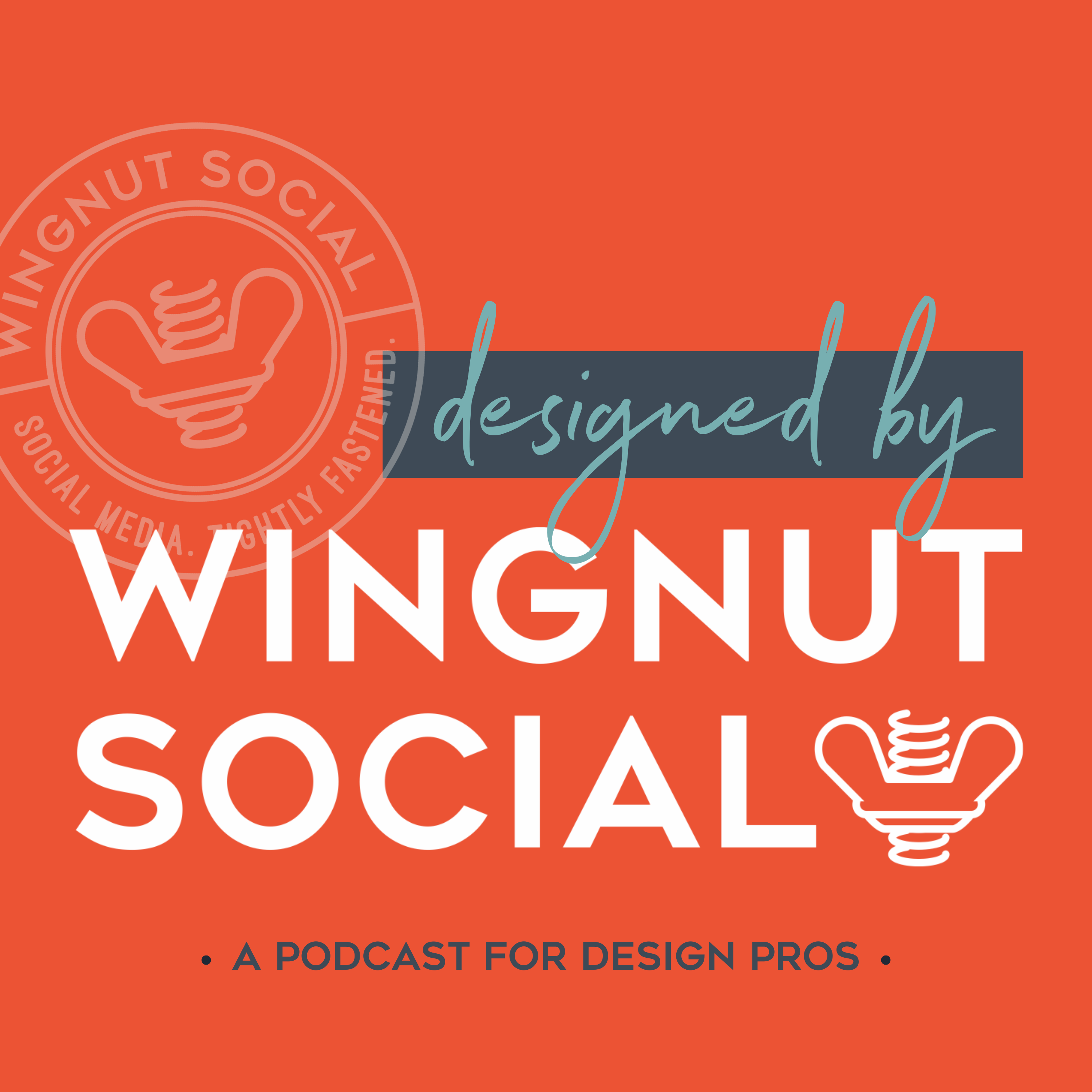
Arts
Business
Darla Powell
The interior design business podcast for interior designers, architects, and home professionals. Hosted by interior design and digital marketing pro, Darla Powell.
#interiordesign

Building Community Through Interior Design (with Maryline Damour & Jennifer Salvemini)
Today we're talking about building community through interior design - spoiler: it's great for your bottom line. Interior designers Maryline Damour and Jennifer Salvemini share some tips on finding your community, building connections, and keeping an open mind when it comes to your career path and growth.
Maryline Damour is a founding partner and principal interior designer of Damour Drake. Her work has been featured in magazines including House Beautiful, Architectural Digest and Elle Decor and on PBS and The Drew Barrymore Show. Maryline is also the founder of the Kingston Design Showhouse, an annual showcase that celebrates Hudson Valley design and connects the design/build industry in the region.
As a student of anthropology and philosophy, Jennifer Salvemini's academics evolved into a passion for aesthetic expression in all areas of culture. She developed an intense appreciation for deep sensory experiences and finds great satisfaction in fostering meaningful experiences for others. Jennifer's professional life straddles careers in hospitality and fashion spanning over 15 years in New York City. She began her interior design practice 5 years ago and has been creating happily in the Catskills ever since.
***
⭐️What does “building community through interior design” even mean?
Today we’re discussing building community through design. What does that mean? As interior designers and entrepreneurs, we often find ourselves living in “business bubbles,” feeling isolated and that we’re constantly reinventing the wheel when starting our businesses. Jennifer explains the goal of community-building is to connect people to each other - makers to makers, builders to makers, designers to makers, designers to builders - to bridge all of these networks and create larger infrastructure, so we can support the individual work of one another while simultaneously creating opportunities for collaboration. When we work together, more interesting products get created. More projects emerge. There are more solutions to problems. And of course…it’s more fun! Plus, collaborating with other creatives and artists can have a positive impact on your local economy.
⭐️How can I build my community and connections without a show house?
Jennifer finds that using Instagram to connect with other locals, whether it be restaurants or building communities or artists, has been wildly successful. What about growing your Instagram? Marilyne says the way to get a million followers is via targeting. If you target the people who are interested, they will amplify the message to others who are interested. Marilyne’s audience has grown by appealing to other creators. By targeting, you can grow your social platform in a way that matters to you and can ultimately feed your business.
⭐️Is it weird to have another interior designer in my community?
It’s important to stay connected with your fellow designers. Marilyne thinks that competition is only a thing if you make it a thing. There are more opportunities when you collaborate, and the market is so diverse in need that your clientele is likely different from that of your collaborators.
***
📲CONNECT with Marilyne:
Website: https://kingstondesignconnection.com/
Instagram: https://www.instagram.com/kingston.design.connection/
📲CONNECT with Jennifer:
Website: https://www.jenniferlsalvemini.com/
Instagram: https://www.instagram.com/jls.lifestyle/
📲CONNECT with Darla:
Darla’s Interior Design Website: https://darlapowell.com/
Instagram: https://www.instagram.com/darlapowellhome/
📚Resources & People Mentioned:
Marilyne's previous episode: https://youtu.be/gEes3uhw7gU
"The Bone People" by Keri Hulme
"Jitterbug Perfume" by Tom Robbins
"A Natural History of the Senses" by Diane Ackerman
🏠FOLLOW Wingnut Social:
Website: http://www.wingnutsocial.com
Facebook: https://www.facebook.com/WingnutSocial/
Twitter: https://twitter.com/wingnutsocial
Instagram: https://www.instagram.com/wingnutsocial/
Wingnut Webinars: https://wingnutsocial.com/webinar
Get Wingnut Academy Updates: https://wingnutsocial.com/wingnut-academy/
🎧SUBSCRIBE to The Wingnut Social Podcast:
Apple Podcasts: https://apple.co/3RJzmtK
Google Podcasts: https://bit.ly/designedongooglepodcasts
TuneIn: https://bit.ly/designedontunein YouTube: https://bit.ly/designedonyoutube
33:2928/09/2022

The New iPhone 14 Pro: Is It Worth It? | Mini News
Are you ready to trade in your iPhone for the brand new iPhone 14 Pro? Listen to this first! Darla is joined by Gavin, an SEO Manager at Wingnut Social, to break down the features of the brand new iPhone 14 Pro, and determine whether or not this is a worthwhile upgrade.
***
📲CONNECT with Darla:
Darla’s Interior Design Website: https://darlapowell.com/
Instagram: https://www.instagram.com/darlapowellhome/
🏠FOLLOW Wingnut Social:
Website: http://www.wingnutsocial.com
Facebook: https://www.facebook.com/WingnutSocial/ Twitter: https://twitter.com/wingnutsocial
Instagram: https://www.instagram.com/wingnutsocial/
Wingnut Webinars: https://wingnutsocial.com/webinar
Get Wingnut Academy Updates: https://wingnutsocial.com/wingnut-academy/
🎧SUBSCRIBE to The Wingnut Social Podcast:
Apple Podcasts: https://apple.co/3RJzmtK
Google Podcasts: https://bit.ly/designedongooglepodcasts
TuneIn: https://bit.ly/designedontunein YouTube: https://bit.ly/designedonyoutube
11:3926/09/2022
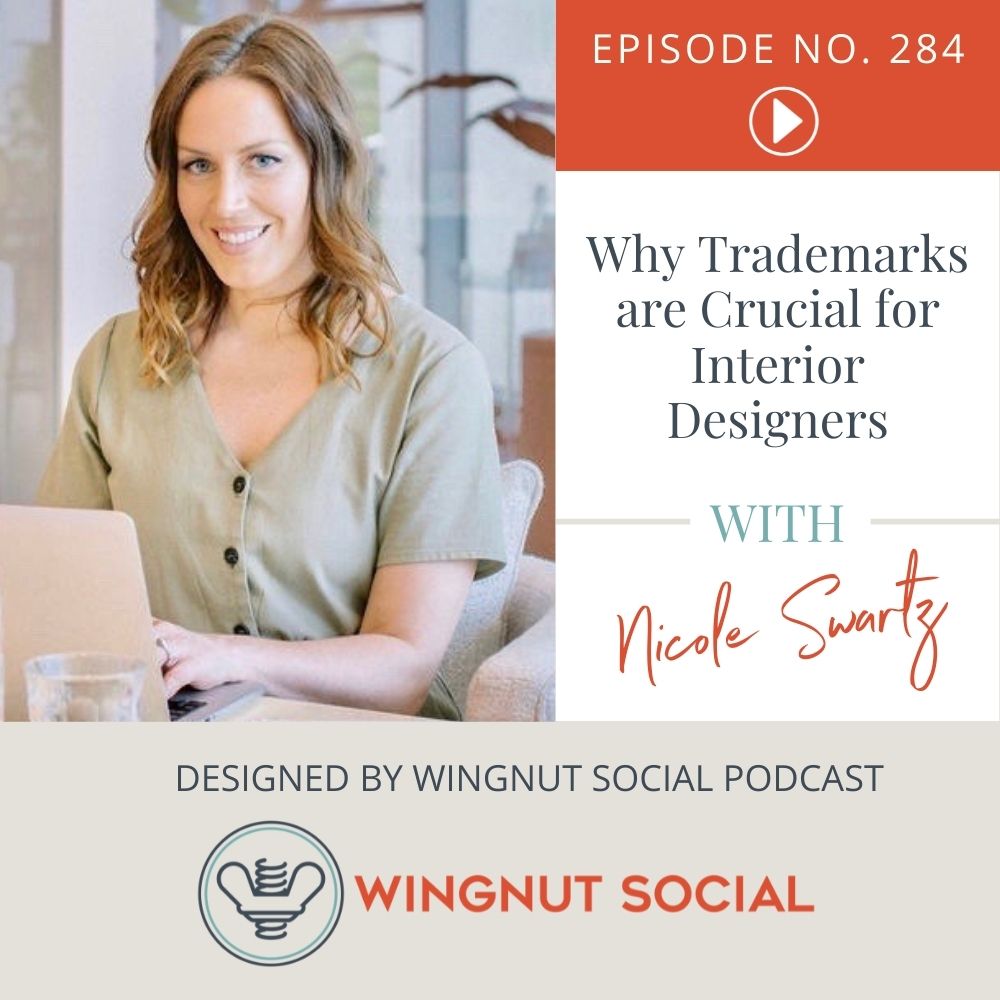
Why Trademarks are Crucial for Interior Designers (with Nicole Swartz)
Do you need to worry about trademarks if you're an interior designer? Attorney Nicole Swartz (Sprout Law) shares all the secrets about the trademarking process, costs, and what to do if you find someone using your brand name online.
Nicole Swartz is the attorney behind Sprout Law, a law firm for women business owners. In 2015, she started a skincare line that was featured in hundreds of stores around the world and the Golden Globes giftbags. After two years, she had to rebrand the business because she didn't have a trademark. Now, she helps other women trademark their brands to avoid the same situation. Nicole is featured as an expert in Forbes, the Washington Post, Girlboss, and speaks at events like Alt Summit and SXSW.
***
📲CONNECT with Nicole:
Website: https://www.sproutlaw.com/
Instagram: www.instagram.com/sproutlaw
📲CONNECT with Darla:
Darla’s Interior Design Website: https://darlapowell.com/
Instagram: https://www.instagram.com/darlapowellhome/
📚Resources & People Mentioned:
"Unleash Your Inner Money Babe" by Kathrin Zenkina
🏠FOLLOW Wingnut Social:
Website: http://www.wingnutsocial.com
Facebook: https://www.facebook.com/WingnutSocial/
Twitter: https://twitter.com/wingnutsocial
Instagram: https://www.instagram.com/wingnutsocial/
Wingnut Webinars: https://wingnutsocial.com/webinar
Get Wingnut Academy Updates: https://wingnutsocial.com/wingnut-academy/
🎧SUBSCRIBE to The Wingnut Social Podcast:
Apple Podcasts: https://apple.co/3RJzmtK
Google Podcasts: https://bit.ly/designedongooglepodcasts
TuneIn: https://bit.ly/designedontunein
YouTube: https://bit.ly/designedonyoutube
30:1321/09/2022
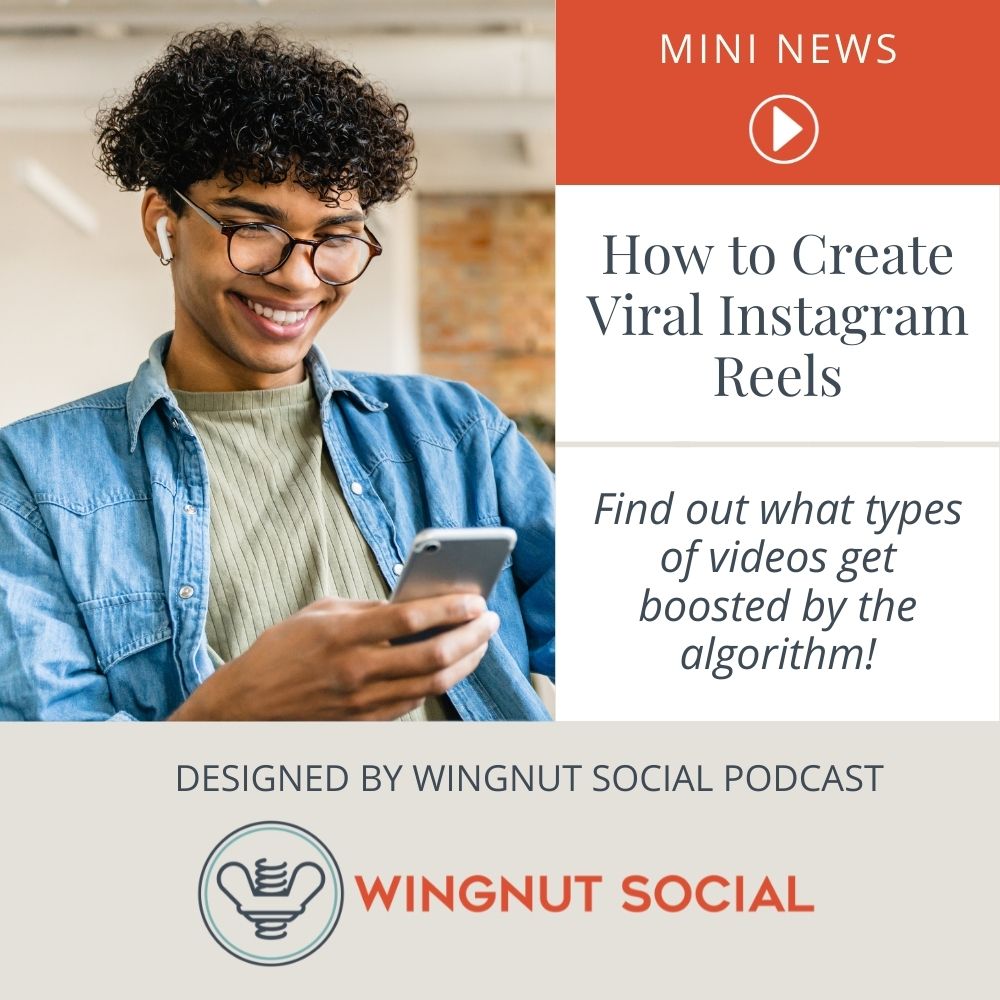
How to Create Viral Instagram Reels | Mini News
Emily is joined by Gavin, an SEO Manager at Wingnut Social, to discuss best practices for Instagram Reels and what types of videos get boosted by Meta's algorithm.
***
📲CONNECT with Darla:
Darla’s Interior Design Website: https://darlapowell.com/
Instagram: https://www.instagram.com/darlapowellhome/
🏠FOLLOW Wingnut Social:
Website: http://www.wingnutsocial.com
Facebook: https://www.facebook.com/WingnutSocial/ Twitter: https://twitter.com/wingnutsocial
Instagram: https://www.instagram.com/wingnutsocial/
Wingnut Webinars: https://wingnutsocial.com/webinar
Get Wingnut Academy Updates: https://wingnutsocial.com/wingnut-academy/
🎧SUBSCRIBE to The Wingnut Social Podcast:
Apple Podcasts: https://apple.co/3RJzmtK
Google Podcasts: https://bit.ly/designedongooglepodcasts
TuneIn: https://bit.ly/designedontunein YouTube: https://bit.ly/designedonyoutube
08:0019/09/2022
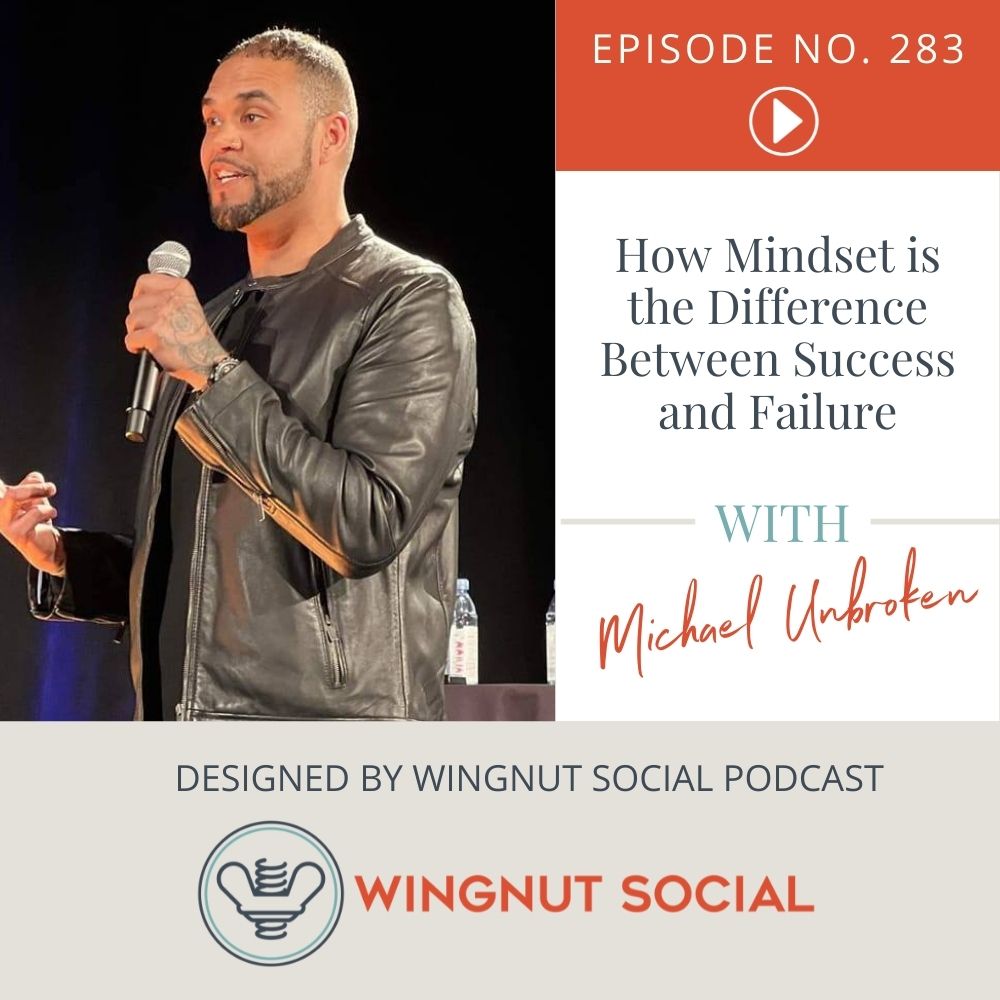
How Mindset is the Difference Between Success and Failure (with Michael Unbroken)
Mindset is the difference between success and failure in life and business. Trauma coach Michael Unbroken is here to discuss overcoming your trauma, how your trauma impacts you as a business owner, and the importance of investing in mentorship (and yourself).
From homeless to hero, with an ACE Score of TEN, Michael Unbroken found his way from stuck, hurt, and broken to being THE HERO of his own story. Today, Michael has coached thousands of Trauma Warriors around the world to learn to love themselves, get unstuck and to BE UNBROKEN. Michael is the author of the best-selling book Think Unbroken and is a coach, mentor, and educator for adult survivors of child abuse.
***
📲CONNECT with Michael:
Website: https://www.thinkunbrokenacademy.com
Instagram: @MichaelUnbroken
📲CONNECT with Darla:
Darla’s Interior Design Website: https://darlapowell.com/
Instagram: https://www.instagram.com/darlapowellhome/
📚Resources & People Mentioned:
“Radical Acceptance: Embracing Your Life With the Heart of a Buddha” by Tara Brach
🏠FOLLOW Wingnut Social:
Website: http://www.wingnutsocial.com
Facebook: https://www.facebook.com/WingnutSocial/
Twitter: https://twitter.com/wingnutsocial
Instagram: https://www.instagram.com/wingnutsocial/
Wingnut Webinars: https://wingnutsocial.com/webinar
Get Wingnut Academy Updates: https://wingnutsocial.com/wingnut-academy/
🎧SUBSCRIBE to The Wingnut Social Podcast:
Apple Podcasts: https://apple.co/3RJzmtK
Google Podcasts: https://bit.ly/designedongooglepodcasts
TuneIn: https://bit.ly/designedontunein
YouTube: https://bit.ly/designedonyoutube
38:0914/09/2022
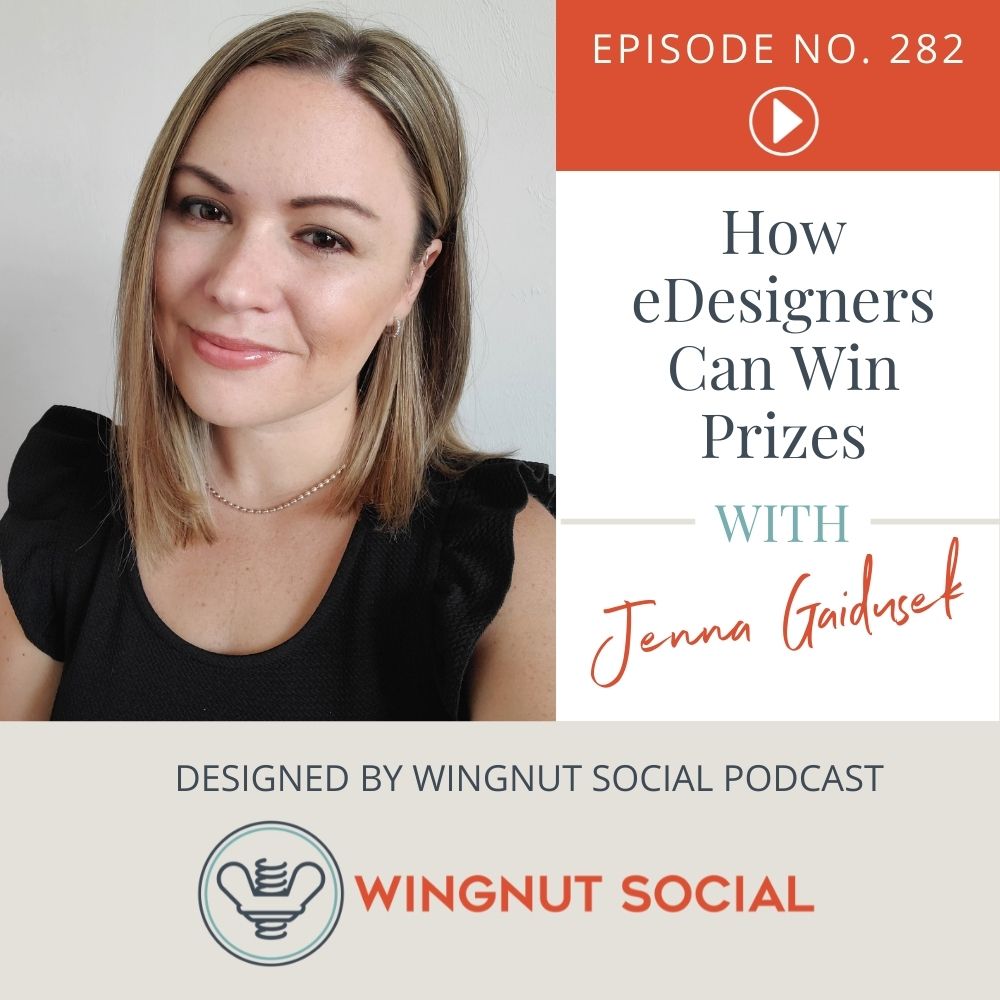
How eDesigners Can Win Prizes (with Jenna Gaidusek) - Bonus Episode 282
Do you want to win some prizes with your sick eDesign skills? Jenna Gaidusek (Mydoma/Edesign Tribe) is in the studio today to discuss Mydoma's Designer Virtual Home Tour Contest. Interior designers can enter for a chance to win thousands of dollars worth of prizes, including a trip to HPMKT Spring 2023! You can enter the contest here.
Jenna is an interior designer that has worked remotely since 2016 in her business Jenna Gaidusek Designs. She is also the founder of the eDesign Tribe community on Facebook as well as eDesign u and the eDesign Platform- recently acquired by Mydoma studio. Jenna is now the director of education and community for Mydoma studio bringing design professionals together and providing educational tools and resources to help them expand their business in a way that works best for their lifestyle.
***
What You’ll Hear On This Episode of Wingnut Social:
[0:00] - Jenna Gaidusek is here - again?!
[1:49] - The origin story of eDesign Tribe
[3:39] - Jenna's one stop shop for project management, eDesign, and education
[6:23] - Electronic design is becoming the new normal
[8:26] - The Designer Virtual Home Tour Contest (powered by Mydoma)
[11:12] - The benefits of electronic design and visualizers
[11:57] - How to enter the contest for a chance to win thousands of dollars worth of prizes
[12:56] - Free learning opportunities with Mydoma
[14:37] - The What Up Wingnut Round!
[16:03] - Get a free trial with Mydoma and enter the contest
***
📲CONNECT with Jenna Gaidusek:
Website: https://www.mydomastudio.com/vhometour/
Jenna's Instagram: https://www.instagram.com/jenna.gaidusek/
Mydoma's Instagram: https://www.instagram.com/mydoma/
eDesign Tribe Facebook Group: https://www.facebook.com/groups/eDesignTribe/
📲CONNECT with Darla:
Instagram: https://www.instagram.com/darlapowellhome/
📚Resources & People Mentioned:
Ubersuggest: https://app.neilpatel.com/en/ubersuggest/
Enter The Designer Virtual Home Tour Contest: www.mydomastudio.com/vhometour
🏠FOLLOW Wingnut Social:
Website: http://www.wingnutsocial.com
Facebook: https://www.facebook.com/WingnutSocial/
Twitter: https://twitter.com/wingnutsocial
Instagram: https://www.instagram.com/wingnutsocial/
Wingnut Webinars: https://wingnutsocial.com/webinar
Get Wingnut Academy Updates: https://wingnutsocial.com/wingnut-academy/
🎧SUBSCRIBE to The Wingnut Social Podcast:
Apple Podcasts: https://apple.co/3RJzmtK
Google Podcasts: https://bit.ly/designedongooglepodcasts
TuneIn: https://bit.ly/designedontunein
YouTube: https://bit.ly/designedonyoutube
17:3212/09/2022
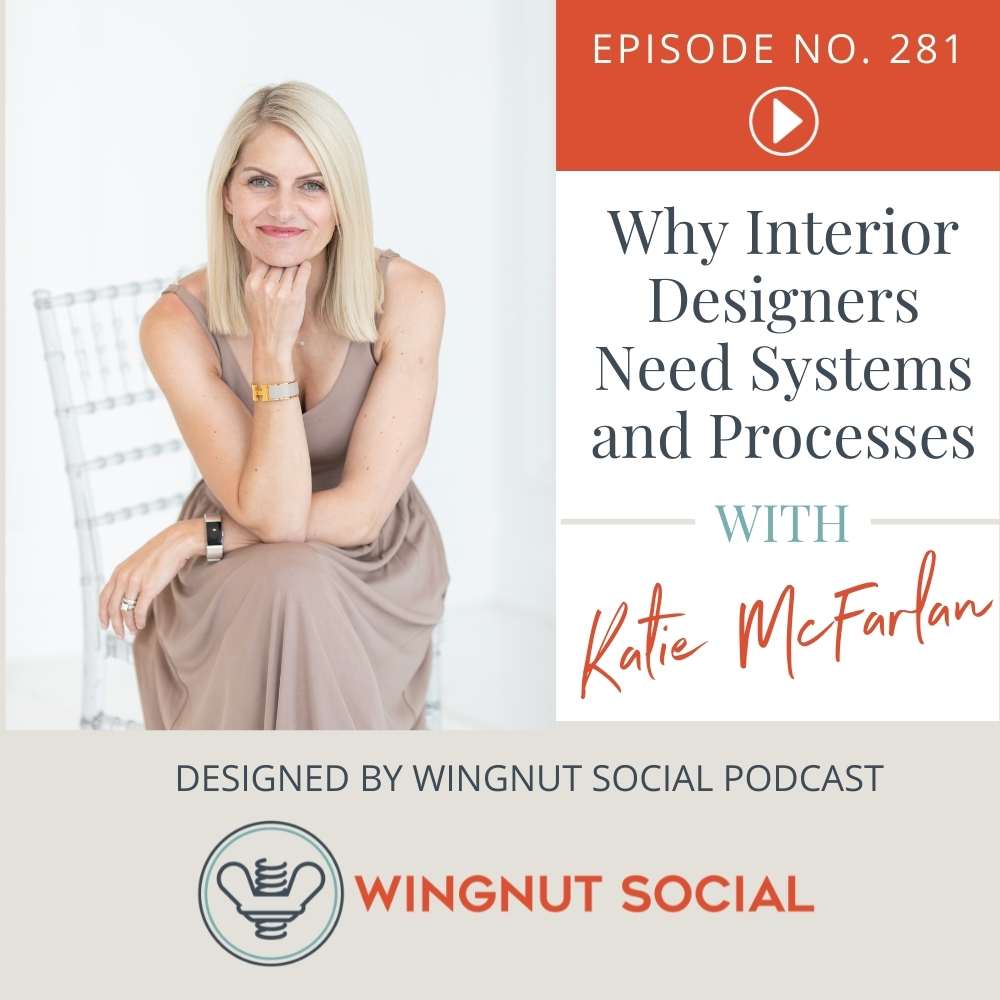
Why Interior Designers Need Systems and Processes - Episode 281
You want to deliver an exceptional experience for your clients, right? So, what has to happen on the back end to make it happen? Systems and processes. You need to craft standard operating procedures. When you’re familiar with your foundational processes you’ll make informed decisions for the rest of your company.
You’ll be able to walk your client through your process (including how long the project will take). When you have standardized systems and processes in place so that you can do this, it will help you build relationships and trust with your clients.
Katie McFarlan is the owner of Dakota Design Company, where she helps her clients refine, streamline, and simplify business processes and systems so they can grow in a sustainable way. She shares how she builds systems and processes in this episode of Wingnut Social!
What You’ll Hear On This Episode of Wingnut Social
[1:12] Housekeeping: Wingnut Webinar!
[1:58] Mini News Sesh: Instagram’s pinned comments
[4:35] Katie McFarlan and Dakota Design Co.
[6:21] Why you need systems and processes
[7:59] The depth and scope of systems and processes
[10:33] How to develop systems and processes
[16:02] What happens when you break your rules
[19:03] Here’s where you should get started
[22:58] Why SOPs are important for solopreneurs, too
[25:39] The importance of project management software
[30:31] Scale your business with software—or a team
[32:00] The What Up Wingnut Round!
[36:24] Blooper Reel!
Connect with Katie McFarlan
Dakota Design Co.
Connect on Instagram
Resources & People Mentioned
Calendly
Acuity
ClickUp™
Trello
Asana
DesignFiles
Ivy by Houzz
Giftology
The Pumpkin Plan
The depth and scope of systems and processes
Creativity and design are part of the process—but a small part of what a business owner has to do every day. So Katie talks about the client-facing steps of the process as well as the back-end side of what happens in each phase (for the designer, designer’s team, and clients).
Systems and processes can help you scale your business properly. Once you document your processes, you can identify opportunities to make each phase of your process better. You can see where you need to be more efficient, where you can delegate, and more.
Here’s where you should get started
Katie believes that developing systems and processes comes down to how you work and what services you deliver. You can structure services a million different ways but it HAS to work for you.
Once you choose a structure for your services, then focus on industry best practices for screening leads, onboarding clients, and delivering results (design discovery, how you design, presentations, etc.).
If you’re spinning your wheels and getting overwhelmed, write everything down:
What does your inquiry phase look like? What happens step-by-step? Do you send an email? Do they book a call?
What is your onboarding process? What do you do for a new client? What do you need from them? What can they expect from you? How long does this phase take?
What does the design phase look like? How do you go from concept to final design? Do you offer order management? Project management? Construction management?
How do you install? What is the offboarding process? Do you ask them for a review?
Every designer and what they offer is different. But the way you deliver services can fall into these categories. Writing everything out helps you map out the process and how long it will take so you can inform your clients.
After you map out your phases, look at where there’s confusion, pushback, and overwhelm. Identify where the challenges are. That’s where something needs to change.
Katie believes that every designer needs project management software. Tune in to this episode to hear what she recommends to keep your business on track!
Connect With Darla & Wingnut Social
www.WingnutSocial.com
On Facebook
On Twitter: @WingnutSocial
On Instagram: @WingnutSocial
Subscribe on YouTube
Darla’s Interior Design Website
Check out the Wingnut Social Media Lab Facebook Group!
786-206-4331 (connect with us for your social media marketing needs)
Subscribe to The Wingnut Social Podcast on iTunes, Google Podcasts, or TuneIn
Audio Production and Show notes by
PODCAST FAST TRACK
https://www.podcastfasttrack.com
36:4307/09/2022

Goal-Setting Strategies for Interior Designers - Episode 280
Andrea Liebross has started three successful businesses and ultimately became a certified business and life coach. Her goal is to help bold and ambitious women create their own custom secret sauce for success by combining mindset and systems. In this episode of Wingnut Social, Andrea helps nail down some goal-setting strategies for interior designers. Don’t miss it!
What You’ll Hear On This Episode of Wingnut Social
[1:07] Housekeeping: Wingnut Webinars and Wingnut Academy
[2:07] Mini News Sesh: Pinterest releases a new collage app
[6:37] Learn more about Andrea Liebross and her business
[9:09] Shiny object syndrome: Why you need to focus on your wheelhouse
[13:28] What is the importance of goal-setting in your business?
[22:02] How Andrea helps clients remain consistent to reach their goals
[26:38] How do you know when you can pay attention to a shiny object?
[30:36] Why Andrea likes to layer in risky goal-setting
[33:24] Why making confident decisions will 10x your results
[36:06] The What Up Wingnut Round!
[40:10] Blooper Reel!
Connect with Andrea
Andrea Liebross Coaching
Take the quiz on Andrea’s website
Andrea’s podcast: Time to Level Up
Follow Andrea on Instagram
Resources & People Mentioned
Essentialism: The Disciplined Pursuit of Less
Shiny object syndrome: Why you need to focus on your wheelhouse
Andrea has a client that’s an interior designer. They’ve been working together for 18 months and her business has doubled. This client loves a brand of exercise clothes sold directly to customers and asked Andrea if she thought it was okay if she got her foot in the door with network marketing.
She thought it would be fun and exciting. But what about her business? Isn’t that fun and exciting? So Andrea asked her, “What if we just stick with that?” People are looking for fun, exciting, new, and adventurous. That is the trap of shiny object syndrome.
Andrea helped her focus on the three-year vision for her business. Then they got even more granular and focused on what she needed to do this quarter. However, Andrea believes that your goals need an element of shiny object syndrome built into them. Why? To give you the excitement you’re craving. Listen to find out what that could look like.
Goal-setting strategies for interior designers
You need to set goals that are specific, measurable, achievable, relevant, time-bound, AND exciting and risky (the SMART-ER framework). If you believe in those goals, they can ground you. They can also prevent you from constantly stumbling over roadblocks. Goals are your priorities that are written down so that you can plan from and schedule your time around.
How specific should you be with goal setting? Andrea believes that goals should be broken down quarterly, monthly, weekly, and daily. Start with what you’re doing today. Andrea is a believer in the “Big Three.”
What are the three things that you’re going to do today that get you a step closer to your goals? The key is that they need to be things you have some resistance to. It may be reaching out to a client, closing a deal, or sourcing something that’s been impossible to find.
Those three things must align with your ultimate revenue goal and impact your bottom line. The goals are your north star. The big three ground you every day. Then you can plan out your week with a weekly big three. What do you want to happen that won’t happen automatically?
Why is it so important to write it down? What’s the best way to track your goals? Listen to hear Andrea’s thoughts.
How Andrea helps clients remain consistent to reach their goals
Action and inaction are driven by how we feel. You might feel stressed or anxious. Writing down a list of tasks may be the last thing you want to do. You have so many things to do that you just want to get going. What do you want to happen? How do you want to feel at the end of the day? What do you want to have accomplished?
Everyone wants everything on their list checked off. If you write things down at the beginning of the day and decide what to work on, you’ll get more done. You have to focus on the endgame to take the initial action.
Are you doing the things on your list that have the most impact? Do they align with where you want to be? Your brain likes the hit of dopamine when you knock out the easy things. When you do that, your brain thinks you’re being productive when you’re not.
Why aren’t you writing down what you should be doing? Andrea shares 3 common reasons. Listen to find out what they are!
Connect With Darla & Wingnut Social
www.WingnutSocial.com
On Facebook
On Twitter: @WingnutSocial
On Instagram: @WingnutSocial
Subscribe on YouTube
Darla’s Interior Design Website
Check out the Wingnut Social Media Lab Facebook Group!
786-206-4331 (connect with us for your social media marketing needs)
Subscribe to The Wingnut Social Podcast on iTunes, Google Podcasts, or TuneIn
Audio Production and Show notes by
PODCAST FAST TRACK
https://www.podcastfasttrack.com
40:2831/08/2022
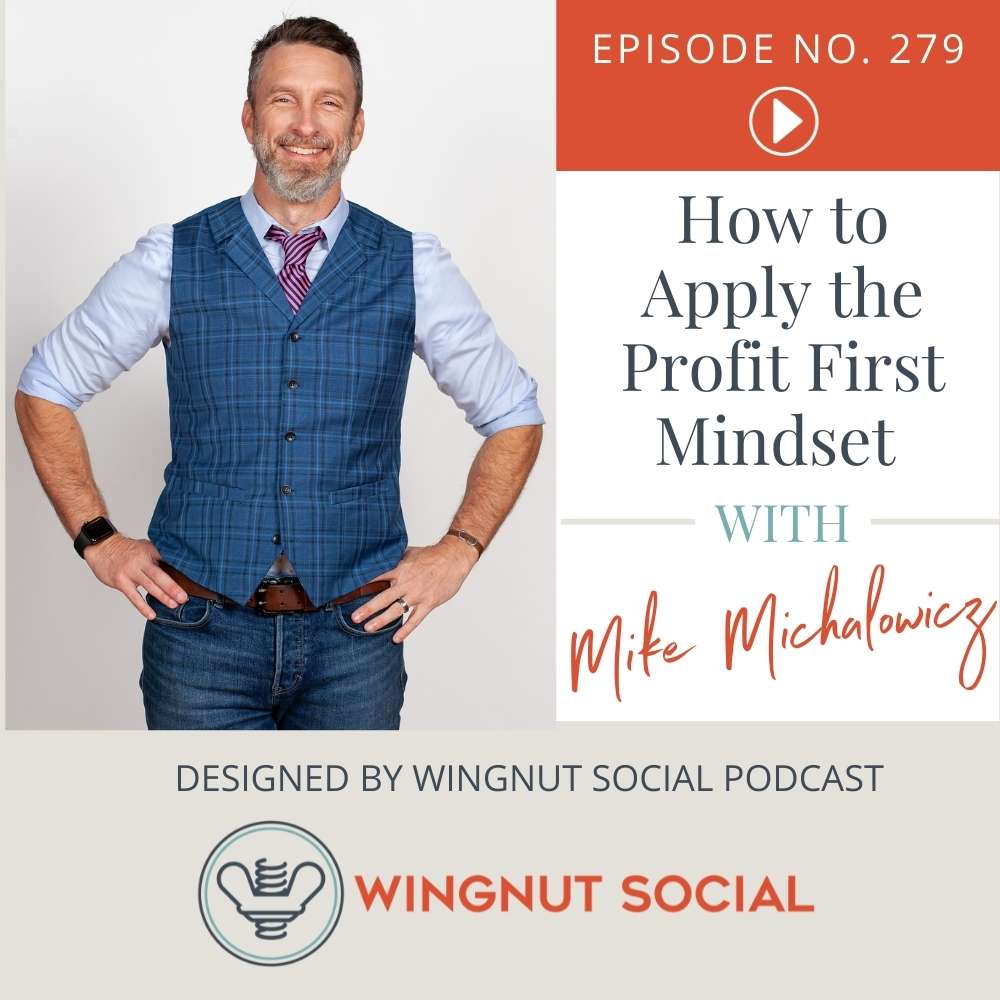
How to Apply the Profit First Mindset with Mike Michalowicz - Episode 279
This isn’t the first time Darla’s talked about Mike Michalowicz’s Profit First formula (and how interior designers can apply it in their business). But this IS the first time she’s had a conversation with the man himself!
If you don’t know who he is, Mike Michalowicz is the author of The Pumpkin Plan, Clockwork, Fix This Next, Get Different, and a Wingnut favorite—Profit First. In this episode of Wingnut Social, he shares how you can flip the script and turn your business into a money-making machine.
What You’ll Hear On This Episode of Wingnut Social
[0:45] Housekeeping: Wingnut Webinars + Wingnut Academy Updates
[1:32] Mini News Sesh: LinkedIn is testing link stickers
[3:26] Learn more about Mike Michalowicz
[5:16] The story behind the first cover of Profit First
[9:10] Why entrepreneurs struggle to make a profit
[11:21] The pay yourself first principle applied to business
[13:55] What happens if your business is carrying debt?
[16:12] The optimal number to contribute to profit
[18:00] Generally Accepted Accounting Principles (GAAP)
[20:45] Using tacking to make quarterly adjustments
[25:06] How service-based industries should grow
[28:10] Why you should work with a Profit First coach
[30:13] The What Up Wingnut Round!
Connect with Mike Michalowicz
Check out Mike’s Website
Clockwork, Revised and Expanded
Resources & People Mentioned
Younger Next Year
Profit First for Interior Designers
Creating a Sustainable Design Business through Profit First
Record your podcast episodes on Riverside
Why entrepreneurs struggle to make a profit
Cyril Northcote Parkinson studied human behavior. His thesis was that as supply increases in availability, consumption increases. If Mike is given one chocolate chip cookie, he’ll eat it. If 20+ chocolate chip cookies are placed in front of him, he’ll likely eat more than one because the supply has changed. The same is true for money. When there’s more available, there’s more to spend.
It becomes a trap. Many businesses make tens of millions of dollars but are still struggling to get by because the more they make, the more they spend. They see money in the bank account and go, “Finally, I can do X, Y, Z.” Parkinson also points out that if you constrain supply, you can force frugality. You also become more innovative. You find ways to stretch it. When you have one cookie to eat, you savor it. When there’s less money available to spend, you’re more selective with how you spend it.
The pay yourself first principle applied to business
If you take a portion of your income and put it toward savings, you will have a future of savings. Why not apply that to business? The first thing you do is allocate money to profit. With Profit First, the equation is sales minus profit equals expenses. Money comes in, you take profit, and then you know what’s truly left available for expenses.
Profit isn’t an event or eventuality. Profit is a habit. When money comes in, take a portion and allocate it toward profit. You use the profit to pay yourself first. You preallocate money to its intended use. It’s a mindset shift. When you see what money’s intended use is before you spend it, you work within the confines of that.
How do you operate if your business has debt? Listen to hear Mike’s thoughts!
Using tacking to make quarterly adjustments
What is your five or ten-year vision? What can you do in the next 90 days to best get there? Tacking is a strategy that’s used by sailors. The boat has a desired destination. But you can’t go in a straight line to get there because you have to take advantage of the winds. So sailboats zigzag to capture the wind to get to their destinations.
Businesses are the same. You don’t beeline straight to the end goal. Obstacles, like the economy, will present challenges. So take things one quarter at a time. What are the biggest movements you can make in your business to get to your end goal?
You also have to get into a quarterly rhythm of distributions. The only way you can grow is with fiscal discipline. The #1 rule of publicly-traded companies is to distribute profit to shareholders every quarter. They do that to maintain engagement and award risk-takers. Your business needs to follow the same pattern. It keeps you emotionally engaged in your business.
Why shouldn’t you re-invest your profit? Why should you work with a Profit First coach? Listen to learn why!
Connect With Darla & Wingnut Social
www.WingnutSocial.com
On Facebook
On Twitter: @WingnutSocial
On Instagram: @WingnutSocial
Subscribe on YouTube
Darla’s Interior Design Website
Check out the Wingnut Social Media Lab Facebook Group!
786-206-4331 (connect with us for your social media marketing needs)
Subscribe to The Wingnut Social Podcast on iTunes, Google Podcasts, or TuneIn
Audio Production and Show notes by
PODCAST FAST TRACK
https://www.podcastfasttrack.com
35:0024/08/2022
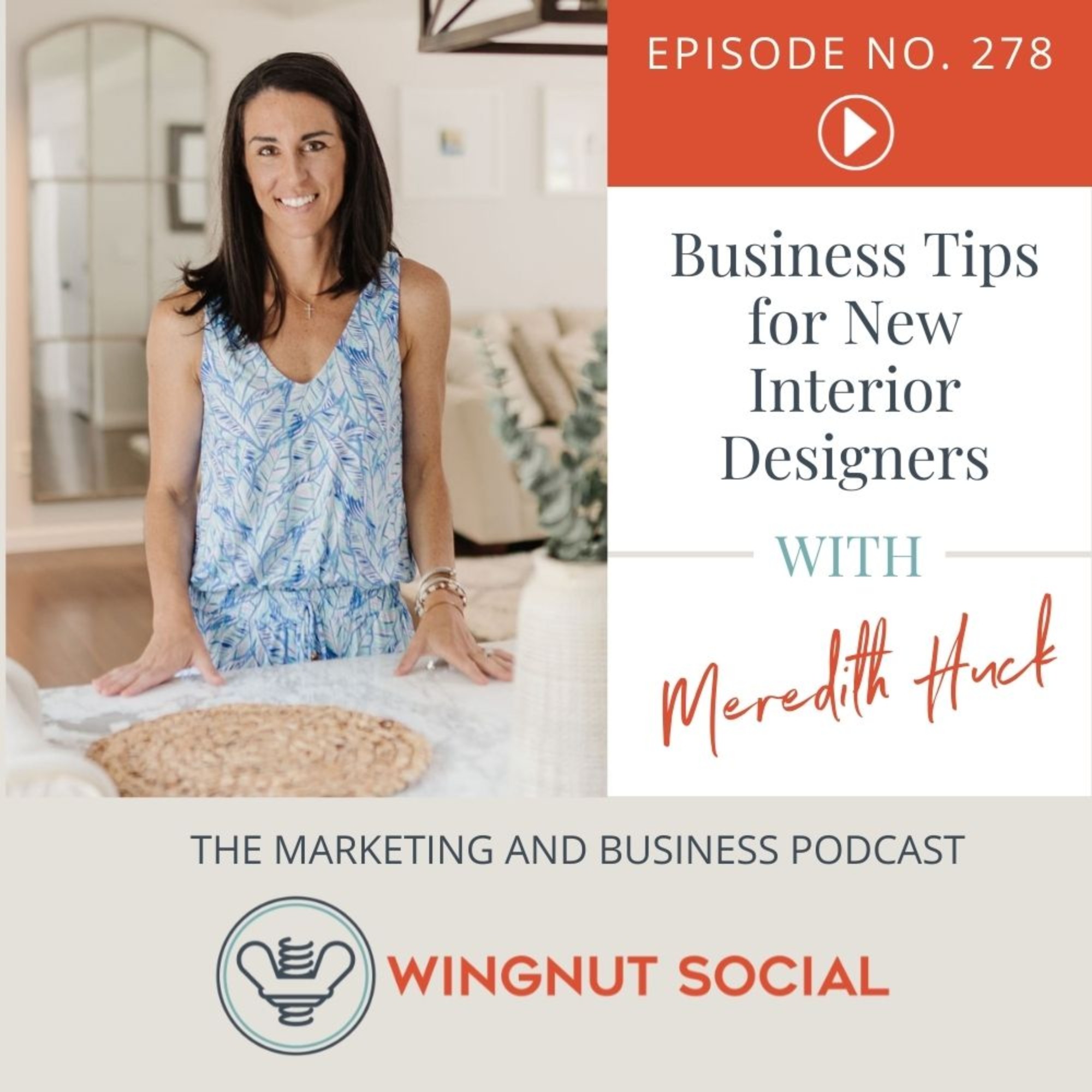
Business Tips for New Interior Designers - Episode 278
Meredith founded the “House of Huck” in 2020 as a passion project. She gave herself an ultimatum: If she wasn’t successful in three years, she’d go back to the corporate world. But in one year, she transformed her business into a full-time career.
She’s leveraged her unique background in corporate sales—and some genius social media marketing tactics—to build a thriving business. In this episode of Wingnut Social, Meredith shares some business tips for new interior designers that you just can’t miss!
What You’ll Hear On This Episode of Wingnut Social
[1:16] Wingnut Webinar: Let’s Get Real About Reels
[2:56] Mini News Sesh: Native scheduling on Instagram
[5:06] Learn all about Meredith Huck and the House of Huck
[11:08] Marketing House of Huck on social media
[18:03] When Meredith sought out an interior design coach
[20:43] How Meredith handles pricing and fees
[23:22] Why Meredith doesn’t want to grow and scale a team
[28:13] Business tips for new interior designers
[35:55] The What Up Wingnut! Round
[41:10] Blooper Reel!
Connect with Meredith Huck
House of Huck
Connect on Instagram
Resources & People Mentioned
Wingnut Webinar Aug 25, 2022 11:00 AM: Let’s Get Real About Reels
Profit First by Mike Michalowicz
Dakota Design Co.
The Brownstone Boys
Record your podcast episodes on Riverside
Why House of Huck grew quickly
95% of Meredith’s clients have come from social media. How does she leverage various platforms to gain visibility?
Meredith got in front of the camera. It allowed people to learn about herself and her life. She also embraced a unique social media marketing strategy: Throwing a scavenger hunt.
Meredith chose 5 local businesses, bought gift cards, and hid them around town. You had to follow her on social media and answer a riddle to find the gift card(s). Once someone found one, they had to tag her in a post.
She gained followers, gave back to her community, and it even led to a request for a design consultation.
Why Meredith doesn’t want to grow and scale a team
Meredith is struggling with a great problem to have: Getting too many requests for her design services. She’s learning how to take discovery calls, explaining how her process works, and scheduling out (sometimes weeks or months).
She sets the expectation that it may be weeks before she can connect back to work on their project. But then she communicates via email, notes in the mail, etc. She’ll have those clients work on creating a Pinterest board to fill in the gap during those weeks.
Meredith is busier than ever, but she isn’t interested in growing and scaling a team right now. She loves what she does and chooses to outsource when necessary. She works with a virtual assistant and outsources renderings and sourcing tasks.
Business tips for new interior designers
What has Meredith learned from her first couple of years as a new interior designer?
Tip #1: It’s not just about charging a design fee. Whenever you can, open up wholesale accounts and purchase furnishings directly from them. A large portion of Meredith’s revenue has come from the margin she makes on furnishings.
Tip #2: Trust your gut. Meredith agreed to do some design work for a couple despite seeing numerous red flags. Meredith requires her clients to request revisions within one week of her design presentation. After her design presentation, this client asked for more than a week to decide. Two months later, they asked her for a refund of her design fees.
Tip #3: Don’t take every job that comes your way. Only work with people who appreciate what you’re doing for them.
Meredith shares more tips, tricks, and business strategies in this episode of Wingnut Social. Check it out!
Connect With Darla & Wingnut Social
www.WingnutSocial.com
On Facebook
On Twitter: @WingnutSocial
On Instagram: @WingnutSocial
Subscribe on YouTube
Darla’s Interior Design Website
Check out the Wingnut Social Media Lab Facebook Group!
786-206-4331 (connect with us for your social media marketing needs)
Subscribe to The Wingnut Social Podcast on iTunes, Google Podcasts, or TuneIn
Audio Production and Show notes by
PODCAST FAST TRACK
https://www.podcastfasttrack.com
41:5617/08/2022
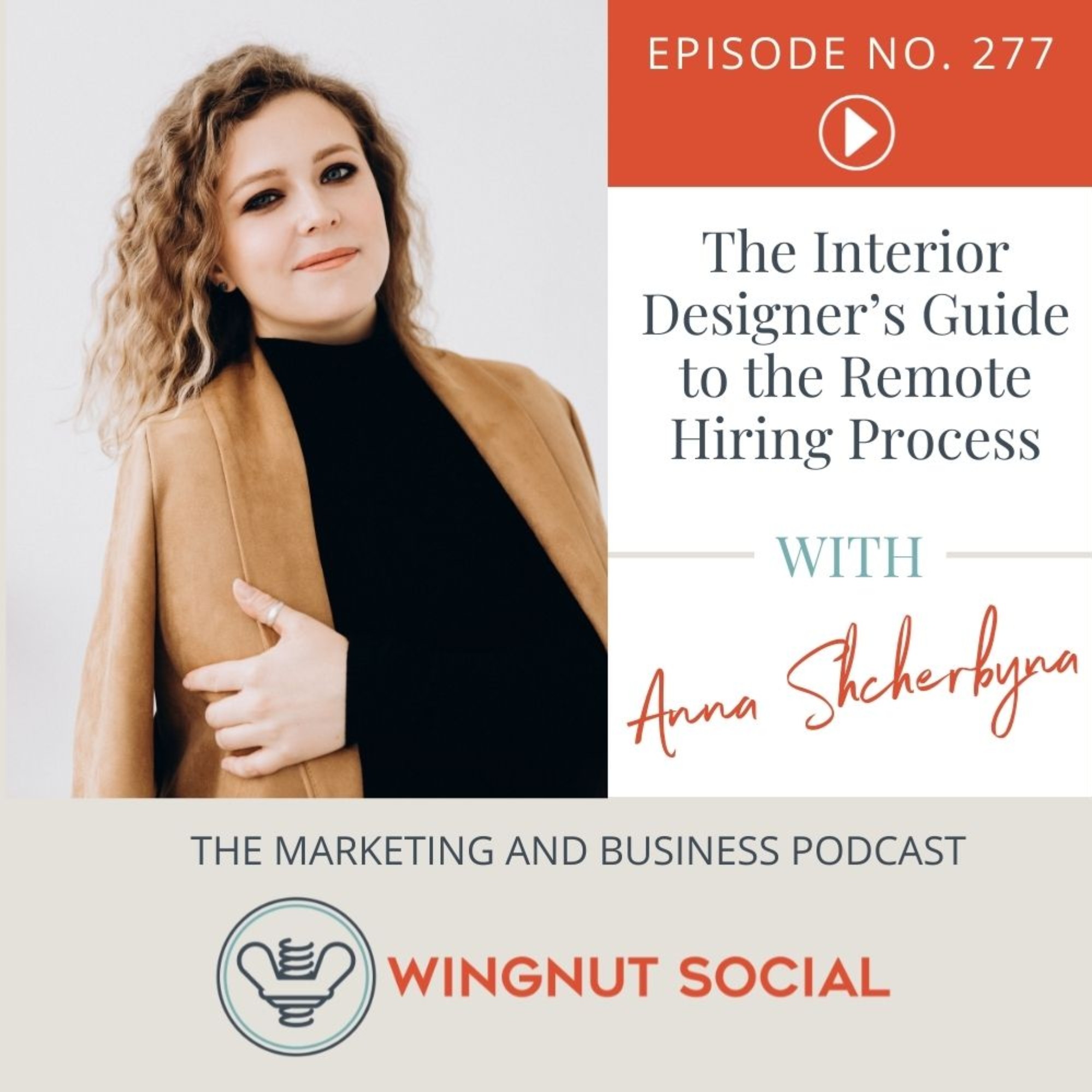
The Interior Designer’s Guide to the Remote Hiring Process - Episode 277
How do you navigate the remote hiring process for your interior design business? What should you include in the interview process? How do you retain a remote team once you hire them? Anna Shcherbyna joins Darla in this episode of Wingnut Social to tackle these questions head-on.
Anna Shcherbyna has over 10 years of experience in international operations and recruitment. She is the CEO of Remotivate, a recruitment agency that helps remote-friendly companies hire top remote management and leadership via a done-for-you service. Don’t miss her expert insight!
What You’ll Hear On This Episode of Wingnut Social
[1:24] Housekeeping: Wingnut Webinar Announcement
[2:25] Subscribe to Designed by Wingnut Social on YouTube!
[2:52] Mini News Sesh: How to Boost Instagram Reels
[6:55] Learn all about Anna Shcherbyna
[8:30] How the pandemic accelerated remote hiring
[12:03] The best places to hire remote employees
[14:00] What to look for in a remote candidate
[16:41] How to screen candidates remotely
[22:27] The advantages of hiring internationally
[26:49] How remote hiring can apply to designers
[28:43] How to nail the remote hiring process
[32:32] Ways you can retain your remote employees
[34:48] The What Up Wingnut! Round
Connect with Anna Shcherbyna
Remotivate
Book a demo call with Anna!
Connect by email at [email protected]
Connect with Anna on LinkedIn
Resources & People Mentioned
August 24th at 11 am: Wingnut Webinar on Instagram Reels
VideoAsk
Remote
CliftonStrengths (formerly StrengthsFinder)
The Untethered Soul by Michael A. Singer
Record your podcast episodes on Riverside
Why hire a remote workforce?
As of early 2022, 50% of applicants on LinkedIn have been for remote jobs, but only 20% of the jobs posted are actually remote. The #1 reason why candidates are applying for new jobs is because they’re being forced back into the office. Why are employers still resistant to remote work?
Anna points out that when people work remotely, productivity goes up, flexibility goes up, happiness goes up, and morale goes up. But the one thing that you do lose out on is that quickness of communication.
How to screen candidates remotely
Anna recommends that you screen for soft skills. It isn’t just about experience anymore. You can’t just look at someone’s resume and LinkedIn profile and determine if someone is a good fit. You need to look for a hunger to learn, time and effort, independence and drive, and someone who is self-motivated.
Obviously, you still want to screen candidates to make sure they’re a good fit for the position you’re hiring for. To do this, Anna loves using VideoAsk. You can see if a candidate is comfortable on camera and better assess their passion and interest in the role.
Anna also recommends using some personality tests (DiSC and Clifton Strengths, which was formerly StrengthsFinder). CliftonStrengths asks direct questions, such as what you enjoy—and what you don’t—and how you act in different scenarios. It’s harder for you to answer questions from the lens of what you think the potential employer wants.
Lastly, she always recommends a test project that is actionable and strategically related to the position being hired for. Give them an actual scenario you’re facing within your business and ask them how they’d resolve it. What steps would they take? Have them create a strategic plan.
What are the advantages of hiring a remote employee internationally? Anna shares a few factors you might not have considered!
How to nail the remote hiring process
Step #1: Start with a questionnaire that tackles what a candidate has experience in, the tools they’ve used, industries they’ve worked in, and more. It’s about covering the logistics. Doing this can eliminate 70% of the people applying.
Step #2: Ask the remaining 30% to record a short video where they present themselves and answer a couple of questions that you’ve provided.
Step #3: Set up a conversation with the potential team member, interact with them, and conduct an interview.
Step #4: Give them a test project to complete. This will allow you to more fully understand what their skills are, how they communicate, and what their experience is. Plus, you get to see them live in action.
Step #5: Finally, complete reference checks. Ask them to prepare some previous clients or employers that they’ve worked with for at least 6 months, within five years, and no longer than five years ago. It needs to be with a supervisor who can speak to their character and growth.
If you set up the remote hiring process correctly, it creates a seamless experience for you and the new hire.
How do you retain remote employees? How can you set them up for success? Listen to the whole episode to hear Anna’s thoughts!
Connect With Darla & Wingnut Social
www.WingnutSocial.com
On Facebook
On Twitter: @WingnutSocial
On Instagram: @WingnutSocial
Subscribe on YouTube
Darla’s Interior Design Website
Check out the Wingnut Social Media Lab Facebook Group!
786-206-4331 (connect with us for your social media marketing needs)
Subscribe to The Wingnut Social Podcast on iTunes, Google Podcasts, or TuneIn
Audio Production and Show notes by
PODCAST FAST TRACK
https://www.podcastfasttrack.com
40:4810/08/2022
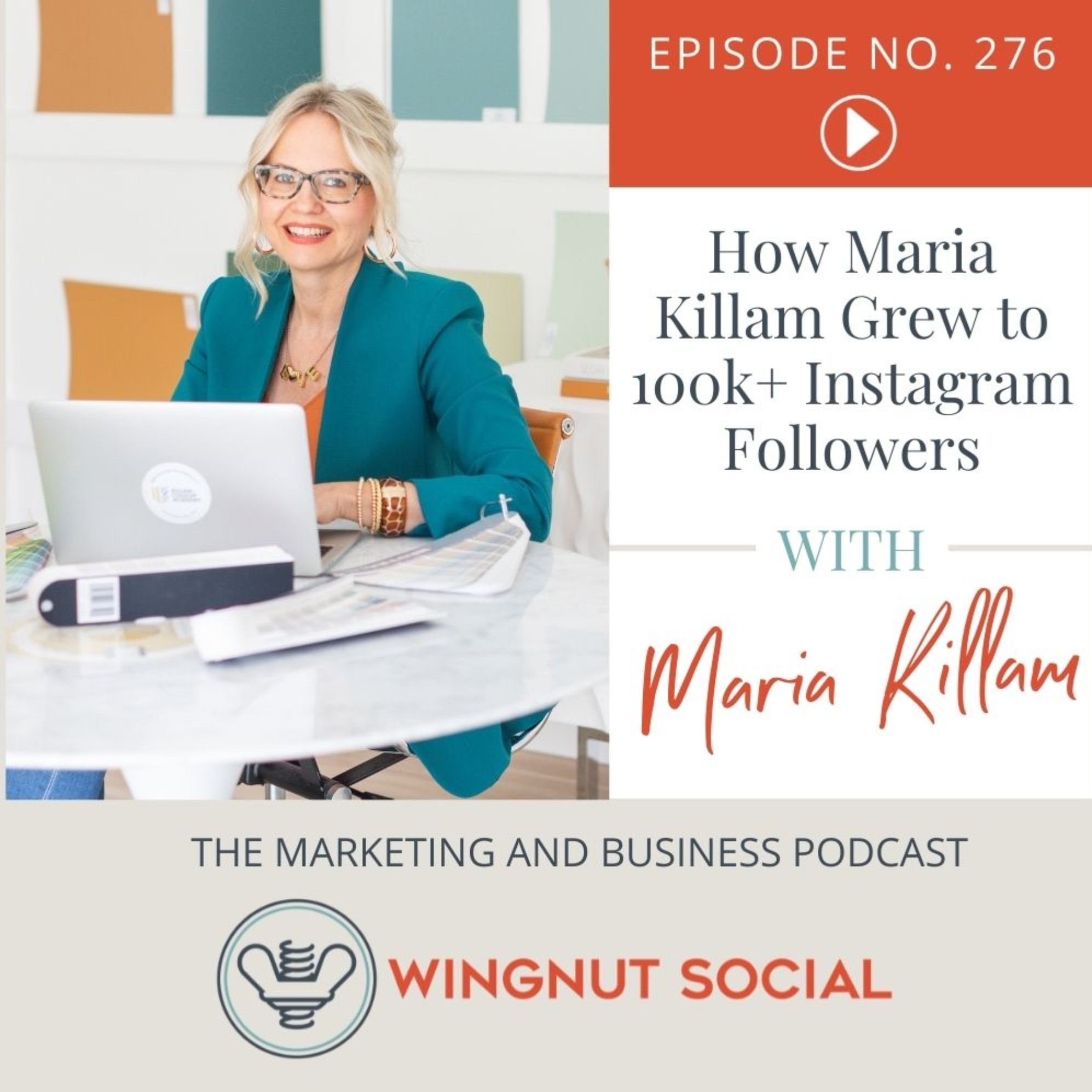
How Maria Killam Grew to 100k+ Instagram Followers - Episode 276
Maria Killam is a decorator, stylist, speaker, educator, and true color expert in interior and exterior design. She’s also the creator of the Killam Color System™, a proven system for choosing color that anyone can learn.
Maria has always shared her work on her blog and has thousands of readers. But her Instagram never took off—until recently. Maria leveraged a popular Instagram trend and grew to 100k+ Instagram followers in mere weeks. Learn how she did it in this episode of Wingnut Social!
What You’ll Hear On This Episode of Wingnut Social
[1:48] Housekeeping: Wingnut Webinar + YouTube
[2:50] Mini News Sesh: Instagram Feed Videos = Reels
[6:43] Learn more about Maria Killam and her business
[12:44] The basics of the Killam color system
[18:00] The importance of understanding color
[24:44] How Maria’s eDesign business stands out
[29:13] How Maria feels about white interiors (and trending colors)
[31:51] Maria’s marketing strategy on Instagram
[38:36] What Maria would say to someone who wants a trendy space
[40:30] Maria’s What Up Wingnut Round!
[46:29] Blooper Reel!
Connect with Maria Killam
Maria’s Website
Maria’s course: Colour Made Easy™
Follow Maria on Instagram
Resources & People Mentioned
At Your Best by Carey Nieuwhof
Record your podcast episodes on Riverside
The evolution of Maria’s business
Maria Killam launched her career while working in a paint store. She took a color course and learned how to accurately describe colors. As she helped clients choose the right colors for their homes, she started painting out large color samples and used them over and over again.
She saw that beiges always had the same undertones: pink-beige, green-beige, yellow-beige, etc. The undertones expanded from there. Her goal is to help her clients understand undertones so their design choices are complementary and timeless.
Maria created a color wheel tool to help people identify the undertones in their spaces to choose the right neutrals. Now Maria offers online courses and eDesign to help both designers and homeowners create timeless spaces.
Keep listening to learn how understanding color and undertones influences every design choice you’ll make.
Maria’s Strategy to gain 100k+ Instagram followers
Maria has spent a lot of time on Instagram. Why? Because people judge you as a marketer, designer, and businessperson based on your number of Instagram followers. They’re either impressed—or not.
One day, Maria was watching an influencer who did a “10 ways to do something…” video series that they split into 10 parts. It was a light-bulb moment for Maria. So she launched her own 10-part series: “10 Finishes that Immediately Date Your New Build.” Her Instagram following grew by 100,000 followers in a matter of weeks.
Instagram is trying to be like TikTok. It’s ALL about video. It worked for Maria because her no-nonsense personality was fully expressed in these videos. Before, she followed different random trends. Secondly, you build trust faster when they watch a video. If you’re not on video, you’re going to be behind. So how do you get started?
Start sharing videos on your stories. They’re only 15 seconds and get you comfortable in front of the camera. Maria felt extremely awkward in her first videos. But you have to go through that awkward phase to become a rockstar on video. Maria has attracted a whole new audience. Learn how you can do the same in this episode of Wingnut Social!
Connect With Darla & Wingnut Social
www.WingnutSocial.com
On Facebook
On Twitter: @WingnutSocial
On Instagram: @WingnutSocial
Subscribe on YouTube
Darla’s Interior Design Website
Check out the Wingnut Social Media Lab Facebook Group!
786-206-4331 (connect with us for your social media marketing needs)
Subscribe to The Wingnut Social Podcast on iTunes, Google Podcasts, or TuneIn
Audio Production and Show notes by
PODCAST FAST TRACK
https://www.podcastfasttrack.com
45:5103/08/2022
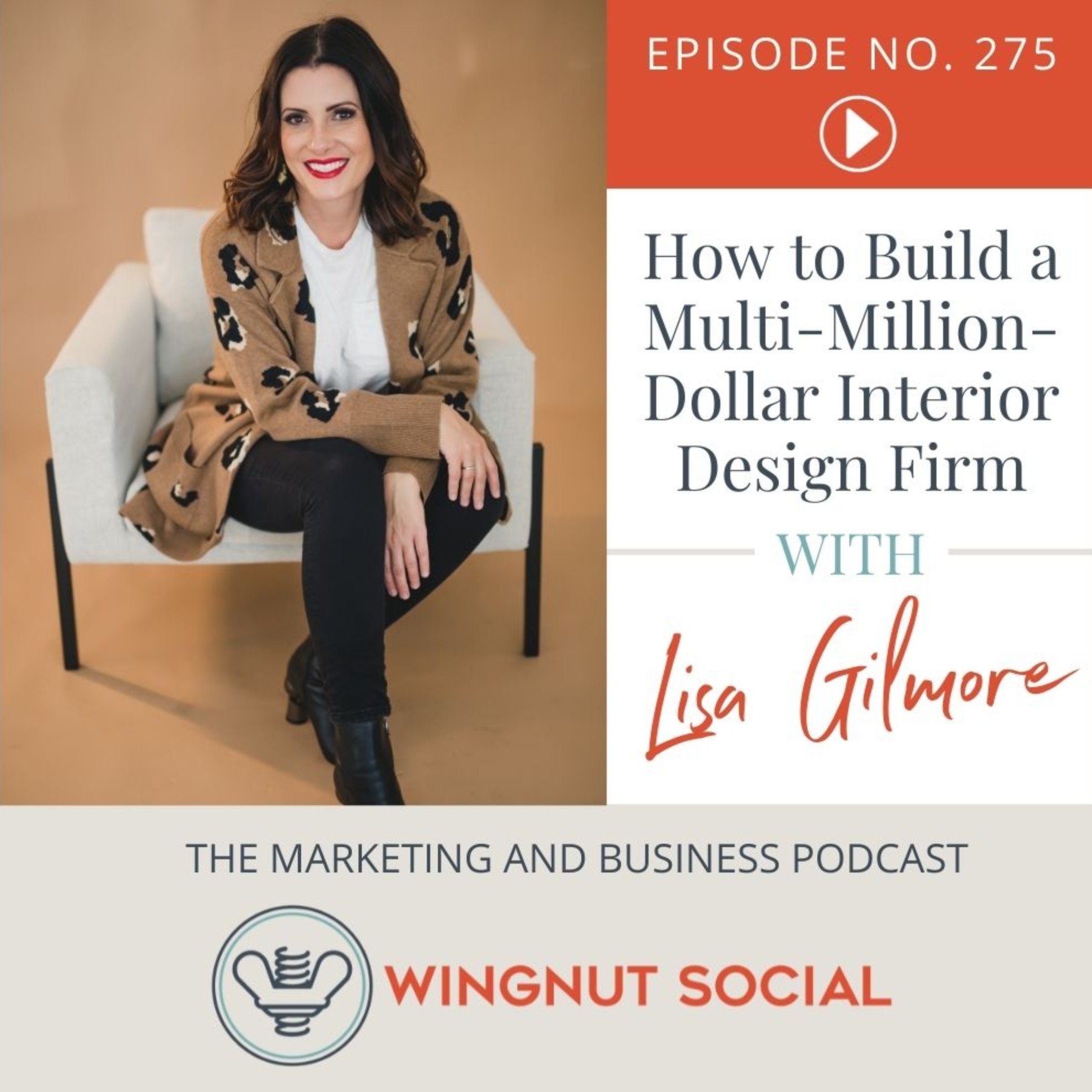
How Lisa Gilmore Built a Multi-Million-Dollar Interior Design Firm - Episode 275
Lisa Gilmore watched HGTV late at night when her mother thought she was sleeping. As she watched Candace Olson from “Divine Design” put these incredible designs together, she realized she could do the same thing. She went to design school right out of high school.
When she started her business, she focused on networking. Her goal? When anyone heard the word “interior design” she wanted them to immediately think “Lisa Gilmore.” 11 years later, she’s been featured in Forbes, Business of Home, Coveteur, Better Homes & Gardens, and more.
Lisa is recognized for her bold use of color, functionality, and “liveable glamour.” She’s built a multi-million-dollar interior design firm from the ground up. But her journey wasn’t without setbacks. Listen to this episode of Wingnut Social to learn what she did to build a thriving multi-million-dollar interior design firm.
What You’ll Hear On This Episode of Wingnut Social
[1:20] Housekeeping: Check out this month’s webinar!
[2:05] Mini News Sesh: YouTube, Instagram, or TikTok for video?
[6:07] Learn all about the extraordinary Lisa Gilmore
[10:25] How Lisa became an interior designer
[15:34] Is it important to work with an established interior designer?
[17:27] Becoming a multi-million-dollar interior design firm in 10 years
[22:22] The changes Lisa made to her pricing structure to achieve growth
[26:00] What percentage of Lisa’s business is furnishings and accessories?
[28:34] What Lisa learned from hitting financial rock bottom
[33:45] How to prepare your interior design business for a recession
[38:00] Don’t be afraid to get uncomfortable to grow to the next level
[39:25] Lisa experiences the What Up Wingnut Round!
[42:52] The Wacky Wingnut Blooper Reel!
Connect with Lisa Gilmore
Lisa Gilmore Design
Follow Lisa on Instagram
Resources & People Mentioned
Scarlet Thread Consulting
Profit First by Mike Michalowicz
MasterClass episode with Sara Blakely
Divine Design
What Lisa learned from hitting financial rock bottom
Lisa grew up in a blue-collar family in a small town in Florida. She had what she needed, but she didn’t have a lot. Her family never talked about money. So when she started her business, she avoided conversations about money. But she notes that passion only gets you so far. She couldn’t ignore it anymore.
She was going through a divorce, trying to stand on her own two feet, but she couldn’t. She went to Africa on a sort of “Eat, Pray, Love” sabbatical. It was the experience of a lifetime. But a lack of confidence coupled with poor financial management culminated in the perfect storm. Lisa logged into her bank account and realized it was empty. That was the moment she realized she needed to get her life together.
Becoming a multi-million-dollar interior design firm in 10 years
A close friend introduced Lisa to Profit First, which quickly changed her mindset about money. It took Lisa 3–4 months to recover from rock bottom. Thankfully, she’s never had a shortage of clients, so she was able to put her nose to the grindstone and implement Profit First quickly. It was a painful process. But she dug them out of debt and started saving money.
Her experience forced her to look at her business as what it could be. It needed to be her livelihood. She had to get uncomfortable with money and learn to understand profit margins. And once she focused on a Profit First mentality, her confidence grew as a female leader and business owner.
She was no longer intimidated. She sat in front of her wealthy clients with confidence and knew she could provide what they needed and make a great living.
The changes Lisa made to her pricing structure to achieve growth
Lisa raised her hourly rate to $275 an hour and now requires a higher retainer up front so clients have skin in the game. They need to be invested. She can say without hesitation that it turned her business around. She emphasizes that if you allow yourself to face your fears, you can turn your financial mistakes around quickly.
Lisa shares more about her incredible interior design firm and her path to success and financial freedom in this episode. Don’t miss it!
Connect With Darla & Wingnut Social
www.WingnutSocial.com
On Facebook
On Twitter: @WingnutSocial
On Instagram: @WingnutSocial
Subscribe on YouTube
Darla’s Interior Design Website
Check out the Wingnut Social Media Lab Facebook Group!
786-206-4331 (connect with us for your social media marketing needs)
Subscribe to The Wingnut Social Podcast on iTunes, Google Podcasts, or TuneIn
Audio Production and Show notes by
PODCAST FAST TRACK
https://www.podcastfasttrack.com
43:2227/07/2022

Why Interior Designers Need Ongoing SEO to Remain Competitive - Episode 274
Why is SEO so critical for your brand’s online presence?
How does it help you compete with other interior designers? Why is ongoing SEO the key to keeping your interior design business ranking on Google?
The biggest piece of misinformation that we hear about SEO is that it’s a “one-and-done” service that’s complete when your website is created. That couldn’t be further from the truth. Ongoing SEO, when done correctly, is your key to remaining competitive. Gavin—Wingnut’s resident SEO guru—covers this important topic in this episode of Wingnut Social!
What You’ll Hear On This Episode of Wingnut Social
[1:25] Wingnut Webinar 7/28 at 11 am EST: SEO 101
[2:50] Subscribe to Wingnut Social on YouTube!
[3:40] Mini News Sesh: Instagram Reel update
[7:42] Learn all about our SEO guru Gavin
[8:45] SEO isn’t “set it and forget it”
[13:30] Google’s algorithm and SEO
[17:42] The importance of recency and activity
[21:54] Tools and resources to leverage for SEO
[24:10] Ongoing SEO is the key to your business’s success
Resources & People Mentioned
Wingnut Webinar: 7/28 at 11 am EST: SEO 101
Wingnut Academy: Instagram for Interior Designers
Record your podcast episodes on Riverside
Wingnut Social is on YouTube!
How ongoing SEO can boost your business
When your website is created and SEO-optimized, you can’t just set it and forget it. You can’t just run ads and call it good. Why? 80% of people searching on Google ignore paid ads. Secondly, most people won’t go past the first page of search results. So your business needs to be ranked in the top 10 search results.
How do you achieve that? You have to track and measure the impact of your work and adjust your SEO continuously. You can make adjustments as you go to make sure your pages stay on the first page of Google’s search results.
Your competition’s SEO tactics are constantly changing. If you’re ranking for a keyword and it falls from #2 to #10, you need to make some adjustments or you’ll lose traffic. If your competition is ranking for keywords that you used to rank for, changes need to be made.
That’s why a robust and ongoing SEO strategy can mean the difference between being flooded with clients—or being irrelevant.
Your clients have questions—make sure you provide the answers
When it comes to blogging, people think they need to produce a chunk of new content once a month and they’re okay. Gavin points out that blogging is a great strategy and you need to do it. However, you have to keep in mind that Google is trying to connect people who have questions with the answers they’re looking for.
5–10 years ago, people would stuff keywords into a blog and rank for it. Google is now an intelligent platform that can’t be fooled. If you’re keyword stuffing, your content won’t rank. When you write content, focus on answering questions that your ideal client is searching for.
What questions are they asking? How do YOU provide the best answer and share value? The keywords and phrases you use reflect your ability to understand your customer. If you have a great idea of what your customers are looking for and provide them value, you’ll see a bump in SEO.
What tools can you use to help you write SEO-optimized content? How does Google’s algorithm play a role in your success? Listen to the whole episode to learn more about ongoing SEO’s impact on your bottom line.
Connect With Darla & Wingnut Social
www.WingnutSocial.com
On Facebook
On Twitter: @WingnutSocial
On Instagram: @WingnutSocial
Subscribe on YouTube
Check out the Wingnut Social Media Lab Facebook Group!
786-206-4331 (connect with us for your digital marketing needs)
Subscribe to The Wingnut Social Podcast on iTunes, Google Podcasts, or TuneIn
Audio Production and Show notes by
PODCAST FAST TRACK
https://www.podcastfasttrack.com
28:0020/07/2022
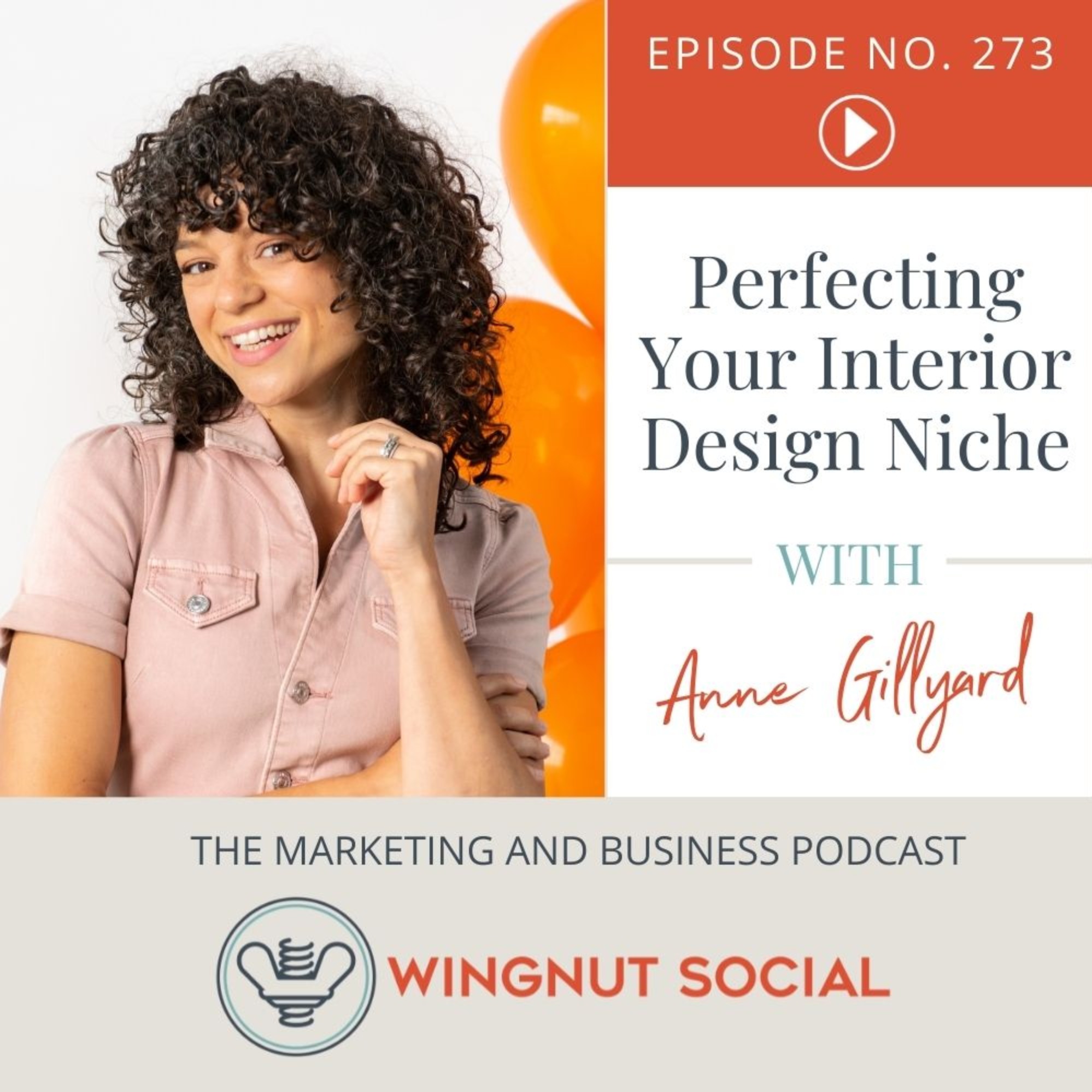
Perfecting Your Interior Design Niche - Episode 273
Anne Gillyard—along with Jodi Arellano—own and operate GrOH! Playrooms, specializing in educationally-based children’s interiors. They strive to create spaces full of color, joy, fun, and playfulness that encourage your child’s development. But how did they choose to niche down into something so specific? How have they built a thriving play-focused business? Anne joins Darla to discuss all things marketing, niching down, and incorporating play into your child’s every day.
What You’ll Hear On This Episode of Wingnut Social
[1:02] Subscribe to Wingnut Social on YouTube!
[2:01] Mini News Sesh: YouTube Shorts
[5:43] Learn all about Anne Gillyard
[7:55] How Anne chose her interior design niche
[12:39] How Anne reaches her ideal clients
[16:01] The benefit of industry partnerships
[22:36] How to choose work you enjoy
[25:05] Tips for mastering reels and videos
[28:55] The What Up Wingnut Round!
Connect with Anne GillYard
Connect on Instagram
GrOH! Playrooms
Resources & People Mentioned
Mike Michalowicz’s books
How Anne landed on a niche in playrooms
Anne worked in early education for years as a teacher and curriculum designer. But her expertise is play. She always wanted to be an interior designer but never thought she’d land there. Now, she designs family rooms, playrooms, bedrooms, and outdoor spaces where the intention is to live, breathe, and move around with your kids.
When they launched GrOh!, they were worried they wouldn’t survive if they niched down too far. So if a client asked them to do something outside their scope, they quickly agreed to it. But it wasn’t where they thrived. Once they fully committed to their niche, they took off. Now they have a waitlist of 6+ months.
How to choose your interior design niche
Anne says to pour your favorite drink, get comfy, and spend some time thinking. What lights your fire? What takes the least amount of energy to brainstorm about? When you complete a project, what are you proud of? How can you make your experience special? What can you do to make your relationship with your client wonderful and easy?
Reflect after every project and determine what you enjoyed—and what you didn’t. What did you find to be easiest? Anne once created a gorgeous custom kitchen, designed to help create independence for kids. While the project was a smashing success, they didn’t enjoy the work. Now, they only focus on what they love.
How GrOH! Reaches their ideal clients
In December 2019, GrOH! had committed to only doing commercial spaces. A few months later, because of covid, no one was going to commercial play spaces—maybe ever again. So they pivoted to residential spaces. Word-of-mouth wasn’t a possibility at that point. So what marketing stuck?
They invested in photography immediately. Then they hired social media out to professionals (Wingnut Social, of course) and the change was transformative. It’s allowed them to niche and establish themselves as go-to experts. Since then, 99% of their clients find them through social media.
And Anne is a social media genius. Her content is eye-catching, playful, and educational all while perfectly showcasing their designs. How has she found such social success (aside from Wingnut Social, of course)? She shares her tricks of the trade in this episode. Don’t miss it!
Connect With Darla & Wingnut Social
www.WingnutSocial.com
On Facebook
On Twitter: @WingnutSocial
On Instagram: @WingnutSocial
Subscribe on YouTube
Darla’s Interior Design Website
Check out the Wingnut Social Media Lab Facebook Group!
786-206-4331 (connect with us for your social media marketing needs)
Subscribe to The Wingnut Social Podcast on iTunes, Google Podcasts, or TuneIn
Audio Production and Show notes by
PODCAST FAST TRACK
https://www.podcastfasttrack.com
31:5713/07/2022
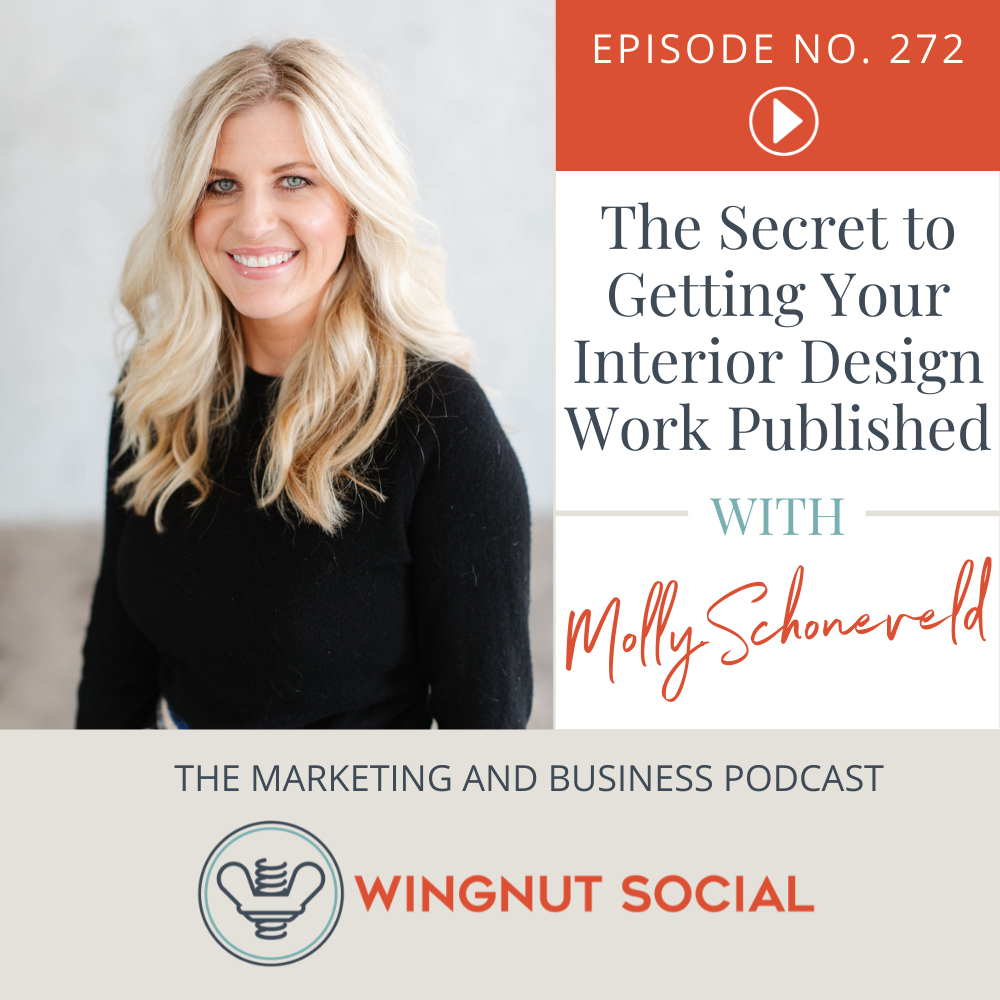
The Secret to Getting Your Interior Design Work Published - Episode 272
Molly Schoneveld is the award-winning PR strategist behind the luxury public relations firm, The Storied Group. She represents the industry's top interior designers, celebrities, and hotels, i.e. “Talented faces, spaces, and places.” She has 20+ years of experience with press placements in Architectural Digest, ELLE Decor, Vogue, and more. And she knows the secret to getting your interior design work published. What is it? Find out in this episode of the Wingnut Social podcast!
What You’ll Hear On This Episode of Wingnut Social
[1:13] Wingnut webinar and wingnut academy updates
[1:56] Mini News Sesh: LinkedIn’s repost update
[4:32] Learn all about Molly Schoneveld + The Storied Group
[7:08] Why proving publications enough images is important
[10:56] Do you need to hire a photographer with connections?
[16:06] Can a presence on YouTube help you?
[17:21] Do you need to have a celebrity client?
[20:15] Why you need to read photography contracts carefully
[23:16] Can you post the photos online if you want them featured?
[26:22] Make your photography stand out by using a stylist
[28:50] How to get your clients on board with being published
[33:46] How to stand out (and get hired by celebrities)
[38:20] The What Up Wingnut! Round
[40:26] How to connect with Molly Schoneveld
Connect with Molly Schone
The Storied Group
Connect with Molly on LinkedIn
Follow Molly on Instagram
Resources & People Mentioned
The Mystery Guest by Lorin Stein
Record your podcast episodes on Riverside
This is Marketing by Seth Godin
The secret to getting your interior design work published
What’s the secret? It all comes down to photos. Now—likely starting with Covid—many magazines will not do reshoots. What you provide them in your pitch is what will get published. So you need to give them enough photos to publish a full story. Luxe Magazine has design features that can be as long as 10–12 pages. That’s why you need to provide a variety of photos.
But Molly emphasizes that you don’t need the best photographer in the business. Why? You need to be able to afford someone who will provide you with a full range of images. What does that look like? If you want to get featured as a full home tour, you need 25–30 images of your work.
Molly landed one of her clients a feature in AD Digital. It was the home of a celebrity chef and a big-name interior designer. They didn’t reshoot the project. The photos Molly sent them were the photos that ran. The bar is high, and if you want to get into AD, you’ve got to be so much more than good. The photos you send must be shot knowing they’re going to be run in the magazine.
Do you need to hire a photographer with connections?
Molly points out that working with a specific photographer who has previously done work with the magazine you want to get published in can give you an advantage. But the advantage isn’t that the photographer can get you published—it’s that they know what the magazine is looking for. They understand the angles publications like, the styling they like, and the vignettes they prefer. Those are the things a photographer can help with.
But a magazine won’t say yes to a project solely based on the photographer. There are factors at play that are 100% out of your control, like editorial calendars, previously published homes and kitchens, and much more. But you can control your images. So work with a photographer who understands what magazines are looking for.
Make your photography stand out by using a stylist
Look at a potential photographer's social media. What is their aesthetic? That’s what you’ll end up with for your social media. What else is important? Molly believes that bringing in a stylist to bring life to your images makes the biggest difference. Magazines do this all the time. If magazine editors rely on them, designers should see them as someone who can bring their vision to life in a different way. That—coupled with a photographer versed in magazine photography—can make a huge impact.
Can you post photos online if you want them published in a magazine? Does it pay to have celebrity clients? Molly answers these questions and so much more in this episode. Don’t miss it!
Connect With Darla & Wingnut Social
www.WingnutSocial.com
On Facebook
On Twitter: @WingnutSocial
On Instagram: @WingnutSocial
Subscribe on YouTube
Darla’s Interior Design Website
Check out the Wingnut Social Media Lab Facebook Group!
786-206-4331 (connect with us for your social media marketing needs)
Subscribe to The Wingnut Social Podcast on iTunes, Google Podcasts, or TuneIn
Audio Production and Show notes by
PODCAST FAST TRACK
https://www.podcastfasttrack.com
42:4306/07/2022
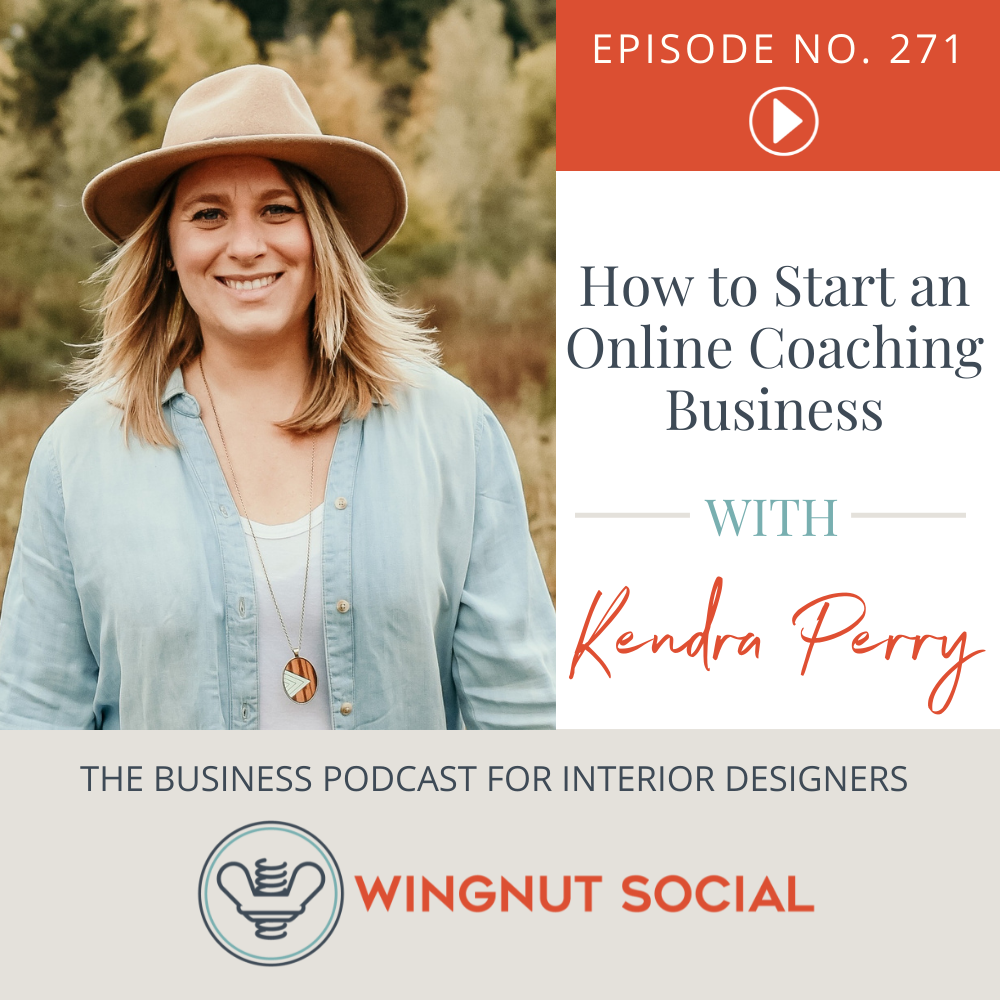
How to Start an Online Coaching Business - Episode 271
Have you thought about becoming an interior design coach? Maybe you’re burned out, ready to move on to another point in your career, or simply want some side income. Whatever the reason, online coaching might be the way to go. But how do you start an online coaching business? Do you dive in full-time, or dip your toes in part-time? Do you offer one-on-one coaching or group coaching?
In this episode of Wingnut Social, Kendra Perry—a former six-figure functional health coach turned online business strategist—shares how you can seamlessly build an online coaching business. Don’t miss it!
What You’ll Hear On This Episode of Wingnut Social
[1:30] Wingnut webinar and wingnut academy updates
[2:56] Mini News Sesh: How to calculate engagement rates
[9:17] Learn more about Kendra Perry
[11:47] The first steps: how to start an online coaching business
[15:34] How niched is too niched in the interior design industry?
[18:07] Online coaching: side hustle or a full-time job?
[19:40] Should you market your coaching business using current channels?
[22:00] Why you should start with one on one coaching
[26:14] The difference between Masterminds and group coaching
[30:00] The importance of communities to support group coaching courses
[31:55] How to structure an online course for your coaching business
[39:06] It’s time for the What Up Wingnut Round!
[41:00] How to connect with Kendra Perry
[42:50] Blooper Reel!
Connect with Kendra Perry
Kendra’s coaching website
Follow Kendra on Instagram
The Wealthy Coach Podcast
Resources & People Mentioned
Record your podcast episodes on Riverside
Engagement rate calculation: Engagement Numbers/Reach x 100
You Can Heal Your Life by Louise Hay
Circle Community Platform
Mighty Networks
The first steps: how to start an online coaching business
Everyone's an expert in something, right? Is there something you learned as an interior designer you wished you knew? Do you have expertise in a specific niche? It doesn’t have to be anything extraordinary. You don’t need specific education. You can take the knowledge you’ve acquired through your career and build it into an online program.
The most important thing you need to consider is your niche. What segment of the market are you going to target? What’s the single problem you solve for people? Who is that person? What are those people looking for? Kendra emphasizes that you aren't just selling coaching—you’re selling solutions to problems.
What outcome can you provide with your coaching? You can monetize any skills but you need to understand who you’re serving, the problem you’re solving, and the outcome you offer.
Should online coaching be a side hustle or full-time job? Should you market your coaching business using current channels? Listen to hear Kendra’s thoughts!
Why you should start with one-on-one online coaching
Many new coaches want to start with group coaching or an online course, but Kendra recommends beginning with one-on-one coaching. Why? Because it’s simpler. You don’t need a launch strategy, program hosting, modules, etc. You can reach out to your current audience and see who’s interested. You could have a coaching client the next day.
Secondly, if you don’t have a huge audience, one-on-one coaching will be easier to start with. The amount of feedback you’ll get is invaluable, which you can then take and apply to a group program. Anything you learn can be rolled into an online course.
To do something like group coaching or a course, you need volume to sell to and infrastructure in place. That’s why Kendra recommends giving yourself 6–12 months to bring in a full-time income. You have to build an audience and a list and those things take time.
When do you move to group coaching? And how do you structure an online course for your business when the time is right? Kendra is a wealth of information on this topic. Tune in to the whole episode to learn the ins and outs of building an online coaching business in the design space.
Connect With Darla & Wingnut Social
www.WingnutSocial.com
On Facebook
On Twitter: @WingnutSocial
On Instagram: @WingnutSocial
Subscribe on YouTube
Darla’s Interior Design Website
Check out the Wingnut Social Media Lab Facebook Group!
786-206-4331 (connect with us for your social media marketing needs)
Subscribe to The Wingnut Social Podcast on iTunes, Google Podcasts, or TuneIn
Audio Production and Show notes by
PODCAST FAST TRACK
https://www.podcastfasttrack.com
43:1529/06/2022
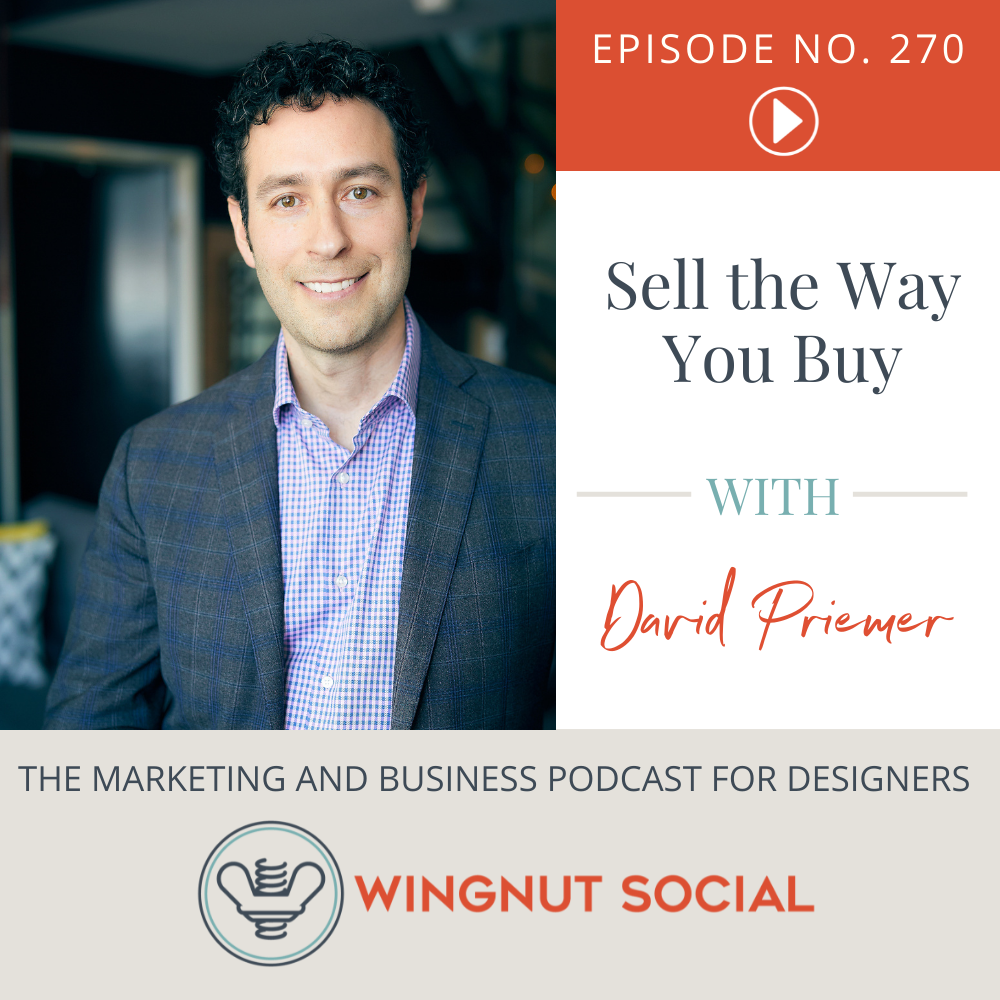
Sell the Way You Buy with David Priemer - Episode 270
Do you cringe at the thought of selling your interior design services?
David Priemer, the author of Sell the Way You Buy, is the founder and Chief Sales Scientist at Cerebral Selling, where he teaches business owners the art and science of selling. His work hinges on the idea that you have to sell the way you buy.
Your clients aren’t just paying for the service that you offer. They’re buying emotions. They’re buying the experience. So how do you sell the way you buy? David shares great takeaways from his book in this episode of Wingnut Social!
What You’ll Hear On This Episode of Wingnut Social
[1:21] Wingnut Academy and webinar announcements!
[2:18] Mini News Sesh: Instagram launches pinning
[5:19] Learn all about David Priemer
[7:13] Why salespeople are viewed negatively
[9:05] People aren’t buying solutions—they’re buying emotions
[11:48] Bring awareness of problems to the surface with this tip
[16:??] How to handle experience asymmetry
[20:59] Remember that the experience is the product
[24:26] The importance of client retention
[30:33] The What Up Wingnut! Round
Connect with David Priemer
Cerebral Selling
Connect on LinkedIn
Watch on YouTube
The Cerebral Selling Lab
Resources & People Mentioned
Sell the Way You Buy by David Priemer
To Sell Is Human by Daniel H. Pink
Record your podcast episodes on Riverside
People aren’t buying solutions—they’re buying emotions
Covid prompted David and his wife to consider having their home redesigned. To him, the worst thing about a renovation is having to choose every detail. That’s why he’s willing to pay someone who will come in and remove all of the decision-making from his plate. He emphasizes that as an interior designer, you exist in the realm of emotional selling.
As you’re talking to your clients, think about the emotion behind why they’re buying. People don’t buy solutions to problems. People buy feelings—especially in creative spaces. So what is your superpower? How do you fill the void your buyer is looking for? It starts by knowing your audience and the feelings they’re buying when they buy you. It’s powerful.
Use this tip to sell the way you buy
If you wanted to sell someone a bandaid, you could look for someone who has a cut (i.e. a problem you can solve). But that requires they’re aware that they have a problem that needs to be solved. You could also look for clients that are afraid of getting cut, like someone who wants to update their house in preparation for selling it down the road. You’re selling the future.
The third way to sell is to “cut” people. What does David mean by that? Many people aren’t aware of the problem(s) that they have. When you look at a client's home, you might point out any issues or code violations that you see. You’re bringing problems to your customers. You help them realize there is a problem they need to be solved. You have to create a little bit of pain to address it.
How do you handle this when you struggle with being comfortable in the sales process? David shares a unique strategy any designer can use—keep listening.
Remember that the experience is the product
In chapter 4 of David's book, he talks about Disney World. Disney focuses on customer experience because the experience is the product. If David hires an interior designer, the experience he goes through to arrive at the final destination ends up influencing whether or not he’s happy with the end product. You have to create that experience.
You likely became an interior designer because you’re talented and passionate about your work. You love what you do. Why should you be ashamed of selling? You’re simply conveying the enthusiasm you have for what you do to your customer.
The experience the customer has with you transcends the final product. At the end of the day, people are buying feelings. People are buying emotions. You could be the best interior designer in the world, but if no one likes you, no one will hire you.
But if you create a great experience for your clients, they’ll tell other people about you. Selling with the way you buy in mind is a game-changer.
Connect With Darla & Wingnut Social
www.WingnutSocial.com
On Facebook
On Twitter: @WingnutSocial
On Instagram: @WingnutSocial
Subscribe on YouTube
Darla’s Interior Design Website
Check out the Wingnut Social Media Lab Facebook Group!
786-206-4331 (connect with us for your social media marketing needs)
Subscribe to The Wingnut Social Podcast on iTunes, Google Podcasts, or YouTube
36:1722/06/2022
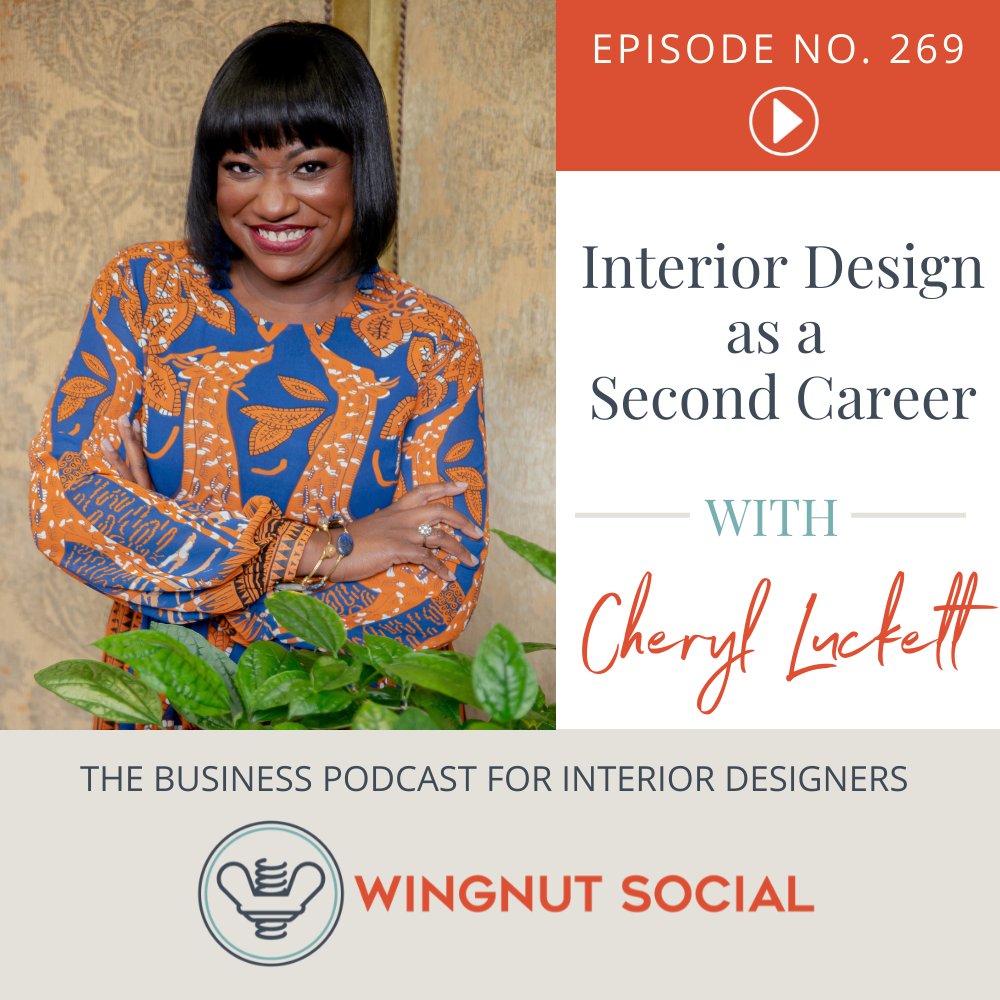
Interior Design as a Second Career - Episode 269
Have you considered interior design as a second career?
Cheryl Luckett had a 15-year career as a registered dietician and human resources professional. She launched Dwell by Cheryl after a weekly blog chronicling her home improvement projects quickly morphed into a side hustle decorating homes. After five years and a carefully planned exit strategy she dubbed “Project 36,” she left corporate life and made interior design her full-time career.
What You’ll Hear On This Episode of Wingnut Social
[1:43] Wingnut Webinar June 30th at 11 am
[2:40] Mini news sesh: Instagram’s repost option
[6:17] Project 36: Chery’s plan to transition to design
[16:36] The role of social media in building her brand
[20:02] Why you should invest in a business coach early on
[25:45] Why Cheryl chose to hire early in her business
[27:31] Hone in on a niche: Who are you here to serve?
[33:44] Approach each client with a service mindset
[34:48] What Up Wingnut! Round
[36:02] How to connect with Cheryl
[38:22] Blooper Reel!
Connect with Cheryl Luckett
Dwell by Cheryl
Cheryl’s collaboration with Wildwood
Follow Cheryl on Instagram
Resources & People Mentioned
The Dynamic Laws of Prosperity by Catherine Ponder
A Well-Designed Business® Podcast
Me by Design Coaching
Tobi Fairley Design
Record your podcast episodes on Riverside
The next Wingnut Webinar: June 30th at 11 am
Cheryl’s exit strategy: Project 36
After 10 years in the same company, Cheryl realized something wasn’t clicking. She didn’t want to be there forever. At the time, she had just purchased her first home and started decorating it. It sparked something inside her.
So she took some design courses at her community college, starting with basic drafting. She fell in love with design. She started a blog sharing her ongoing home projects, which led to clients within her circle of influence. A couple of years of night classes later, she realized she was on to something. But she needed a plan to transition out of corporate America. She called it “Project 36.” It was her 36-month exit strategy out of corporate.
She was single, had been in the same job for 12 years, and had great benefits—including stock options. The one thing that would keep her from making the move was financial. So she hired a financial planner and said, “I want to leave my job in 36 months. Help.” They set out a plan to chip away at student loans and save money so she felt comfortable with her career change.
She set a timeline for everything she needed to get done. The plan unfolded over time. The more the months ticked away, the more comfortable and confident she became about taking the leap. She needed to be strategic. She believes anyone considering a second career should be the same.
Transitioning to interior design as a second career
As Cheryl’s 36 months ticked onward, she posted three times a day on social media. It allowed her to engage in a community she wasn’t a part of full-time—yet. It allowed her to build demand for her service before she needed it. She brought people along on her journey. They knew she worked full time, knew she was in school, and knew she was building a side hustle.
Her followers were so bought into her story that when she shared a video of leaving the ivory tower, they were excited with her. Now, every December 31st, she posts that video. She executed her plan, made the leap, and is still thriving because of it. What else did she do?
Cheryl spent a lot of her PTO traveling to design conferences, investing in herself and her growth. She built relationships with people on an upward trajectory. Once she transitioned into her design business, she continued to invest in herself to continue on the path of growth.
So she hired a coach—Kim Kuhteubl. It was a significant investment but helped her understand that it’s an inside game. To show up for your business, sell your services, and serve people—you’ve got to have your mind right. It was the best move she made in the beginning stages. Her coach helped her with mindset, branding, visibility—all of the big picture things.
Listen to the whole episode to find out why honing in on a niche and having a process in place to find the right clients is a key part of her success.
Connect With Darla & Wingnut Social
www.WingnutSocial.com
On Facebook
On Twitter: @WingnutSocial
On Instagram: @WingnutSocial
Subscribe on YouTube
Darla’s Interior Design Website
Check out the Wingnut Social Media Lab Facebook Group!
786-206-4331 (connect with us for your social media marketing needs)
Subscribe to The Wingnut Social Podcast on iTunes, Google Podcasts, or TuneIn
Audio Production and Show notes by
PODCAST FAST TRACK
https://www.podcastfasttrack.com
38:4715/06/2022
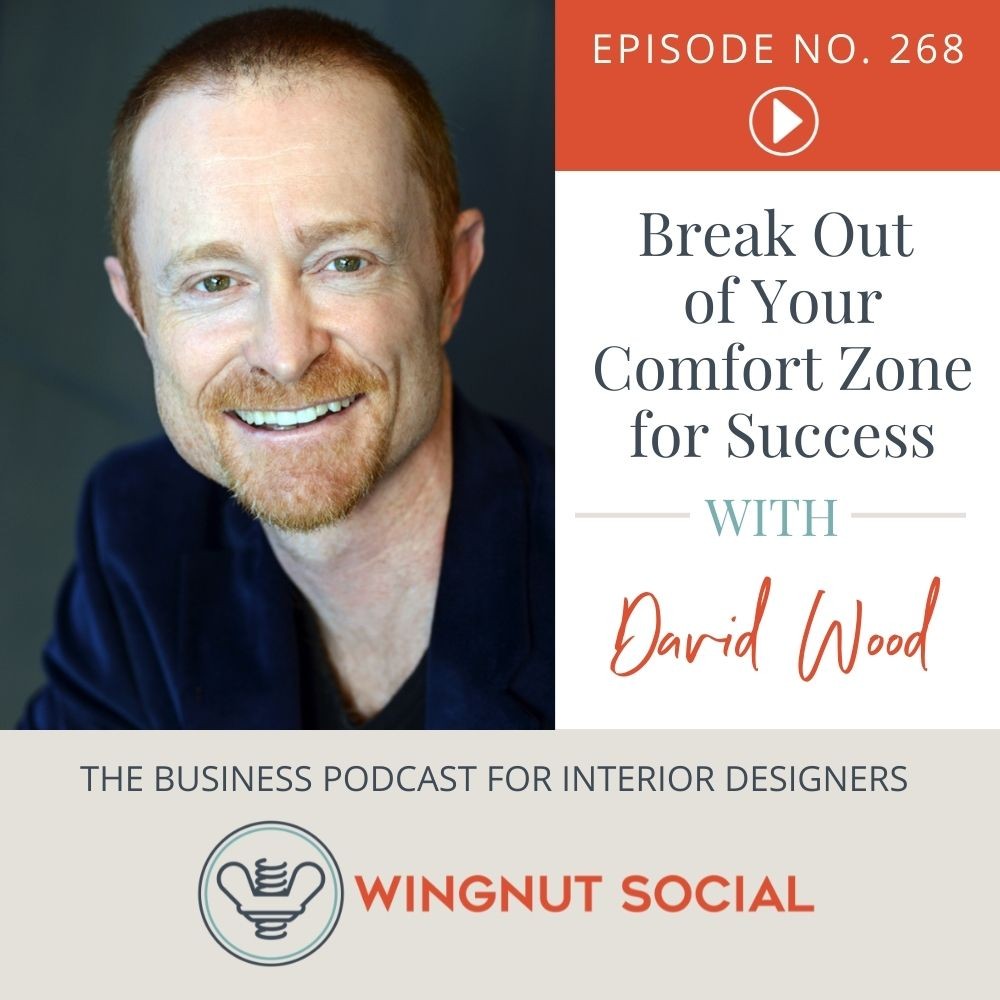
Break Out of Your Comfort Zone for Success - Episode 268
David Wood coaches high-performing business owners to double revenue—and their time off—by focusing less and being 30% more courageous in their business or career. Achieving more success sometimes means you have to break out of your comfort zone. David shares some tangible ways you can do that in this episode of Wingnut Social. Are you ready to “Get out there, get uncomfortable, and be great?”
What You’ll Hear On This Episode of Wingnut Social
[1:41] Wingnut Academy & Wingnut Webinar Announcements
[2:33] Mini News Sesh: Google’s Core Search Update
[5:38] Learn more about David Wood
[8:32] How David took a leap of faith and became an actor
[12:52] Reaching your goals takes focus and discipline
[20:56] How to be “30% more courageous”
[27:33] How do you balance being sensible AND daring?
[30:13] David’s journey towards personal growth through acting
[32:33] The What Up Wingnut Round!
[33:21] Learn more about the Mouse in the Room mission
[39:00] Blooper Reel!
Connect with David Wood
Go to MouseInTheRoom.com and get notifications for the nook launch. Set an alarm for 12pm Pacific on June 13th. Go buy as many books as you can and gift them to your friends. Amazon will let you send them the Kindle version. If you believe it deserves a review, come back one day later and leave a five-star review.
David’s Coaching Business
Connect with David on LinkedIn
Resources & People Mentioned
Loving What Is: Four Questions That Can Change Your Life
Record your podcast episodes on Riverside
Why you need to identify your “mouse in the room”
David is releasing a book called “Mouse in the Room” (because the elephant isn’t usually alone). It’s all about addressing the little animals in the room (i.e. fears) you may not normally share with someone.
When you reveal your fear and connect yourself to it, it can help you overcome it. Once you get clarity on what you’re afraid of, you can choose to tell the other person/people. It makes a decision or action far less scary.
David has always been drawn to performance—improv, standup comedy, motivational speaking, music, etc. But he was hesitant about acting. But 8 months ago, he realized he wanted to move to LA, get training, get an agent, and audition. He had never told anyone about the desire. But he “named the mouse” and shared the desire with someone.
Naming the mouse gave him energy. And the friend he’d shared with called him a week later and asked him to join her to audition for a professional production of a play. So he did. He got cast as the lead. Now he can say he’s a working professional actor. He’s still a coach and a trainer—and he’s also following his dreams.
David shares a powerful thought: "Just because you see someone do something that seems courageous doesn’t mean that they’re fearless. But they’re willing to have that fear and work through it.” How can you go for it and honor yourself so you don’t say, “I wish” on your deathbed? It takes courage to give your all and live your life.
Reaching your goals takes focus and discipline
Entrepreneurs see all of the possibilities. But they can only spread themselves so far. You add in social media, text messages, phone calls—it’s no wonder that most people are dealing with stress and anxiety. It slows down your goals.
Sometimes you need someone else to help you say “stop.” By focusing on less, you can produce more. It’s possible to get twice as much of the personal stuff done in half the time you’re spending now. How?
The answer is discipline. What matters to you over the next twelve months? What are the three business goals and the three life goals that matter to you that will have you celebrating 12 months from now? When you achieve one of these goals, return to your full list of goals and add a “Bonus goal” into the mix. This is only for people who want to be extraordinary.
How can you be “30% more courageous?” How do you balance being sensible AND daring? Listen to hear David’s thoughts!
Connect With Darla & Wingnut Social
www.WingnutSocial.com
On Facebook
On Twitter: @WingnutSocial
On Instagram: @WingnutSocial
Subscribe on YouTube
Darla’s Interior Design Website
Check out the Wingnut Social Media Lab Facebook Group!
786-206-4331 (connect with us for your social media marketing needs)
Subscribe to The Wingnut Social Podcast on iTunes, Google Podcasts, or TuneIn
Audio Production and Show notes by
PODCAST FAST TRACK
https://www.podcastfasttrack.com
39:2508/06/2022
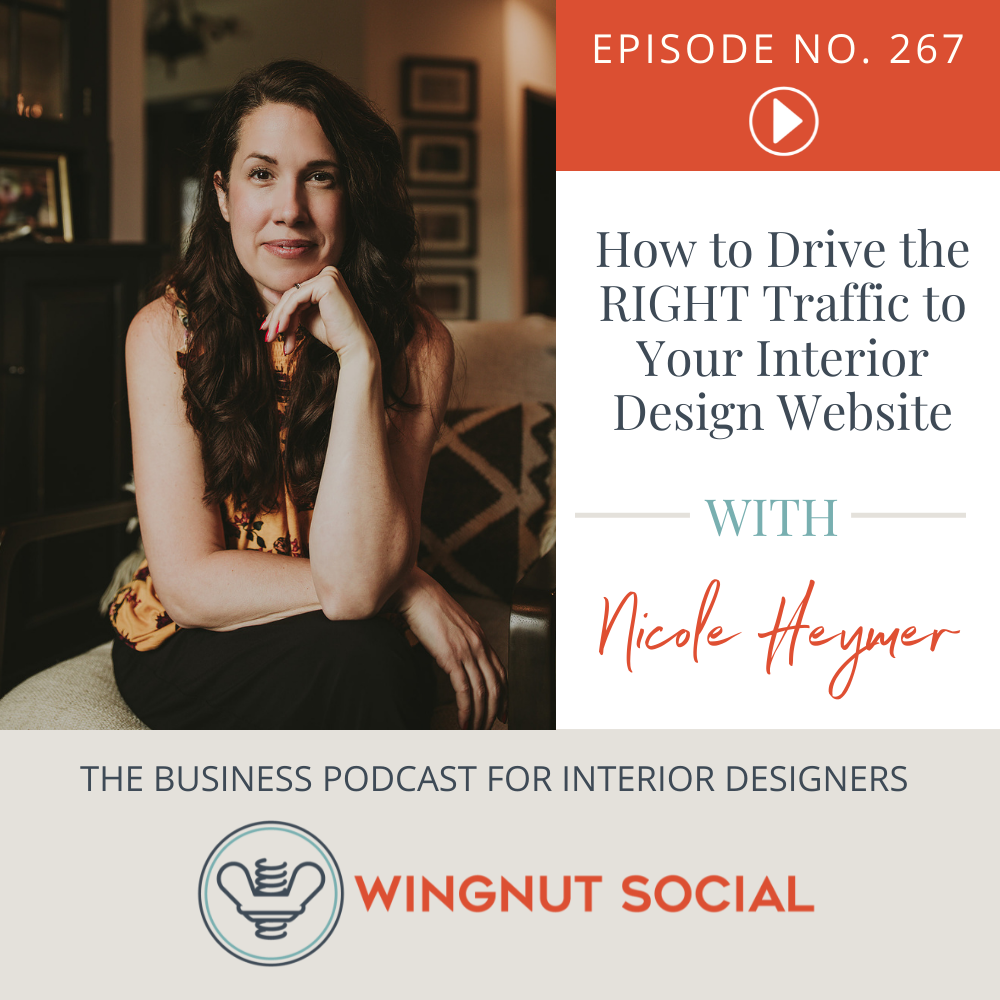
How to Drive the RIGHT Traffic to Your Interior Design Website - 267
How do you drive the right kind of traffic to your interior design website? How do people who want the services you provide find you? How do strategies differ for local and national traffic? Everyone knows they need a plan to drive traffic, but it can be overwhelming—which is why it’s often put on the back burner. In this episode of Wingnut Social, Nicole Heymer of Glory & Brand will help you nail down where to start and how to drive the right traffic to your interior design website. Don’t miss it!
What You’ll Hear On This Episode of Wingnut Social
[1:31] Wingnut Academy & Wingnut Webinar Announcements
[3:15] Mini News Sesh: Instagram shakes up Stories
[7:06] Driving traffic to your interior design website
[15:05] Focus on your messaging to demonstrate your niche
[20:52] The importance of content marketing to drive traffic
[27:43] The impact of including video on your website
[33:47] Use social media marketing to serve a larger audience
[36:24] Why you have to focus your efforts carefully
[37:35] How to use email marketing to drive traffic
[40:04] Networking to drive traffic to your website
[45:03] The What Up Wingnut Round!
[47:30] How to connect with Nicole Heymer
[49:40] Blooper Reel!
Connect with Nicole Heymer
Glory & Brand
Glory & Brand on Instagram
Resources & People Mentioned
Record your podcast episodes on Riverside
Ubersuggest
Semrush
The E-Myth Revisited by Michael Gerber
Clockwork by Mike Michalowicz
Driving traffic to your interior design website: Where to start
Your website won’t drive traffic to itself. To figure out where to start, you need to ask yourself some questions:
What is your area of service? Is it local? Is it national? If it’s local, you have to tell the humans and search engines where you service (city, suburb, county?). Ask yourself what you would search for. If you’re trying to reach a national audience, your only hope is to niche.
Start by focusing on local search to establish a presence. It gives you credibility. If you want to build a national brand, focus on social media and building an email list. That's how you get in front of a large audience. An email list gives you control over your audience and the ability to directly market to them.
Secondly, where are you now? Where do you want to go? Who’s coming to the website and where are they coming from? Go to Google Analytics and look at “acquisition.” You can see where people are coming from (social, organic, etc.) You can use a tool like Ubersuggest, SEMrush, Ahrefs, etc. to gauge traffic, research keywords, and even spy on competitors. It’s fun to see how your keywords are growing and moving up in rankings. If you aren’t showing up in organic search, you can see it as an opportunity.
The importance of content marketing to drive traffic to your website
Content marketing is creating content that will educate, entertain, or demonstrate expertise. You can push it on social media but SEO and content marketing are intrinsically linked. You can optimize a homepage—and you should—but the real power in SEO comes from creating content.
If you want people to find you for a search term, you need one page dedicated to that search term. Search results are answers to a question. If you provide a robust answer to the question—that matches the search intent—you’ll start showing up in Google searches.
You can take two approaches with content:
Locally focused SEO and content
Ranking for high volume traffic-driving keywords
When Google sees that you’re getting traffic, it raises your domain authority, making you more likely to show up in local searches.
Location and service pages can be a major tool for local bases. Optimizing your google business page because it is low-hanging fruit for local search. Your actual location will help you show up in map searches. If you want to show up for other towns, you can create location pages that you optimize for interior design in such-and-such towns. You want to link to these pages on your website, but the goal is to rank in search. It’s a classic SEO technique that still works.
When it comes to local SEO, the reason Nicole prioritizes this over other methods of traffic is because of intent. Someone is searching for local interior designers, they’re serious. But local SEO can’t be everything. You need to leverage social media, email, and other strategies to have a well-rounded source of traffic. The messaging on your website will help you stand out.
Why should you use video strategically throughout your website to increase traffic? How can you use social media marketing to serve a larger audience? Listen to learn more!
Email marketing: The underused driver of website traffic
Email marketing allows you to drive traffic to your website at a specific time of day. It’s also highly cost-effective—whether you’re paying for a copywriter or doing it yourself. The con is that you have to work to build an email list. The people who are serious about email marketing build numerous opt-ins to get people on their list—quizzes, live speaking engagements, interactive lead magnets, etc.
A perceived con is that everyone hates getting emails. However, there are at least 1–2 emails that people always want to read. They’re educational, entertaining, informational, etc. You can be as accretive as you want.
Why do you need to focus your efforts carefully? How do you use email marketing to drive traffic? How can purposeful strategic networking drive traffic to your website and design firm? Listen to the whole episode for Nicole’s genius advice.
Connect With Darla & Wingnut Social
www.WingnutSocial.com
On Facebook
On Twitter: @WingnutSocial
On Instagram: @WingnutSocial
Subscribe on YouTube
Darla’s Interior Design Website
Check out the Wingnut Social Media Lab Facebook Group!
786-206-4331 (connect with us for your marketing needs)
Subscribe to The Wingnut Social Podcast on iTunes, Google Podcasts, or TuneIn
Audio Production and Show notes by
PODCAST FAST TRACK
https://www.podcastfasttrack.com
50:3401/06/2022
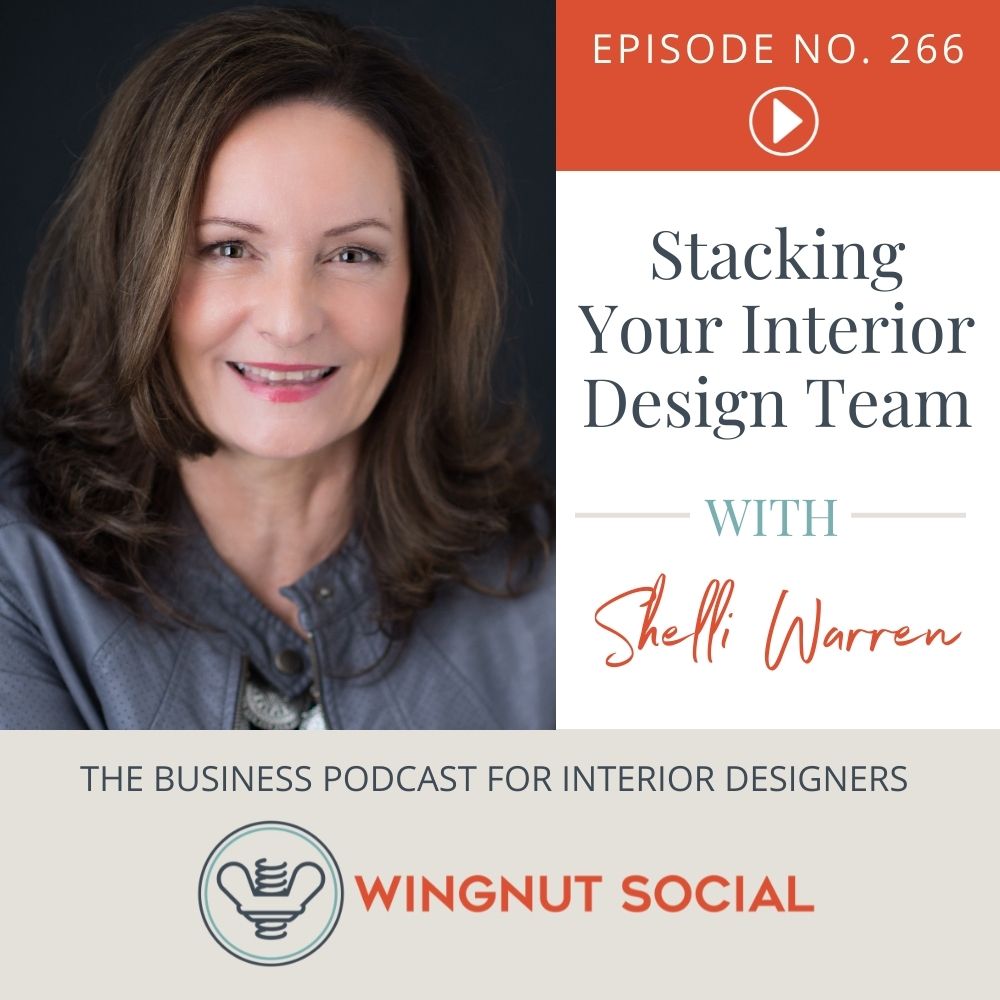
Building Your Interior Design Team with Shelli Warren
How do you build your interior design team when the current job market is a race for talent? Hiring stellar candidates isn’t easy in a competitive market. So how do you appeal to your ideal hire? How do you retain top talent? What’s the best method for promoting from within? These are just a few of the questions Shelli Warren answers in this episode of Wingnut Social!
Shelli Warren is a team and leadership coach and the host of the podcast, “Stacking Your Team.” She leverages 26 years of experience to deliver multi-million dollar projects for billion-dollar brands. She helps small business owners hire, fire, and inspire a team of high-performers.
What You’ll Hear On This Episode of Wingnut Social
[3:14] The next Wingnut Webinar: June 30th at 11 AM
[4:10] Mini News Sesh: How to show up on social media
[8:24] Learn all about Shelli Warren
[10:33] How to create a stellar job posting
[19:19] Involving your team in the hiring process
[22:06] The mission of a career portal on your website
[27:31] The importance of the interview (even for promoting from within)
[31:54] The qualities Shelli looks for in leadership
[36:50] How do you retain employees for the long haul?
[41:43] The importance of a benefit package
[45:53] Build out a career path for new hires
[48:05] The What Up Wingnut Round!
Connect with Shelli Warren
The Stacking Your Team podcast
The BizChix Podcast
BizChix Leadership Lab
Connect on LinkedIn
Resources & People Mentioned
Record your podcast episodes on Riverside
Get FREE shipping on your first order from Article
Check out the Wingnut Webinar on June 30th at 11 AM
Groh Playrooms on Instagram
The Signature of All Things
How to create a stellar job posting
When you’re hiring, you have to become a marketer. You have to position a job as the best career opportunity anyone would come across. You need to market the job opportunities, team culture, and clients. You position yourself as a place of work where someone can have a career—not a job. Why? People have had it with their jobs. They want something creative and worthwhile. You need to create visuals so potential hires can see themselves working alongside you.
If you’re selling a product or service, you have to tell its story, right? You want to position your role the same way. Share what a “day in the life” looks like. Paint a picture so they can see themselves in that role long-term. It helps decrease turnover. You want to be able to confidently select the people that will join your team that are in it for the long haul.
Shelli notes that you must be transparent about compensation and benefits. Many people who had really incredible salaries get to a point where it isn’t about the money anymore. They want to feel like what they’re doing is worthwhile. But you need to put the salary out there in black and white. Be professional and say: here’s the role, the title, what the role looks like, the anchor skills, and the compensation. If it aligns with their career goals, they’ll want to meet with you. If someone isn’t okay with that number, don’t waste each other’s time.
How can new designers create a compelling job description when they don’t have a solid team culture to brag about? Listen to hear Shelli’s thoughts.
How do you retain employees for the long haul?
Shelli jokes that you have to remind your team just how good they have it! She notes that you can read testimonials to your team. Share the goals that you are crushing. It’s about creating storylines where everyone understands their role and how it rolls up into the mission of the business.
Don’t be afraid in one-on-one conversations and quarterly reviews to give people shoutouts and remind them what they bring to the business. Make sure it isn’t just the “rock stars” who are getting the spotlight. Every rockstar has a team supporting them. Acknowledge everyone on the team and remind them that the work they do is worthwhile.
Great leaders know how to intrinsically motivate their team with real data. It’s more than “way to go” and “good job.” Your team wants professional feedback that assures them that you notice how hard they work day in and day out.
What role does a career page on your website play in hiring? How do you leverage LinkedIn, Indeed, and networking to stack your interior design team? Listen to the whole episode for some amazing insight from Shelli.
Connect With Darla & Wingnut Social
www.WingnutSocial.com
On Facebook
On Twitter: @WingnutSocial
On Instagram: @WingnutSocial
Subscribe on YouTube
Darla’s Interior Design Website
Check out the Wingnut Social Media Lab Facebook Group!
786-206-4331 (connect with us for your social media marketing needs)
Subscribe to The Wingnut Social Podcast on iTunes, Google Podcasts, or TuneIn
Audio Production and Show notes by
PODCAST FAST TRACK
https://www.podcastfasttrack.com
51:5925/05/2022
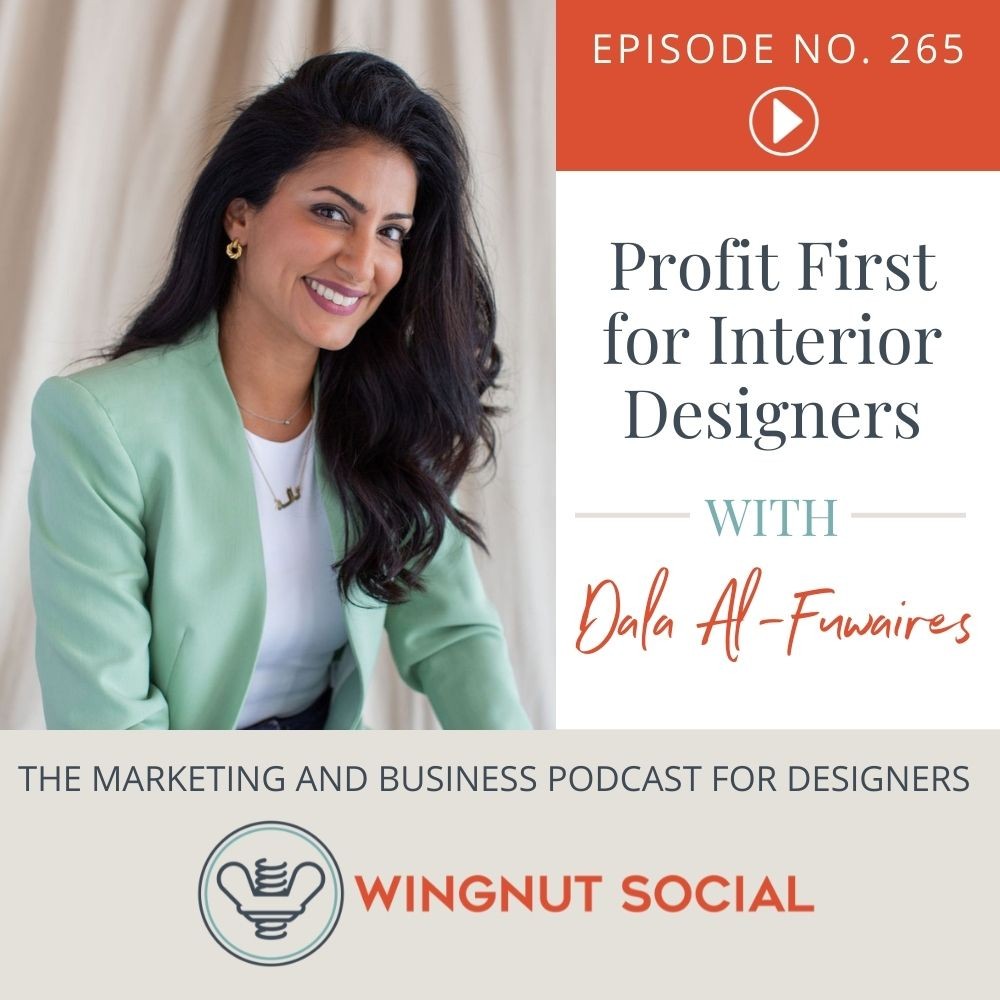
Profit First for Interior Designers - Episode 265
Mike Michalowicz’s “Profit First Method” flips traditional methodology on its head. Most people subtract expenses from earnings and whatever is left is “profit.” But you started a business to profit, right? So you should take your profit first and use whatever is left to operate your business. It shifts your mentality, leans your business, forces you to be creative, and leads to profit.
Dala Al-Fuwaires knows firsthand. She implemented the profit first method at her commercial interior design firm, House of Form. In this episode of WingnutSocial, Dala shares how interior designers can implement this practice in their business—and how embracing this methodology has impacted her business.
What You’ll Hear On This Episode of Wingnut Social
[3:20] Wingnut Webinars and Wingnut Academy Updates
[5:06] Mini News Sesh: Facebook launches new ‘Bubbles’ feature
[7:54] Learn about Dala Al-Fuwaires and House of Form
[9:43] What is the profit first method?
[13:05] How banking works on the profit first method
[17:45] How implementing profit first has impacted Dala’s business
[23:28] Dala’s marketing strategy for House of Form
[26:21] Where interior designers should get started
[29:00] Could a profit-first mentality help you sell your business?
[32:03] The What Up Wingnut round!
[36:24] Blooper Reel!
Connect with Dala Al-Fuwaires
House of Form
Follow on Instagram
Connect on LinkedIn
Resources & People Mentioned
Wingnut Webinars: 6 Ways to Infuse Personality into a Luxury Brand
Get Wingnut Academy Updates
Follow us on Instagram and you just might win a scholarship to our Instagram for Designers courses!
Get FREE shipping on your first order from Article
Profit First by Mike Michalowicz
Built to Sell by John Warrilow
How to implement the profit first method
Because the profit first method involves allocating revenue very specifically, it’s best to have separate bank accounts for each “bucket.” When Dala implemented profit first, she modified it slightly to suit her interior design firm: Dala uses four main accounts:
Opex: This account is for anything that involves operating expenses for the business. This includes things like payroll, your lease, marketing, computer programs—anything that is an expense for the business.
Tax distribution: Dala immediately sets aside 15% for taxes so at the end of each quarter she can make a payment to the IRS and not worry about where it’s going to come from.
Owner’s Pay: As the business owner, you need to make sure you’re getting paid for your work!
Profit: This is where you allocate bonus funds that can be put toward advancing your business. For example, Dala used it to build out an office for her team.
Each account is broken into a different percentage based on the performance and revenue of the company (i.e. Dala sets aside 10% of every check that comes through for profit). Every “Financial Friday” Dala spends the first hour of the day distributing funds into its respective account.
How implementing Profit First has impacted Dala’s business
Before embracing the Profit First method, Dala had one account. She wasn’t on payroll and her salary was whatever was leftover at the end of the month. But when you implement profit first and go through the exercise of dividing up the money in various accounts, you realize what the revenue needs to be to meet the goals for your business. It allowed Dala to carefully evaluate big decisions.
Logistically, she points out that it’s easy to log in to your bank account and look at each designated account and know what funds are available in each bucket. Dala can make informed decisions fast, such as hiring a new team member. It gives you the structure needed to run a successful business.
Where should interior designers start?
Read the book. Talk to peers who have implemented the profit first method who can share some insight. If your business isn’t profitable, Dala believes that you can still implement this method. It will be the push you need to become profitable. It forces you to think differently about how you run your business.
How can the profit-first mindset help you sell your business in the future? What next steps should you take? Learn all about it in this episode of Wingnut Social!
Connect With Darla & Wingnut Social
www.WingnutSocial.com
On Facebook
On Twitter: @WingnutSocial
On Instagram: @WingnutSocial
Darla’s Interior Design Website
Check out the Wingnut Social Media Lab Facebook Group!
786-206-4331 (connect with us for your social media marketing needs)
Subscribe to The Wingnut Social Podcast on iTunes, Google Podcasts, or TuneIn
Audio Production and Show notes by
PODCAST FAST TRACK
https://www.podcastfasttrack.com
36:5518/05/2022
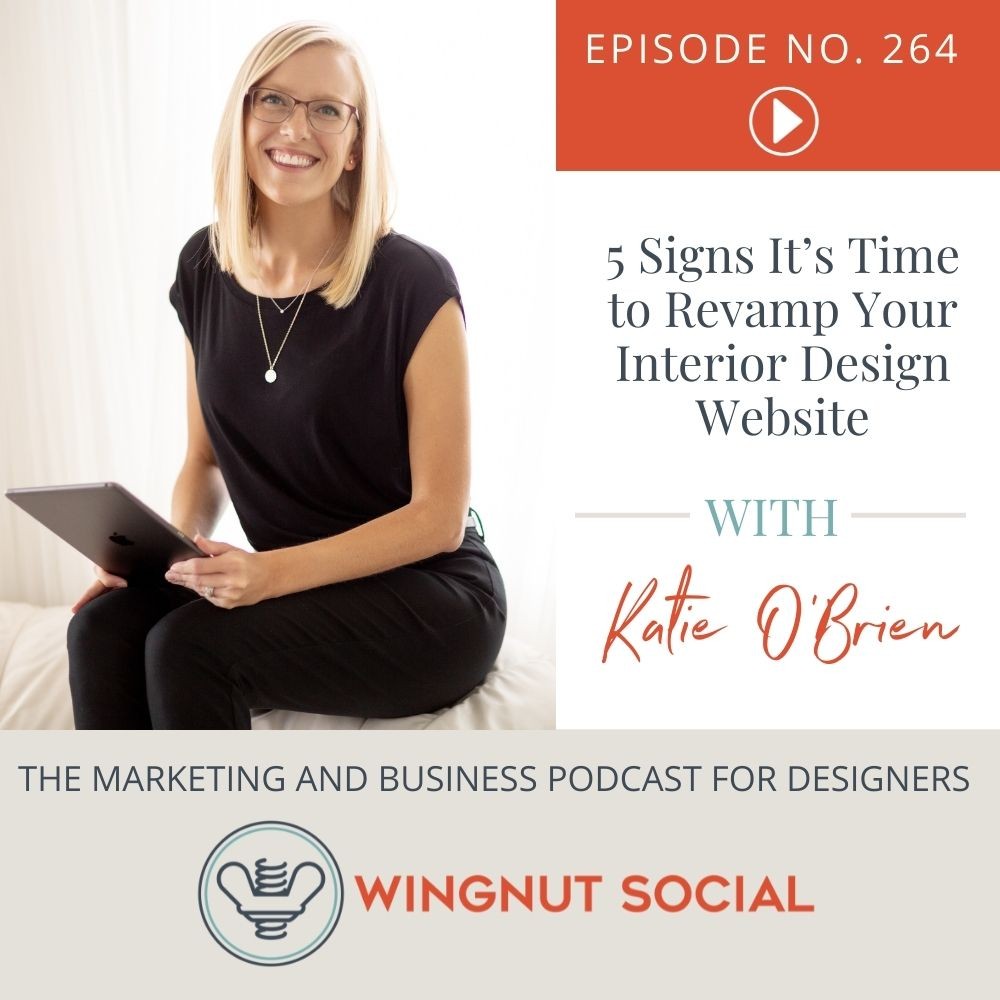
5 Signs It’s Time to Revamp Your Interior Design Website - Episode 264
Do you avoid sending prospective clients to your interior design website? Is it outdated with little copy? Does your website bring in any leads? If your website isn’t working for you, you’ve got a problem that Katie O’Brien can help you fix. Katie O’Brien is a brand and website designer specializing in elevated branding and fuss-free websites for interior designers. In this episode of The Wingnut Social podcast, Katie shares the type of copy to use, the right way to direct a prospective client to your contact form, and how to know when it’s time to revamp your website. Check it out!
What You’ll Hear On This Episode of Wingnut Social
[2:47] Wingnut Academy and Wingnut Webinars!
[4:06] Mini News Sesh: Instagram prioritizing original content
[7:56] Learn all about website designer Katie O’Brien
[10:34] Why “If I build it, they will come..” is the wrong mentality
[14:32] How to get ideal clients from your website
[17:20] What type of copy to avoid—and what to embrace
[18:47] How to answer the budget question on your website
[25:35] The proper amount of copy to have on each page
[27:12] Why your portfolio page still needs copy to tell a story
[29:10] 5 signs that an interior designer has outgrown their website
[33:02] How to direct your client’s steps on your website
[35:32] Strategic testimonials can propel customers toward you
[36:40] How to make lead magnets valuable to your clients
[38:13] The What Up Wingnut Round!
[42:04] Blooper Reel!
Connect with Katie O’Brien
Katie’s Website
Connect on LinkedIn
Resources & People Mentioned
Building a StoryBrand by Donald Miller
Business Made Simple with Donald Miller
Why “If you build it, they will come..” is the wrong mentality
Is your website getting traffic? Are you getting traffic but it’s not converting? Or are you not getting traffic at all? Kate notes that many factors that can impact this. But the first question she usually asks is, “Are you doing anything to bring traffic to your website?”
Your website should be where your social media, media appearances, new inquiries, DMs—everything should be directed to. Once there, your website needs to strategically guide visitors to take a desired action.
If someone is looking to increase traffic, the answer is SEO. Katie’s biggest recommendation is to add regular, relevant, and consistent content to your website. You must make sure it’s SEO optimized and then share it everywhere. People don’t understand that ongoing SEO is necessary. It means blogging (and updating blogs), writing metadata, adding photos, building your portfolio, link-building—and so much more—consistently.
How to get ideal clients to connect with you
Katie says to look at your website copy. What are you saying? Is it strategically speaking to your ideal client? Who is your ideal client? Many people don’t have their ideal client nailed down and it’s a mistake. You need to get specific about your ideal client—who are they? What are their pain points? How are you helping them with that? Does your website content speak to that person? You need to direct them to the next step.
The next step is usually to complete a contact form or book a discovery call. All of your calls to action should work toward that goal. Teach them who you are, qualify them, and give them information about you to direct their steps. Think about the end result first. How does every page work toward that? Keep listening to hear how Katie suggests structuring pages to drive visitors to your call to action.
5 signs it’s time to revamp your interior design website
Kate shares 5 signs when you KNOW it’s time to hire a pro:
Your business is running almost entirely on referrals: While referral business is positive, it’s also a red flag. It means your website isn’t generating leads for you. If it isn’t, something’s wrong.
You are getting leads—but they’re the wrong leads: Consider adding qualifiers to your contact form to combat this issue. Is something on your website (like pricing language) missing?
Your business has evolved: If your website hasn’t evolved with your business, it needs to be updated. Your website needs to reflect all of the changes your business has made.
You avoid sending people to your website: If you’re embarrassed to direct people to your website, that’s a clear sign that your website is outdated (or you hate it).
You’ve been thinking about rebranding for a while. If you’ve been eying a website you love for a while or are gathering inspiration, take the next step. Find a season in your business where it’s a good time to revamp your website.
If it’s time to take the next step, connect with Katie! Until then, she shares a wealth of great ideas to brush up your website in this episode.
Connect With Darla & Wingnut Social
www.WingnutSocial.com
On Facebook
On Twitter: @WingnutSocial
On Instagram: @WingnutSocial
Darla’s Interior Design Website
Check out the Wingnut Social Media Lab Facebook Group!
786-206-4331 (connect with us for your social media marketing needs)
Subscribe to The Wingnut Social Podcast on iTunes, Google Podcasts, or TuneIn
Audio Production and Show notes by
PODCAST FAST TRACK
https://www.podcastfasttrack.com
42:5111/05/2022
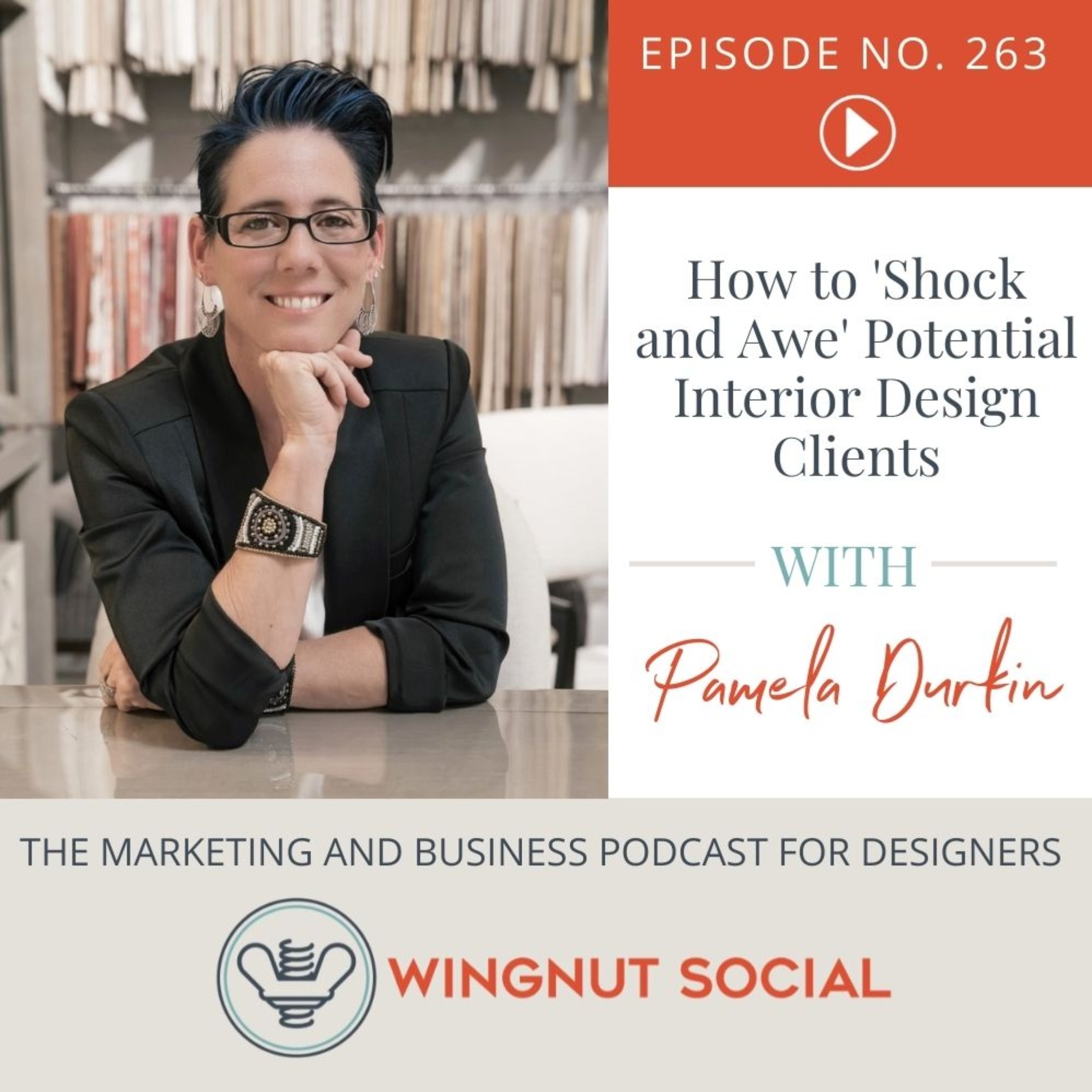
How to ’Shock and Awe’ Potential Interior Design Clients - Episode 263
How do you attract the perfect interior design client? How do you decide what type of client will be the best fit? After 30 years in high-end commercial and residential design, Pamela Durkin now helps other designers create a business they love by teaching them how to attract their ideal clients. In this episode of the Wingnut Social podcast, she shares how to design your perfect client, how to leverage your network for referrals, and how to “shock and awe” potential clients so they become actual clients.
What You’ll Hear On This Episode of Wingnut Social
[2:07] Wingnut Webinars and Wingnut Academy Updates
[4:10] Mini News Sesh: NEW Instagram features being released
[9:11] Learn more about Pamela Durkin
[12:35] How to find your perfect client
[17:11] Pamela’s tips for new interior designers
[21:23] How niching down impacts your bottom line
[27:58] How to leverage your network
[30:26] Pamela’s process of auditioning clients
[35:10] Pamela’s “Shock and Awe” box
[41:41] The What Up Wingnut Round!
[45:05] How to connect with Pamela Durkin
[50:42] Blooper Reel!
Connect with Pamela Durkin
Pamela’s website
Connect with Pamela on Instagram
Read Pamela’s book: Elevate!
Resources & People Mentioned
Wingnut Webinars
Get Wingnut Academy Updates
Follow us on Instagram and you just might win a scholarship to our Instagram for Designers courses!
Get FREE shipping on your first order from Article
The Big Leap by Gay Hendricks
Sell the Way You Buy by David Priemer
How to narrow down your perfect client
Designers are scared to leave money on the table, so many don’t narrow down their focus and choose a niche for their design business. But you need to. Pamela shares that you should start the process by taking the best things about past clients that you’ve worked with and molding them into a persona.
What motivations did they have? What was their personality like?
What work have you done that’s been profitable?
How much do you enjoy doing that type of project?
These things create a goal for the type of client you’re trying to attract. Pamela is from NJ and realized that when she did her best work, it was with people who made decisions quickly. Executives are the best types of clients for her. They make thousands of decisions every day, they make them quickly, and they hire professionals. They appreciated her personality and they were on the same page. Knowing this allowed Pamela to create connections quickly. You want people to say, “I feel like I know you.”
What do you do if you’re new to the business? How do you choose considerate people to work with? How does narrowing your focus impact your bottom line? Listen to learn more!
Pamela’s process: auditioning clients
It may sound odd at first glance—but it’s genius. Pamela auditions her clients. She starts by having a 15-minute phone conversation with them (nine out of ten times it’s a referral). She asks them to tell her about the project. The goal is to get a feel for their personality and their style—not their budget.
Why does that matter so much? Because interior designers are in the most intimate parts of people’s homes. They need to build rapport and foster open communication. Pamela will turn down a job if she doesn’t think it will be a good fit. Most people appreciate that.
Pamela will also ask for the project address and look at photos of the home to talk more intelligently about what they want to do. This will also help her gauge the value of the property and if it’s within her scope of work. If everything lines up, Pamela will schedule an in-person meeting. Her next step is genius.
Pamela’s “Shock and Awe” box
Before the meeting, she sends potential clients a “Shock and awe” box. The box will include a gift, a drink and snack, and a handwritten note that says, “Enjoy this snack while learning more about us.” She’ll include a few back issues of her monthly newsletter so they can get to know her. She shares her professional profile, an FAQ sheet, her project process, and more.
The key is to send this before they’ve hired her. Not only does it make an impact, but the box shows how organized you are, shows how you’re going to take care of them, and shares your communication style. You have to remember that people are buying the experience. Once you get to the in-person meeting, they’ve learned so much about you that they only ask questions about the things they actually have questions about. It leads to a more productive and intimate conversation.
Connect With Darla & Wingnut Social
www.WingnutSocial.com
On Facebook
On Twitter: @WingnutSocial
On Instagram: @WingnutSocial
Darla’s Interior Design Website
Check out the Wingnut Social Media Lab Facebook Group!
786-206-4331 (connect with us for your social media marketing needs)
Subscribe to The Wingnut Social Podcast on iTunes, YouTube, or TuneIn
52:2304/05/2022
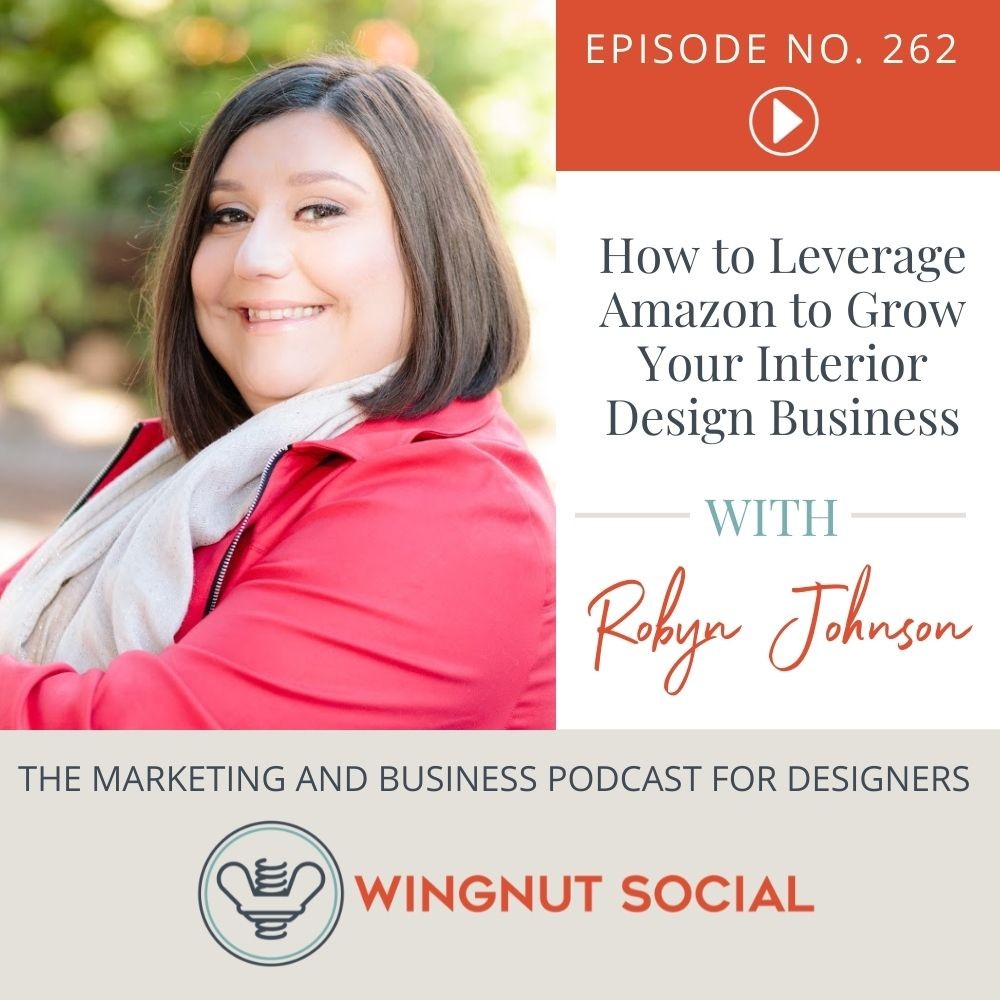
How to Leverage Amazon to Grow Your Interior Design Business - Episode 262
10 years ago, Robyn was a youth minister who couldn’t make ends meet. So she took $100 and started buying things at garage sales and reselling them on Craigslist, eBay, and Amazon.
In three years, she turned that $100 into a million-dollar business: Marketplace Blueprint. Robyn started an agency six years ago to help businesses—everything from companies that are pre-launch to publicly-traded companies—be successful on Amazon.
Robyn is now one of the foremost leaders on the topic of selling products on Amazon. Her business specializes in listing optimization and advertising on Amazon. Robyn Johnson is nothing short of brilliant. In this episode of Wingnut Social, She shares some of her top tips and tricks to get visibility on Amazon.
What You’ll Hear On This Episode of Wingnut Social
[1:38] Wingnut Academy is launching SOON!
[3:06] Mini News Sesh: Instagram’s “link in bio” tool
[7:05] Learn more about Robyn Johnson
[9:52] How an Amazon storefront benefits interior designers
[12:38] What should an interior designer publish?
[19:20] How to become a #1 Best-Seller on Amazon
[25:46] The basics of SEO on Amazon
[26:54] When you should launch an Amazon shop
[33:14] Create a store or be an affiliate marketer?
[34:26] How to set up an Amazon storefront
[37:36] The What Up Wingnut Round!
[39:21] How to connect with Robyn Johnson
[43:39] Blooper Reel!
Connect with Robyn Johnson
Marketplace Blueprint
Connect on LinkedIn
Follow on Twitter
Robyn’s Podcast
Resources & People Mentioned
Get FREE shipping on your first order from Article
Sign up for Wingnut Academy updates!
Check out Episode #258 with Julianne Hendrickson
Sign up for the next Wingnut Webinar
Writers Access
How to Become an Amazon Seller
Amazon Seller University
Amazon Kindle Direct Publishing
The 14 Guiding Principles of Amazon
Walt Disney: The Triumph of the American Imagination
Get Robyn’s 20 page listing optimization guide for Amazon
Get a FREE mini-audit of your listing
How an Amazon storefront benefits interior designers
The first thing you can do is self-publish a book on Amazon. Why does it matter? Because writing a book can catapult your career forward. Being a published author can help you get speaking engagements. It lends you credibility and brings in warm leads.
Robyn says you can’t short-change the power of Kindle. When Robyn published her first book, she printed books to give to people at a conference because they may throw away a business card but they won’t throw away a book. It was memorable and helped solidify her as an authority figure in the space.
Secondly, you can create and sell your own branded products in an Amazon store. If you use the same piece repeatedly in your designs, you can contact the brand and see if they’ll let you sell a white-label version as part of your personal brand. Many companies are open to this.
If you’re looking for a brand that’s trying to find influencers, look for those that are active on Amazon. Many are embarrassed and afraid to seek out influencers. The worst they can say is no—but they’ll often say yes.
When should you launch an Amazon shop?
You can list as little as one item on Amazon. But Robyn notes that you need to aim to sell 40 items per month to break even on the $40 monthly fee it costs to be a professional seller. Amazon takes anywhere from 8–20% of the total cost of the product. If Amazon ships the item for you, you’ll pay storage fees as well as shipping fees based on the size and weight of the product (but likely still cheaper than shipping the product yourself). It can help you lower overall costs and increase your margins.
Any product you buy legitimately can be sold on Amazon. As long as the good is authentic, you’re welcome to sell it at any price you want. But take note—if Amazon feels the price is too high, they’ll make it more difficult for customers to buy.
Robyn points out that you will get better margins selling on your own website. However, if you have a high-demand product that people are looking for, keep in mind that some people will only shop on Amazon. Amazon has a ready-made base of buyers. It can help you grow your brand because users have already built a level of trust with Amazon.
What could you sell that differentiates you or is irreplaceable? How do you become a seller on Amazon? Robyn shares the secret to becoming a #1 best-seller on Amazon listen to find out what it is!
Connect With Darla & Wingnut Social
www.WingnutSocial.com
On Facebook
On Twitter: @WingnutSocial
On Instagram: @WingnutSocial
Darla’s Interior Design Website
Check out the Wingnut Social Media Lab Facebook Group!
786-206-4331 (connect with us for your social media marketing needs)
Subscribe to The Wingnut Social Podcast on iTunes, YouTube, or TuneIn
44:0527/04/2022
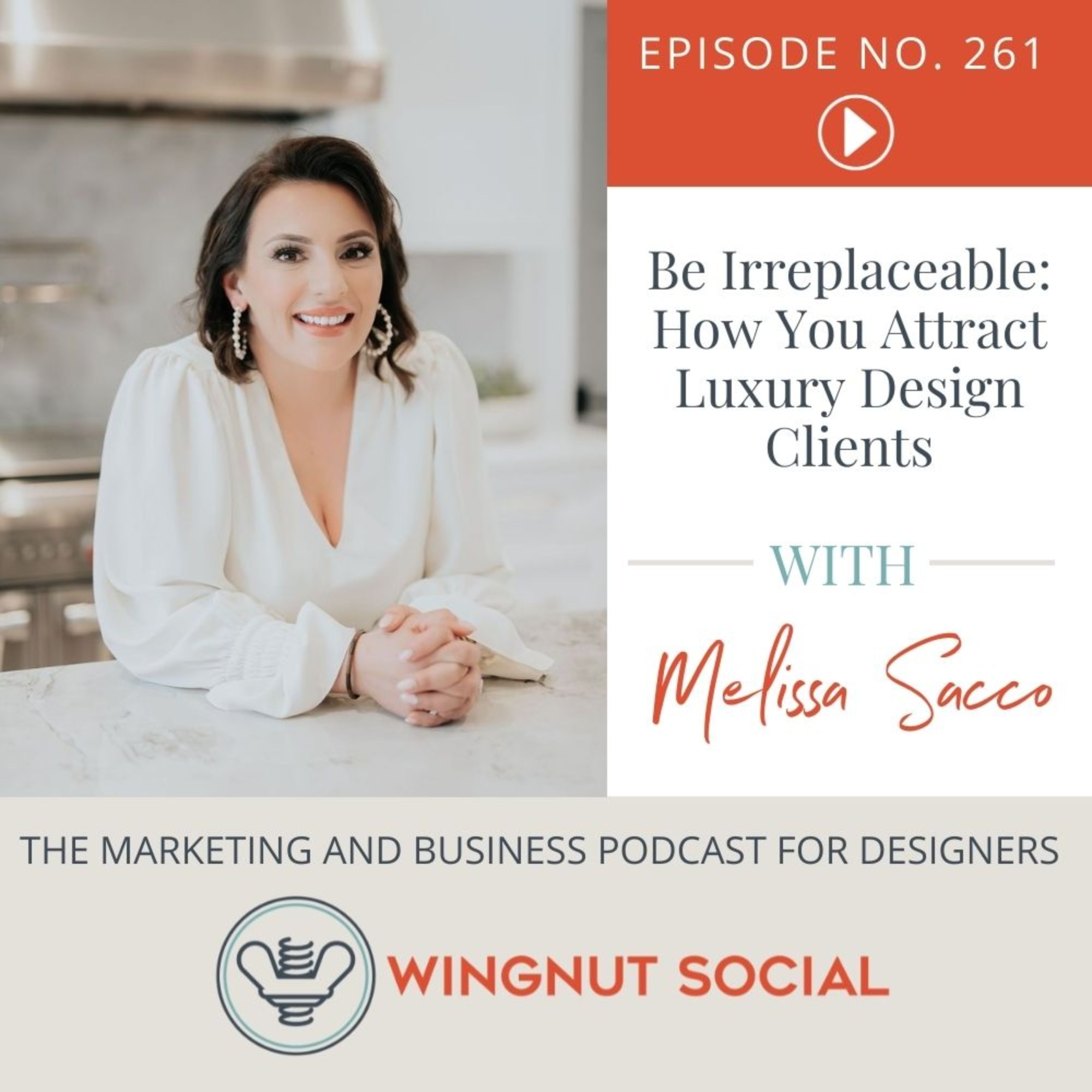
Be Irreplaceable: How You Attract Luxury Design Clients - Episode 261
What does it take to attract luxury design clients? HINT: It doesn’t require being pretentious. It has everything to do with offering irreplaceable value. What can you bring to a project that a client can’t find anywhere else? It’s about providing a luxury experience coupled with what’s uniquely you. In this episode of Wingnut Socal, Melissa Sacco shares what she offers to attract luxury design clients that no one else can. She’ll help you think through what makes you irreplaceable.
What You’ll Hear On This Episode of Wingnut Social
[4:43] Mini News Sesh: TikTok has stories!
[9:05] Learn all about Melissa Sacco
[11:41] Melissa’s business model
[18:37] How Melissa handles scope creep
[21:40] The key to attracting luxury design clients
[29:51] Specializing in high-end custom furniture
[33:36] What a discovery call with Melissa looks like
[35:05] Growing a business and delegating
[38:36] The What Up Wingnut Round!
[40:19] How to connect with Melissa Sacco
[44:29] Blooper Reel!
Connect with Melissa Sacco
Melissa Sacco Interiors
Follow Melissa on Instagram
Resources & People Mentioned
Get FREE Shipping on your first order from Article
Sign up for Wingnut Academy updates!
Check out the Google Ads webinar on April 26th at 11am
Rocket Fuel by Gino Wickman and Mark Winters
Working with luxury design clients
From the first meeting, Melissa educates her clients about the design process and what makes her uniquely qualified to tackle their projects. Sacco Interiors focus on creating an elegance that’s never pretentious. Everything in your home will be cohesive—full of texture, dimension, and detail.
When you offer high-end luxury design, you must always be ahead of the game. There are endless moving parts and decisions to be made. It involves working out details and kinks to get a clear vision of what you’re trying to achieve. Interior designers bring value by being knowledgeable in all of the trades. You provide scaled drawings, elevations, specification sheets, paint schedules, complete on-site visits, and much more.
Melissa gets to know her clients before she gets started with the design process. Her goal is for the client to be comfortable with her so she can nail their design. She’ll share images, ask deeper questions, and look at functionality—all with the goal to stay laser-focused throughout the project. Because once they start, they drive full force ahead. The only way that happens is if everyone is on the same page.
How Melissa attracts luxury design clients
Melissa believes to attract the right people, you have to share who you are. Melissa’s ideal client is someone who’s worked hard to get where they are. They are down-to-earth and genuine people—just like her. That’s why these clients want their homes to be comfortable. Most have demanding jobs. They want to come home, walk through their front door, and feel at ease.
So Melissa shares inspirational quotes. She gives potential clients a glimpse behind the scenes. Lastly, she focuses on just being herself. If she’s on a jobsite doing an install, she’s in sneakers and a sweatshirt. She’s on the floor opening boxes, putting things together, and getting her hands dirty. She does whatever it takes to ensure a client’s project is amazing in the end.
Don’t be fooled—high-end luxury clients are on social media. They’re people, just like anyone else. They’re professionals—doctors, lawyers, and CEOs of large companies. They talk. They network. They will share what you’ve done with other people.
Melissa’s irreplaceable customer furniture sets her apart
If you become one of Melissa’s clients, you will see custom built-ins and one-of-a-kind furniture pieces that no one else will have. Why? Because she designs them herself, each piece different from the last. No one will ever have the same chair or built-in. Melissa’s custom pieces have positively impacted her bottom line. It differentiates her from other high-end interior designers and works to continually attract her ideal client.
How did Melissa start offering custom furniture? What has she done to delegate tasks and projects as she’s grown her business? Listen to the whole episode to hear her process.
Connect With Darla & Wingnut Social
www.WingnutSocial.com
On Facebook
On Twitter: @WingnutSocial
On Instagram: @WingnutSocial
Darla’s Interior Design Website
Check out the Wingnut Social Media Lab Facebook Group!
786-206-4331 (connect with us for your social media marketing needs)
Subscribe to The Wingnut Social Podcast on iTunes, Google Podcasts, or TuneIn
Audio Production and Show notes by
PODCAST FAST TRACK
https://www.podcastfasttrack.com
45:1120/04/2022

How Designers Become THE Source for Luxury Flooring - Episode 260
John Dupra co-created Revel Woods, a platform that helps designers provide their clients with a luxury floor sourcing experience. Revel Woods elevates the traditional process so interior designers can offer a high-end service that can’t be replicated. In this episode of Wingnut Social, John shares how you can become a Revel Woods pro and become THE source for your client’s customer flooring (and maybe even create your own custom line of flooring).
What You’ll Hear On This Episode of Wingnut Social
[1:28] Webinar and Wingnut Academy Announcements
[4:12] Mini News Sesh: Instagram testing a new feed
[7:45] Learn more about John Dupra and Revel Woods
[12:53] The importance of offering a unique high-end experience
[21:17] Revel Wood’s training and certification program
[23:35] How to handle the relationship with your contractors
[27:22] How Revel Woods works with eCommerce partners
[30:27] Revel Woods is launching a NEW platform
[32:23] John’s take: The future of wood flooring
[42:40] The What Up Wingnut Round
[44:04] Where to learn more about Revel Woods
[47:10] Blooper Reel!
Connect with John Dupra
Revel Woods Fine Hardwood Flooring
Apply for Revel Woods Pro Account
Revel Woodson Instagram
Connect with John on LinkedIn
Resources & People Mentioned
Sign up for Wingnut Academy updates!
How Interior Designers Leave Money on the Table with John Dupra
Influence: The Psychology of Persuasion
The importance of offering a unique high-end experience
Sourcing floors typically includes taking clients to a flooring showroom they could have visited on their own. It’s been a necessary evil because there haven’t been options for designers to source trade options. Even trade-only showrooms offer brands available anywhere—unless you go truly custom and jump price levels. Most designers don’t need something that high-end.
John points out that you wouldn’t go to Bob’s discount furniture outlet to source furniture for a high-end client. Why would you do it for flooring? You don’t want to offer a service or experience they could’ve done on their own. Revel Woods is a platform that sources flooring for you. Some of it might be available elsewhere but they private label everything.
Create your own line of luxury hardwood flooring
Revel Woods is also developing a program with a manufacturer in Canada that will do a semi-custom made-to-order flooring. Flooring options are usually like the pizza aisle at the grocery store—you have premade cheese, pepperoni, supreme, etc. The program they’re developing is like a pizza shop where you choose your crust, sauce, cheese, and toppings.
You get to choose from 15 master colors, solid or engineered hardwood, and different widths, grades, lengths, and sheens. You can create your own collection exclusive to you and only available to your clients. They give you complete and total control over the process. John shares how pricing and wholesaling work, so keep listening.
Revel Woods is launching a NEW platform: Revel Woods Plus
Revel Woods is partnering with a major manufacturer to build a visualization platform. You can use sample rooms or take a photo of a client's room and swap the flooring out. It will be built into the Revel Woods platform with hundreds of private-label trade-only options only accessible to designers. You can use this tool to show a client what the flooring will look like in their room. You can also send them the link to the product (without pricing).
Fine hardwood flooring will never go out of style, but luxury vinyl planks have been the go-to flooring option of late. What does John think will be the next trend? His answer may shock and will certainly surprise you!
Connect With Darla & Wingnut Social
www.WingnutSocial.com
On Facebook
On Twitter: @WingnutSocial
On Instagram: @WingnutSocial
Darla’s Interior Design Website
Check out the Wingnut Social Media Lab Facebook Group!
786-206-4331 (connect with us for your social media marketing needs)
Subscribe to The Wingnut Social Podcast on iTunes, Google Podcasts, or TuneIn
Audio Production and Show notes by
PODCAST FAST TRACK
https://www.podcastfasttrack.com
47:3513/04/2022
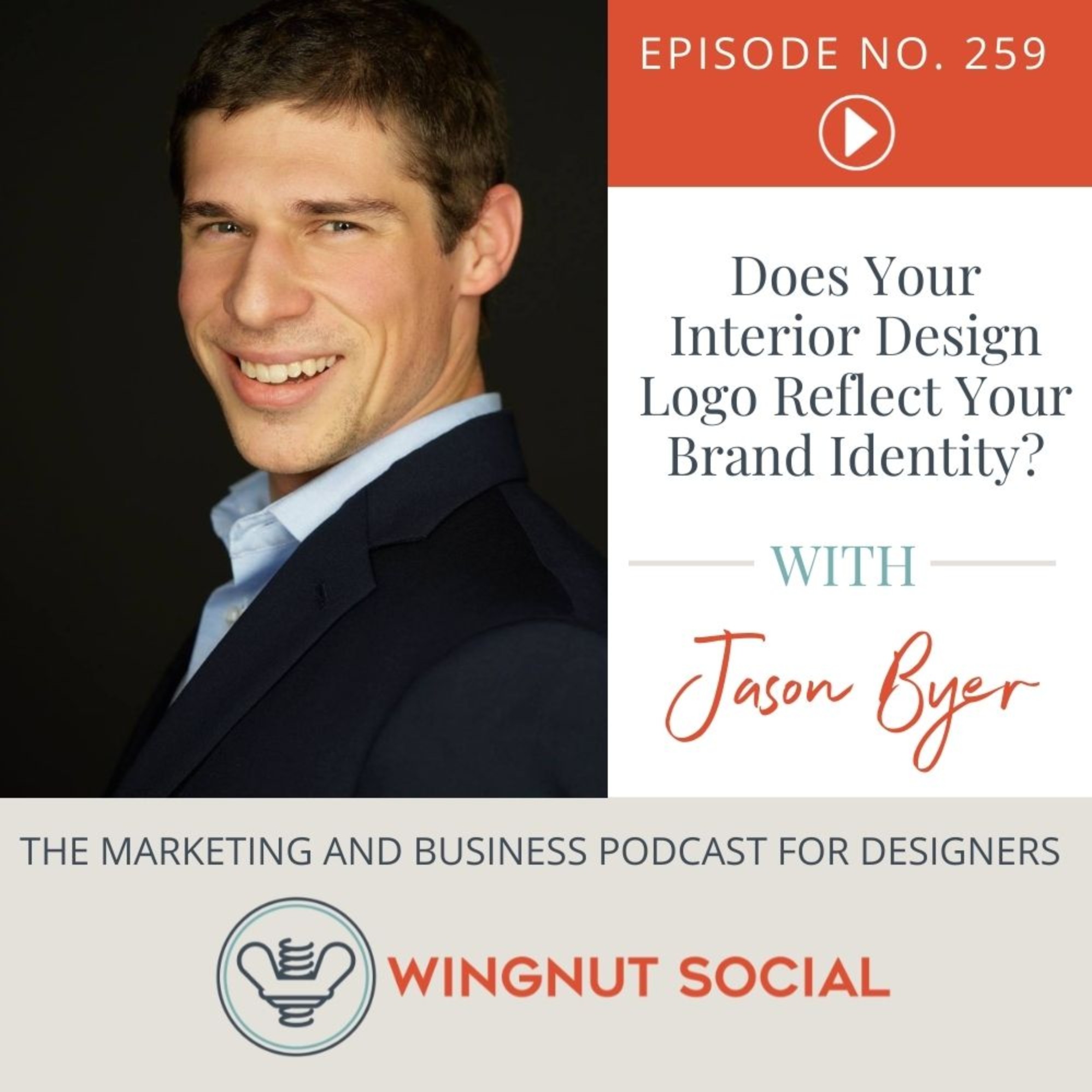
Does Your Interior Design Logo Reflect Your Brand Identity? - Episode 259
Your interior design logo is a direct reflection of you and your brand. If you wanted to hire a photographer but the photos on their website were blurry or out of focus, you wouldn’t hire them, right? As an interior designer or architect, you are being judged on your branding more than many other professions.
Jason Byer—the Marketing and Partnerships Manager at Crowdspring—shares that strong brands attract more customers, justify premium price points, and build more resilient businesses. Your logo is an important part of your brand identity—is it up to snuff? Find out in this episode of Wingnut Social.
What You’ll Hear On This Episode of Wingnut Social
[0:58] Wingnut Webinar and Wingnut Academy announcements
[3:04] Mini News Sesh: Moderator Feature for Instagram Live
[6:07] Learn more about Jason Byer
[8:28] How branding mistakes can negatively impact sales
[10:38] The difference between brand and brand identity
[13:31] The importance of your interior design logo
[24:07] How to properly complete a brand refresh
[32:10] The What Up Wingnut! Round
[33:56] How to connect with Jason Byer and Crowdspring
[37:23] Blooper Reel!
Connect with Jason Byer
Crowdspring
Follow Jason on Twitter
Connect with Jason on LinkedIn
Resources & People Mentioned
Check out the Google Ads webinar on April 26th at 11am
Get updates on Wingnut Academy
Why We Sleep: Unlocking the Power of Sleep and Dreams
The difference between brand and brand identity for interior designers
Branding is a loosely used term that people often associate with logos. But branding is every interaction that a customer has with your company, your product, and your service. We know what certain brands deliver, right? Amazon customer service is top-notch. With companies like Starbucks or McDonalds, anywhere you go, you know the product will be consistent.
It’s not the same for architects and interior designers. There are many unknowns about your brand, your service, your price point, and your success. But a potential client does know you’re trying to sell them something. So you have to think about every touchpoint someone has with you. Your brand is being shaped whether you take an active role or not.
Your brand identity is everything that people see—logos, backgrounds, and filters on social media, image choices on your website, etc. Your brand identity should be informed by your brand. Because it conveys who you are, an interior designer's logo needs to be spot-on.
A carefully crafted logo is key to consistent marketing of your design business
The human brain can process images 1,000x faster than text. Many people poorly communicate what they do and who they serve. But a logo communicates that immediately. But what makes your interior design logo shine?
Start with choosing the right color. You can easily Google the meanings of colors. The colors you choose are dictated by your brand and audience. If you want to create trust, you use the color blue. That’s why banks and financial advisors use blue. If you are serving the environment or want to create more profit you might use the color green. Red is used to make people pay attention. You want to think about how colors interact with your brand.
Shape, style, and negative space are other aspects to consider. How do you play with different elements in your design? Will you use hard or soft angles? Are you trying to communicate strength and stability—or a closer connection with clients?
The actual logo icon can be a wordmark: the name of your business stylized in a unique and custom way. You can pair an icon with your wordmark that allows you to scale it. Why? Because a wordmark doesn’t usually fit well within a square. Logos have to be able to scale if you want them to look professional. A symbol paired with your wordmark works well in this.
How to create an interior design logo that conveys your brand identity
All of these things communicate your brand, So where do you start? With a creative brief. A good designer will ask:
Who are your competitors?
Who is your audience?
What do you want them to know?
How are you differentiated?
Is trust more important than stability or growth?
After answering these questions, you’d look at color, shapes, and icons that communicate your message. When you package that together, someone should intuitively understand who your audience is within fractions of a second. That’s what a visual brand identity should do.
If red is your color, you could make it your schtick—but it may not resonate with how everyone else views the color red. Red signifies danger, it makes you stop. It’s important to leave your preferences at the door and think about your market. What will trigger the right emotion in your customers?
Jason emphasizes that “Your logo is there to create an emotion. And it’s there to create intrigue. And it’s there to create consistency across all of your marketing.”
How do you properly complete a brand refresh? Why should you hire a graphic designer instead of trying to create your logo yourself? Why should you avoid a logo generator at all costs? Jason answers all of your need-to-know questions about creating an interior design logo in this episode of Wingnut Social.
Connect With Darla & Wingnut Social
www.WingnutSocial.com
On Facebook
On Twitter: @WingnutSocial
On Instagram: @WingnutSocial
Darla’s Interior Design Website
Check out the Wingnut Social Media Lab Facebook Group!
786-206-4331 (connect with us for your social media marketing needs)
Subscribe to The Wingnut Social Podcast on iTunes, Google Podcasts, or TuneIn
Audio Production and Show notes by
PODCAST FAST TRACK
https://www.podcastfasttrack.com
37:4006/04/2022
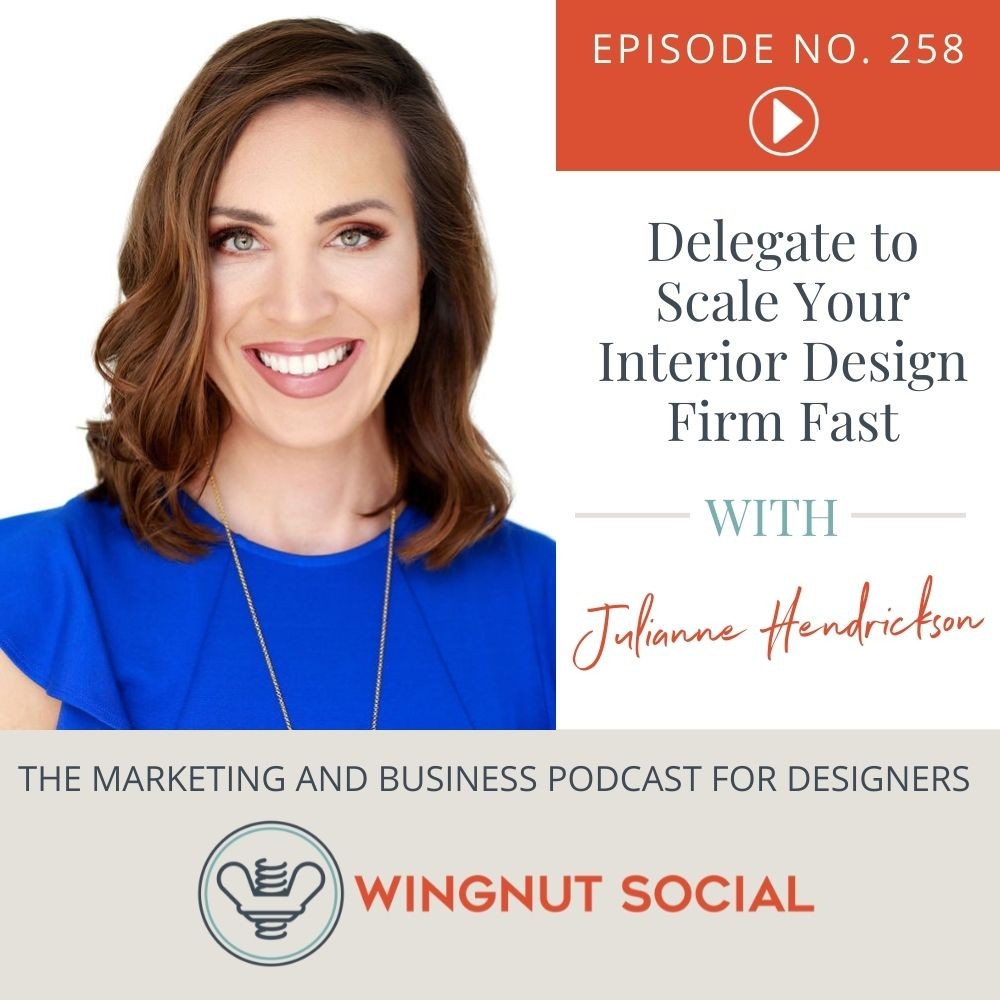
Delegate to Scale Your Interior Design Firm Fast - Episode 258
Hendrickson Interiors was born in 2016 when a friend asked Julianne to help design a new build. Julianne had no idea what she was doing but loved picking out pretty things. The builder loved her designs and hired Julianne to work together on more homes. Before she knew it, she had more clients than she knew what to do with.
Julianne had no business plan, no idea how to open an account with a furniture firm, and she was still teaching. After burning the candle at both ends for two years, Julianne decided to dive full-time into interior design. Since then, she’s grown from being a solopreneur to a team of six—a full-service custom interior design firm serving clients throughout Tampa Bay. She shares how she grew her team and learned to delegate in this episode of Wingnut Social!
What You’ll Hear On This Episode of Wingnut Social
[1:16] Check out our FREE webinars!
[2:55] Mini News Sesh: Updated Creator Tags
[6:10] Learn more about Julianne’s journey
[10:16] Julianne’s philosophy on delegating and hiring
[16:07] How to find a sweet spot with your waitlist
[19:20] Why Julianne hired a business coach
[21:36] Marketing before & After Wingnut Social
[25:56] What’s next for Hendrickson Interiors?
[28:34] Julianne’s strict budget
[30:51] The What Up Wingnut Round!
[32:29] How to learn more about Hendrickson Interiors
Connect with Julianne Hendrickson
Hendrickson Interiors
Find Hendrickson Interiors on Instagram
Resources & People Mentioned
Check out our FREE webinars!
Sign up for Wingnut Social Academy notifications
The Fred Factor by Mark Sanborn
Dakota Design Co.
Delegation is the key to scaling your business
Julianne admits that she’s a control freak by nature. She likes to do things her way. But she learned that someone else could do things just as well as her, even if their choices are slightly different. When Julianne released control, they were able to get more work done. As the process became smoother, she decided to keep hiring and making more people happy.
Julianne realized that you can delegate many different ways—it doesn’t have to be all or nothing. You can delegate someone to complete a task to be reviewed together. You can delegate through the design phase and review things together. Or you can delegate the design phase and review pricing together. Realizing this was eye-opening for Julianne. A good delegator knows how much someone is capable of. If you let someone do their job—without micro-managing them—it empowers them.
Building a time and hiring a business coach
Julianne’s first large client gave her $50,000 to work with and she went straight to a bookkeeper and said, “Oh my God—what do I do with this?” She didn’t have any business accounts or QuickBooks. Her bookkeeper took the reins and has been with her ever since. Julianne also hired an operations manager (who handles the warehouse), a project coordinator, and someone who handles accessory purchasing full-time. Her most recent hire was a part-time team member to handle purchasing and tracking orders. Once Julianne had these people in place, she pulled herself out of the weeds. Then she hired a business coach.
As a business owner, it’s easy to get enmeshed in the day-to-day of the business. Julianne’s business coach, Katie, has helped her gain a top-level view of her business. Katie helped Julianne walk through their design process from beginning to end. She pointed out missing pieces, helped her reformat things, and wrote every single thing Julianne gives a client. She has templates for everything—delayed items, trade days, apology letters, and more. It keeps the entire team on the same page, which is what elite clients want. It’s also important to scale and grow a team. A business coach can help unify your team and improve your efficiency.
How to find a sweet spot with your waitlist
Hendrickson Interiors is operating on a waitlist of six months or longer. When Julianne gets information from an inquiry, she’ll know if the potential client is a good fit immediately. Julianne is honest with people and lets them know if they’ll be on her waitlist. The clients that are worth it will wait. If they can’t wait, they’ll shop around until they can find someone that will do it the fastest—but it may not be the best quality. Julianne isn’t worried about turning down work because she knows the right people are already waiting for her.
How has Julianne’s interior design business grown since working with Wingnut Social? How does operating on a strict budget help her continue her upward trajectory? She shares more about her uber-successful design firm in this episode!
Connect With Darla & Wingnut Social
www.WingnutSocial.com
On Facebook
On Twitter: @WingnutSocial
On Instagram: @WingnutSocial
Darla’s Interior Design Website
Check out the Wingnut Social Media Lab Facebook Group!
786-206-4331 (connect with us for your social media marketing needs)
Subscribe to The Wingnut Social Podcast on iTunes, Google Podcasts, or TuneIn
Audio Production and Show notes by
PODCAST FAST TRACK
https://www.podcastfasttrack.com
36:2830/03/2022
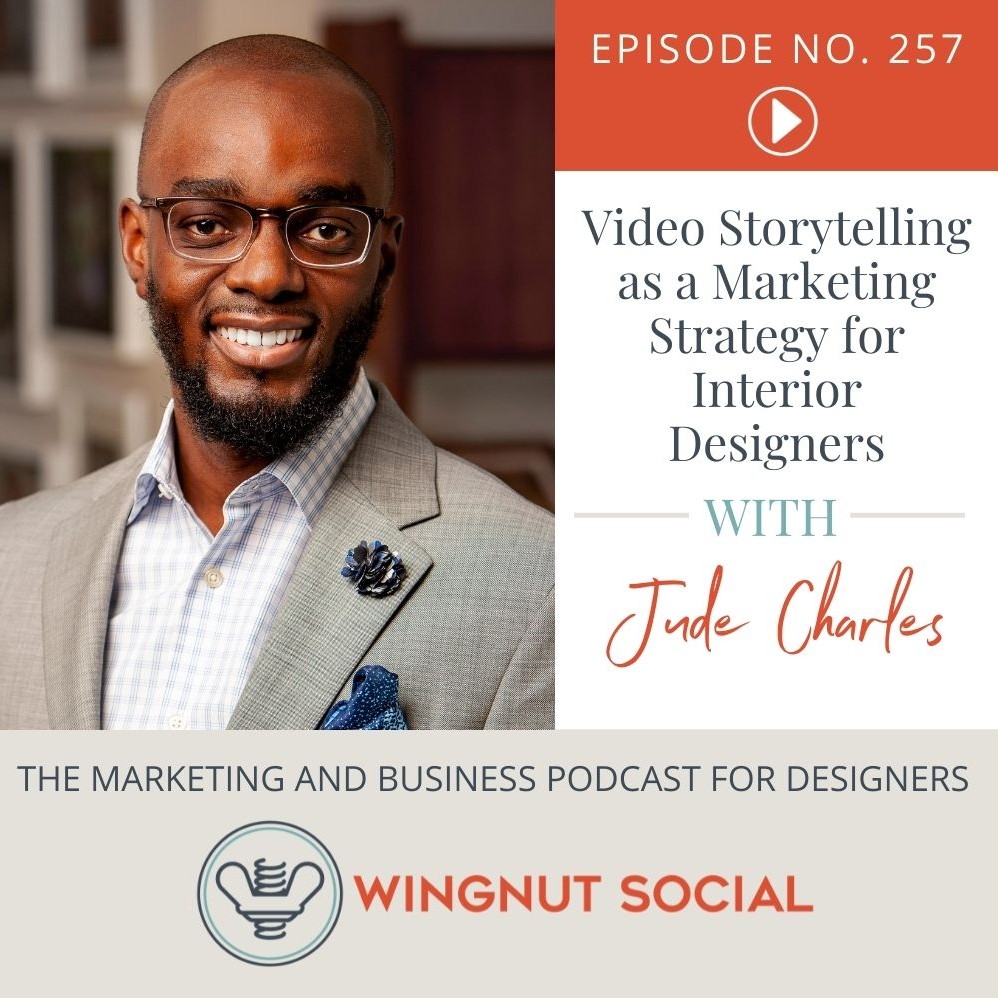
Video Storytelling as a Marketing Strategy for Interior Designers - Episode 257
When Jude Charles was 17, he took a video production class. At the end of the year, Jude’s teacher handed him a yellow envelope and told him that he had to start a business. Inside was his first set of business cards. Since then, Jude has dedicated his life to helping purpose-driven entrepreneurs tell their stories. He firmly believes that “Stories aren’t just how we connect as people and human beings but story is what differentiates you from someone else.”
In this episode of Wingnut Social, Jude emphasizes that you have to start sharing your story. Video storytelling breaks through the noise and sets you apart. Jude shares how to overcome the intimidation factor, what type of stories to tell, and shares the best way to structure your story. Don’t miss it!
What You’ll Hear On This Episode of Wingnut Social
[0:58] Check out our FREE webinar with Stacey Martin
[2:56] Mini News Sesh: Instagram’s Visual Discovery Tool
[7:14] Learn more about videographer Jude Charles
[11:19] Overcoming the intimidation of video
[15:30] Dramatic demonstration of proof
[20:24] The importance of relatability in video content
[24:04] Why you should just hit the record button
[29:26] Jude’s videography tips for YouTube
[31:54] Make testimonials part of your contract
[36:12] The What Up Wingnut Round!
[38:58] How to connect with Jude Charles
[42:07] Blooper reel!
Connect with Jude Charles
Head on over to Jude’s Website
Sign up for Jude’s Newsletter
Connect with Jude on LinkedIn
Resources & People Mentioned
Sign up for Updates for Wingnut Academy
March 24th at 11 am: Stacey Martin Webinar
Hot Seat by Jeff Immelt
Not Fade Away by Peter Barton
Overcoming the intimidation of video
Jude points out that everyone has three different stories that can be shared at any point. These stories are important to use every day on social media. You can repeat them over and over again. What are they?
Your origin story: How you got into the business you're in.
A transformational story: Testimonials, case studies, before & afters, etc. What does life look like after?
Why you’re doing the work you’re doing: Why should someone choose you over anyone else?
But how do you get started? Jude has been a guest on over 70 podcasts. He’s studied storytelling for over 20 years. He still listens to himself tell his story so he can find new ways to tell it. It also helps him learn how to connect better with an audience. If you rehearse your story and practice recording it, it makes it less intimidating.
Jude’s video storytelling method: dramatic demonstration of proof
You can’t just sit in front of a camera and tell your story. That’s boring, right? The way that you make your story interesting is by using the five different types of demonstrations:
Behind the scenes: What happens as you’re sourcing materials? What does the design process look like? What is going on that people don’t usually get to see?
Live illustration: How do you illustrate a point someone may not understand? Jude worked with someone who said, “Construction is like a puzzle.” So they got a large puzzle—of a project they had completed—and had the team put a puzzle together.
Social proof: This is testimonials, case studies, before and afters, etc.
Transformation: These are before and afters—how someone’s life is transformed after a change has been made.
Unique mechanism: What makes you unique that someone else can’t copy? How can you demonstrate that on camera?
Storytelling is about a specific moment in time. These moments have led you to where you are today. They influence how you’ve become a great designer. Jude points out many people believe that their story isn’t unique or interesting—that no one will care. But what debunks the idea that no one cares? Telling your story. You’ll realize that there will be someone it resonates with.
Jude believes so strongly in the power of video storytelling that he only takes on five video production clients a year. Why? Because he works to understand who they are on a deep level. It takes time to be able to get to know someone and accurately portray the essence of who they are with video storytelling.
Why you should just hit the record button
Record yourself telling a story. Record yourself telling the story that you take for granted. Jude emphasizes that you shouldn’t sell yourself short—or overthink it. Your clients aren’t aware of everything you do to get a project completed. You want to create content so people understand what you do and can appreciate the value that you create. What you do will be different from the next interior designer. So where do you start?
Just document what you’re doing every day to get in the habit of creating content. You don’t need fancy equipment to get started because every smartphone is equipped with a great camera. You don’t even have to share it on social media. If you share a video of your process with a potential client, it makes them trust you more. It’s not only social proof but it’s a sales tool. You’ve made them part of the journey. Hearing something said 1,000 times is not as powerful as seeing it once.
Listen to the whole episode to hear Jude’s video storytelling tips for content on different social media platforms, including YouTube.
Connect With Darla & Wingnut Social
www.WingnutSocial.com
On Facebook
On Twitter: @WingnutSocial
On Instagram: @WingnutSocial
Darla’s Interior Design Website
Check out the Wingnut Social Media Lab Facebook Group!
786-206-4331 (connect with us for your social media marketing needs)
Subscribe to The Wingnut Social Podcast on iTunes, Google Podcasts, or TuneIn
Audio Production and Show notes by
PODCAST FAST TRACK
https://www.podcastfasttrack.com
42:2523/03/2022
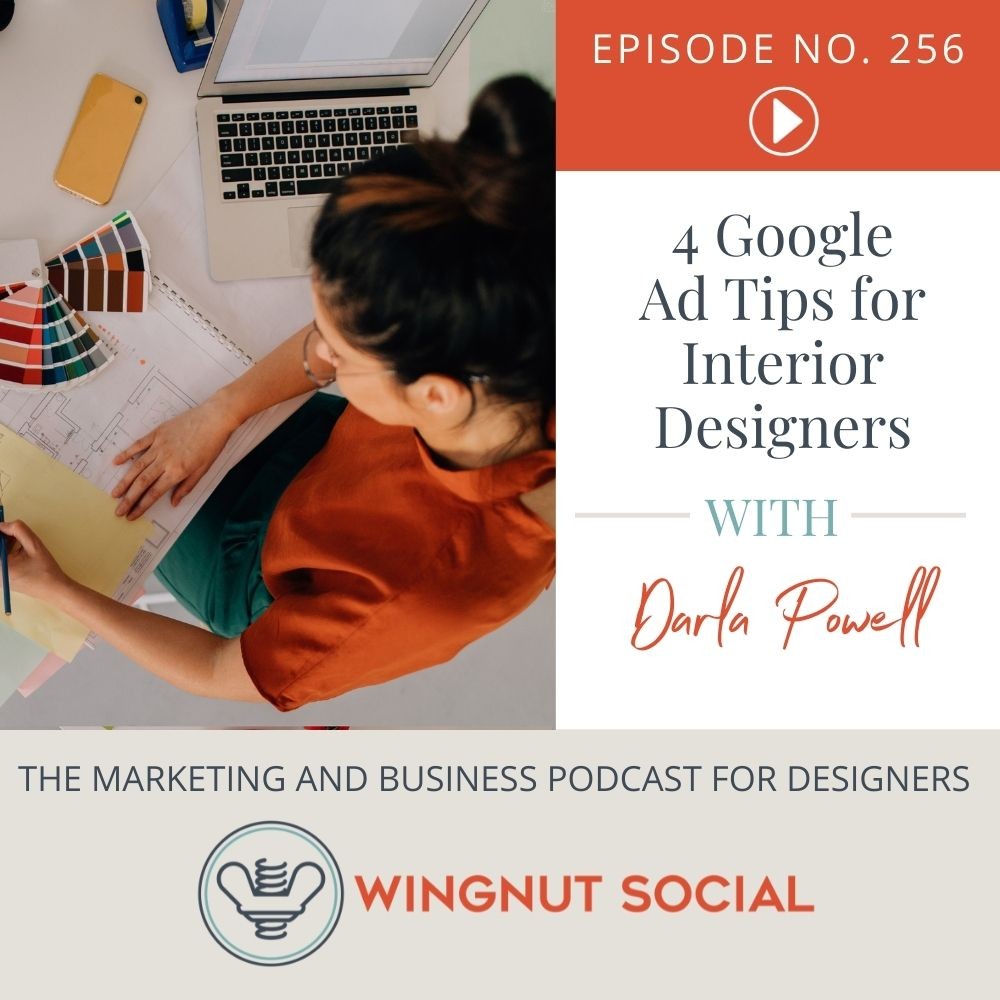
4 Google Ads Tips for Interior Designers - Episode 256
What is a Google ad? How can you leverage Google ads to drive leads to your interior design business? How do you stand out against your competition? In this solo episode of Wingnut Social, Darla dives into the need-to-know basics of Google ads. It’s a great strategy—in conjunction with SEO—to drive traffic to your website and help you build your business.
What You’ll Hear On This Episode of Wingnut Social
[2:02] March 24th at 11 am: Stacey Martin Webinar
[3:07] Mini News Sesh: The Career Gap feature on LinkedIn
[5:47] Your marketing strategy: Google ads and SEO
[8:17] Tip #1: Control what your audience sees with ad extensions
[15:16] Tip #2: Leverage keywords in Google ads
[17:08] Tip #3: Create a high-quality ad
[20:40] TIp #4: Be specific
[25:01] Blooper Reel!
Resources & People Mentioned
March 24th at 11 am: Stacey Martin Webinar
Episode #250 with Stacey Martin
A good marketing strategy should leverage Google ads and SEO
When you search on Google, the first four or five results say “ad” in the top left corner. Usually, you’ll see results related to the topic you searched for. Advertisers pay to get their ads on the page for that search.
Google ads are a great way to cut in line and get on the first page of Google and it’s a whole lot faster than SEO. SEO is still heavily important. You want the right keywords placed in particular places on your website. Why? So when someone searches for “Interior Designer Philadelphia” your business is in the top 10 search results.
But proper SEO is a time-consuming process. It’s a long game, not a quick win. You have to invest a lot of time and often money to begin to see traction (sometimes it takes over a year). It’s a necessary evil—you have to do it—but Google ads are a great way to gain some traffic to your site now.
If your ad is structured properly, for the right amount of money, you can show up on the top of the first page. So when someone searches for “Susan McNuggets Interior Designer” they’ll find you. Even if your SEO is on par and you’re #1 in the search results, ads will still be placed above your business. That’s why ads are a great way to beat out the competition.
Tip #1: Control what your audience sees with ad extensions
At the top of the search results, you’ll see your headline. Underneath that, you’ll see categories that are called site extensions (i.e. for “Wingnut Social” you’ll see “podcast,” “social media marketing agency,” etc.). Google is searching the organic copy of your website and making the site extensions how they see fit.
But when you place an ad, you can dictate what the ad extensions will be. If I placed an ad for Wingnut Social, I don’t want “What’s happening” showing up on my ad. I want searchers to see how we can help them. I want to draw them to the website. You need to make sure whoever is creating your ad uses the proper extensions.
There are different types of extensions:
Phone numbers: This will show the phone number plainly in the ad
Location: This is super important if you’re relying on local traffic to find your design firm
Image: When your ad shows up you see the square image to the right (too many people don’t use this!)
Leveraging the ad extensions helps you get more qualified leads because someone is getting the information they need at first glance. If your ad is eye-catching and people click on it, Google will deem your ad more relevant. If that happens, sometimes Google will place your ad higher—even if you’re paying less.
Tip #2: Leverage keywords in Google ads
What keywords are people typing in the search bar that YOU want to be discovered for? These words NEED to be used in your ad. You can leave out flowery phrases like “The most luxurious designer” and focus on “Interior Designer Miami.” Keep the keywords in your ad straightforward. Secondly, make sure you use the keyword(s) in your title and description.
How do you find keywords? Google has a handy keyword planner you can use to look up keywords and see how many people are searching for a keyword. If the search volume is too low, Google won’t bother showing it.
Tip #3: Create a high-quality ad
Where you rank on the results page can be bid on. You can outbid a higher-quality ad if you shell out more money. But it’s better to create a high-quality ad and pay less, right? Google looks at your quality score to determine how much you have to pay for your ad and how often they’ll show it.
A higher quality score will pay less for clicks because it enhances the user experience. Google wants people to get the results they’re searching for. It must be relevant. If that means showing your ad at $10 because the experience is better, it’s taken into consideration. If you have a lower score, you’ll pay more for the same exposure!
What do they look at to determine your quality score?
The speed at which your landing page loads
How relevant your landing page is to your Google ad
The keywords you’re optimizing your ad for on your landing page
The most important aspect is the click-through rate. What is that? It’s how many people clicked on your ad. The average CTR in the home industry is 1.79%. So out of every 100 impressions, 1.79 of them are clicking on your ad. If a lot of people are clicking on your ad, you’ll get a higher score.
Tip #4: Be specific
Don’t try to rank for something generic that has heavy competition. What do you do? What is your positioning? What differentiates you from your competition? What is the experience someone can expect working with you? Choose something searchable. Don’t niche down so far into keyphrases that no one searches for. To master this, you have to do keyword research. It’s a lot of work but it can be lucrative when done right.
Connect With Darla & Wingnut Social
www.WingnutSocial.com
On Facebook
On Twitter: @WingnutSocial
On Instagram: @WingnutSocial
Darla’s Interior Design Website
Check out the Wingnut Social Media Lab Facebook Group!
786-206-4331 (connect with us for your social media marketing needs)
Subscribe to The Wingnut Social Podcast on iTunes, Google Podcasts, or TuneIn
Audio Production and Show notes by
PODCAST FAST TRACK
https://www.podcastfasttrack.com
25:2516/03/2022
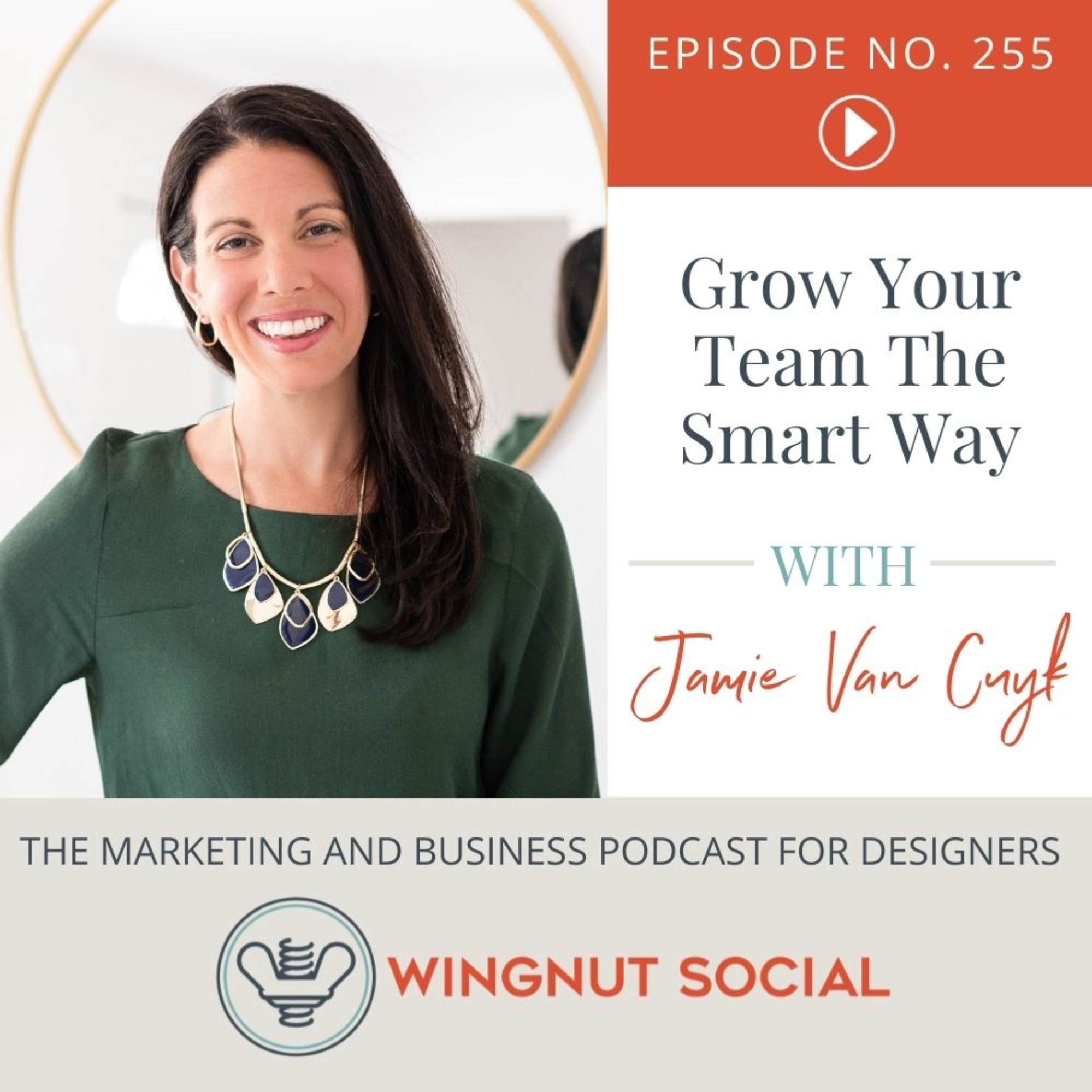
Grow Your Interior Design Team The Smart Way - Episode 255
Is it time for you to grow your team? What are the signs it’s time to hire another team member? What process should you use to hire the best candidate for the job? Jamie Van Cuyk—the owner and lead strategist of Growing Your Team—is an expert in hiring and onboarding teams within small businesses. She shares some spectacular tips and strategies that you can implement immediately to grow your team the right way.
What You’ll Hear On This Episode of Wingnut Social
[1:05] Check out our next webinar with Stacey Martin!
[3:03] Mini News Sesh: TikTok rolling out LONG videos
[6:28] Learn more about Jamie Van Cyuk
[9:36] 4 signs it’s time to hire another team member
[13:54] Is your waitlist working for you—or against you?
[16:11] How to craft the perfect job description
[22:37] How to afford the help that you need
[27:20] Myth-busting: Should you hire for passion over skill?
[30:15] How to ensure someone is the right hire
[38:42] Jamie’s opinion on the use of personality tests
[42:27] How many candidates should you interview?
[45:50] The What Up Wingnut! Round
[49:03] How to connect with Jamie Van Cyuk
[53:40] Blooper Reel!
Connect with Jamie Van Cyuk
Growing Your Team
Friend on Facebook
Follow on Instagram
Check out her Pinterest
Connect on LinkedIn
Resources & People Mentioned
Check out our next webinar with Stacey Martin!
Stacey Martin’s Formula for Rockstar Interior Design Presentations
Turn the Ship Around! by David Marquet
Easy Render
4 signs it’s time to hire another team member
Jamie shares that there are 4 things to watch out for that are clear signs you need to grow your team. But they aren't things that are normally top of mind during your day-to-day work. So Jamie recommends that you review these signs quarterly to see if it’s time to hire:
Are you saying no to your ideal clients? If you’re saying no because your team is at capacity, it’s a problem. These people want to give you their money today. You don’t want to be losing clients that are the ideal fit for your business.
Are you losing customers due to poor customer service? Are customers pulling out of projects or backing out of contracts? If you’re not communicating and meeting their expectations throughout the process, you not only lose their business but you lose them as a referral source.
You want to do something new but you can’t. Maybe you want to start offering coaching, education, or open a retail store but you can’t because you don’t have time.
You lack skill or knowledge that is needed in your business. You can go and learn something yourself—or you can hire for that skillset. Are you the right person to learn and execute that skill? Sometimes paying the expert is worth the money because it lets you spend your time where it should be focused.
Once you’ve decided it’s time to grow your team, what are your next steps? A great hiring process.
How to craft the perfect job description (and where to post it)
Jamie believes that you shouldn’t use a templated job description when creating a job description. The job post may attract someone who can do the skill you’re hiring for but likely doesn’t speak to the right fit for your team and culture. Their style and personality have to mesh with you and your team values. So what do you do? Walk through these questions:
What is your ideal candidate?
What are their roles and responsibilities?
What does success look like in your business?
Who will you be happy to give your money to?
What’s unique about your company?
What will make someone say, “Yes, this is the place for me!” The goal of a job posting is to attract the right candidate and turn away the wrong ones. Once you develop your ideal person your job posting should speak to that person.
You can design a room that you love. But is that the right room and right design for every client? No! It might not work in their home. You may use the same concepts, materials, and create a similar flow but things will look different. A role might have similar responsibilities but will look different in each company.
Where is the best place to post a job opening? Should you hire for passion over skill? Listen to hear Jamie’s take.
How to ensure someone is the right hire
Ask questions that produce answers of value. You need to reduce the number of hypothetical questions you use, i.e. “What would you do if…?” Instead, ask questions that have them support their answers with examples: “So tell me about a time when…?” Ask them about something they will experience working for your business. Have they worked with high-end, demanding clients? How did they handle the experience? If you’re hiring someone entry-level, they may not have had those experiences in an interior design company but have had similar experiences where they have worked. They can transfer those skills to your business.
Develop a case study or opportunity for them to present their skill. If they say they know how to do CAD drawings, give them everything they need to sit down and complete a quick project. What are they able to put together? You have to know what you’re testing them on. Are you testing their ability to think through the information they’re given? Their ability to use a tool? Their thought process? You can’t test them on something that aligns with your brand because they don’t know that yet.
Move through the process quickly. Align a case study with an interview so they knock out everything immediately. But Jame is careful to note that you can’t ask too much of them before you’ve spent time with them. Don’t waste their time—and yours—if they won’t make it to the next round of interviews anyway.
What’s an easy way to weed talent out of the process (not necessarily in a good way)? Should you use personality tests in your hiring process? How many candidates should you interview? Jamie covers these questions—and so much more—in this episode!
Connect With Darla & Wingnut Social
www.WingnutSocial.com
On Facebook
On Twitter: @WingnutSocial
On Instagram: @WingnutSocial
Darla’s Interior Design Website
Check out the Wingnut Social Media Lab Facebook Group!
786-206-4331 (connect with us for your social media marketing needs)
Subscribe to The Wingnut Social Podcast on iTunes, Google Podcasts, or TuneIn
Audio Production and Show notes by
PODCAST FAST TRACK
https://www.podcastfasttrack.com
54:2409/03/2022
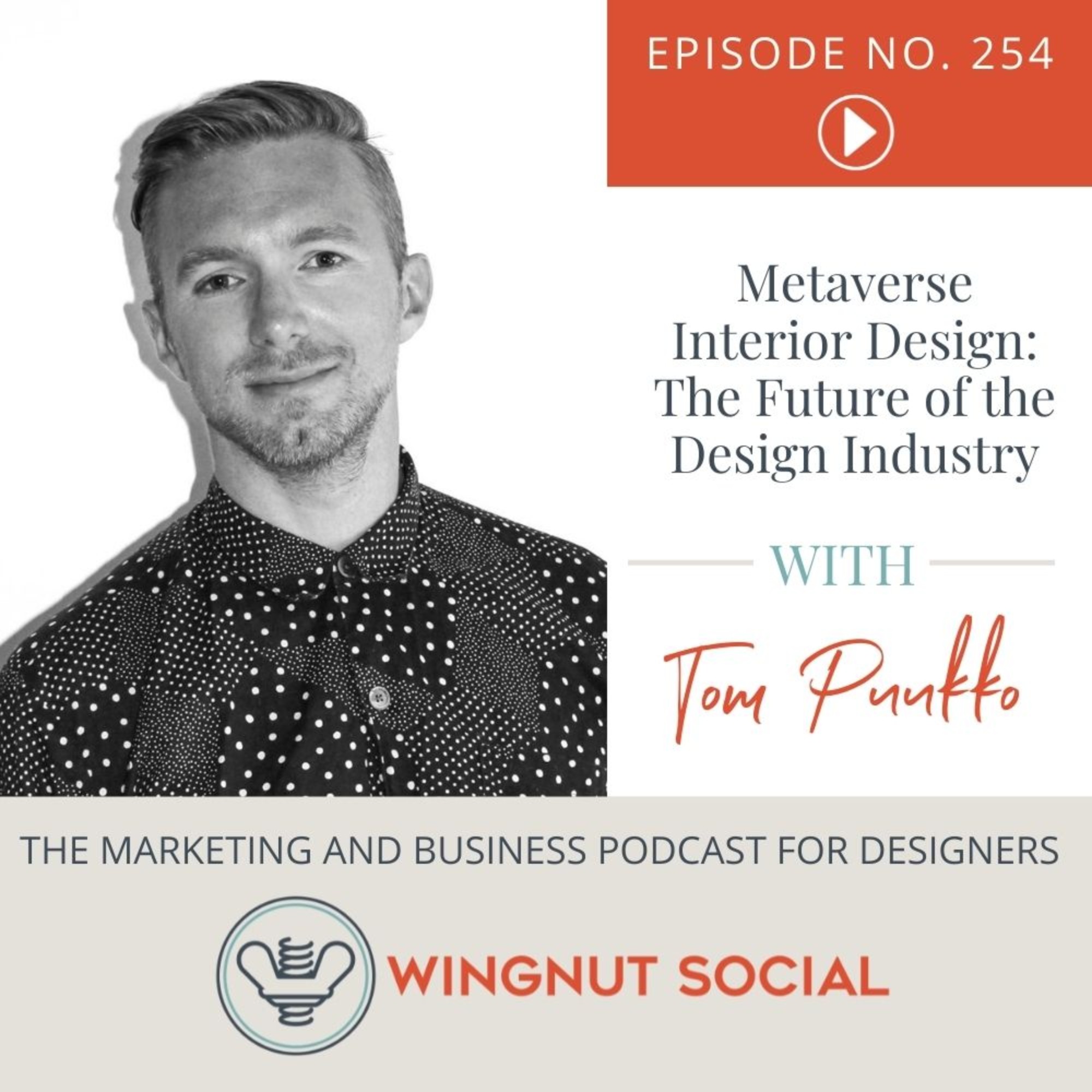
Metaverse Interior Design: The Future of the Design Industry with Tom Puukko - Episode 254
What is the metaverse? How will the metaverse impact the interior design industry? Is designing a virtual world the future of architecture and design as we know it? Tom Puukko joins Darla in this episode of Wingnut Social to have a conversation about virtual architecture and design. Don’t miss this futuristic conversation!
Tom is a British entrepreneur who's been working in digital innovation since 1998. He founded interiors brand Feathr.com, a marketplace where artists monetize their artworks as wallpapers and fabrics. Most recently, he's created Metaverse Interior Design, the world's first interior design marketplace for the metaverse.
What You’ll Hear On This Episode of Wingnut Social
[1:40] Upcoming webinar with Stacey Martin
[2:55] Mini News Sesh: Instagram reels from stories
[5:12] Learn more about Tom Puukko
[9:00] Learn the basics of the metaverse
[15:24] How the metaverse impacts the interior design industry
[19:16] The necessary skills to succeed in the metaverse
[24:04] Is metaverse design the design of the future?
[26:51] Where designers and architects should get started
[29:53] NFTs and Cryptocurrency in the metaverse
[33:03] The What Up Wingnut! Round
[34:17] Learn more about Tom and Metaverse Interior Design
[38:22] Blooper Reel!
Connect with Tom Puukko
Metaverse Interior Design
Feathr.com
Connect on LinkedIn
Follow on Twitter
Resources & People Mentioned
Check out our next webinar with Stacey Martin!
Stacey Martin’s Formula for Rockstar Interior Design Presentations
Good to Great by Jim Collins
Oculus Quest 2
The Sandbox
Decentraland
Horizon Worlds
Unity
Blender
So what IS the metaverse?
The metaverse consists of 3D worlds where you can interact and live a digital life. You can choose a life that’s richer, more engaging, and more entertaining than a 2D platform. You can do almost all things that you can in the real world—gamble at casinos, dance at nightclubs, visit an art gallery, build a home, etc.
Currently, you’re able to experience the metaverse through some sort of headset. We currently have proto-metaverses—the early inklings of what’s to come. If you’re in the US, you may have access to Meta’s Horizon Worlds or Decentraland. But these worlds still lack functionality and the renderings are underwhelming. But the seeds of what will come have been planted.
So how is the metaverse applicable to interior designers and architects?
Metaverse interior design: the impact on the interior design industry
Digital technology has allowed architects and interior designers to connect with customers and market themselves transactionally. But the metaverse will open up a whole new world. The metaverse is currently being built but the people building it are coders. They don’t understand how spaces and subjects interact. They don’t understand how proportions can change a building. They don’t have the knowledge architects and interior designers are trained with. Because of this, the current experience in a metaverse feels like a gimmick.
Architects and designers should be the people designing and creating the spaces. Doing so will create a whole new revenue stream. There’s no limitation of the potential volume that can be put into the space. You can sell multiple versions of different models. Designers become content creators. You can sell spaces to hundreds of thousands of people. Tom’s community—Metaverse Interior Design—will be the destination to source interior design and architect services and products.
The necessary skills to succeed in the metaverse
Luckily, metaverse interior design doesn’t necessarily rely on coding. But designers do need to have an advanced understanding of how 3D models work. If you are competent with 3D modeling and own space in a metaverse, you can move a 3D model from a computer to the metaverse. The challenge in moving between the real world and metaverse design is understanding the technical limitations of space.
Each “world” has its own set of technical specifications. Tom points out that it all boils down to low poly count (polycount is the total number of polygons found in a three-dimensional model). 3D models in the real world have a high polycount. Currently, everything in the metaverse must be simplified to a lower polycount. So you have to learn how to take a 3D model and simplify it.
Just as in real-world design, you must understand the creative vision of the client and make their vision a reality in the space you have to work with. The limitations of the real world—building codes, fire regulations, gravity, etc.—can go out the window in the metaverse. People will buy creative and conceptual ideas that can't exist in the real world. Design in the metaverse is both artwork and architecture.
Is this the design of the future? Where should designers and architects get started? Learn why you should become an early adopter of metaverse interior design in this episode!
Connect With Darla & Wingnut Social
www.WingnutSocial.com
On Facebook
On Twitter: @WingnutSocial
On Instagram: @WingnutSocial
Darla’s Interior Design Website
Check out the Wingnut Social Media Lab Facebook Group!
786-206-4331 (connect with us for your social media marketing needs)
Subscribe to The Wingnut Social Podcast on iTunes, Google Podcasts, or TuneIn
Audio Production and Show notes by
PODCAST FAST TRACK
https://www.podcastfasttrack.com
38:5702/03/2022
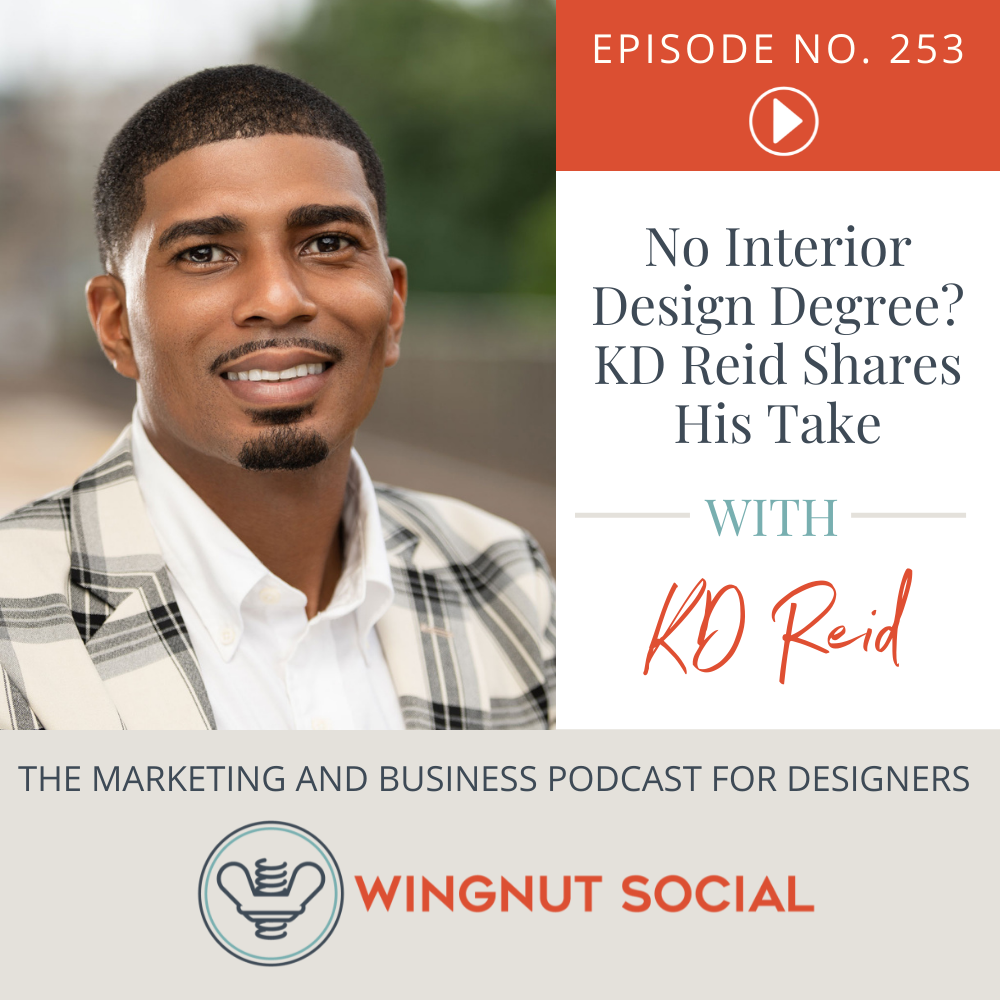
No Interior Design Degree? KD Reid Shares His Take - Episode 253
Do you need an interior design degree to successfully run an interior design firm? If you don’t get a formal education, where do you get an education? KD Reid is a successful interior designer with a passion for art and architecture and a reputation for crafting beautiful and functional spaces. Guess what? Zero formal design education. He shares how he grew from intern to business owner in this episode of the Wingnut Social podcast!
What You’ll Hear On This Episode of Wingnut Social
[1:24] Check out our FREE photography webinar
[2:40] Mini News Sesh: Liking stories on Instagram
[5:50] Learn all about interior designer KD Reid
[9:21] A unique way to gain interior design experience
[14:53] How KD broke out on his own
[17:51] Advice for designers without an extensive network
[19:50] How KD delegates large projects
[24:54] Where KD’s innate talent stems from
[26:52] Where will KD’s future lead?
[29:21] The What Up Wingnut! Round
[30:41] How to learn more about KD
[33:27] Blooper Reel!
Connect with KD Reid
KD Reid Interiors
Follow KD on Instagram
Resources & People Mentioned
FREE Webinar with Linda Holt on 2/24: How to Take Magazine-Worthy Smartphone Photos
Dekar Design
Mikel Welch
B Squared Harlem
Gail Doby Coaching
Parsons Yellowbrick Program
Dapper Dan: Made in Harlem: A Memoir
From Craigslist to creator
KD graduated with a degree in Sociology from Montclair State University. After graduating, he spent eight years providing mental health services in the LGBT community. Throughout his career, interior design was a hobby he enjoyed. But he never saw it as a lucrative career path. He would design spaces for friends and family.
At a time when Craigslist was popular, KD came across some design internship opportunities. He'd snag one here and there which allowed him to learn some interior design skills. Then he came across Dekar Design, a woman-led design firm focusing on hospitality and commercial projects. It was his first real look into the world of interior design. They saw that he had an eye for design and immediately let him jump on projects and learn hands-on.
KD’s journey from design assistant to principal interior designer
After working with Dekar Design, KD had the opportunity to meet Mikel Welch. One of Mikel’s first projects in NYC was a Harlem restaurant called B Squared. KD had the opportunity to work on the project which led to working with Mikel for five years. He started as a design assistant, transitioned to project manager, and became a lead designer.
Mikel gave him hands-on experience and allowed him to learn other facets of interior design. KD got to dive into set design, staging, virtual merchandising, and more. This job gave him the confidence he needed to take on projects by himself. Because of COVID, many people in KD’s network wanted to invest in building out home offices, which propelled KD to start his own business.
Where will KD’s future lead? KD wants to be clear that he is not anti-education. He simply learned that it’s not necessary to find success in the industry. But KD has goals. To reach them, he’s attending Parson’s Yellowbrick Design Program to take a product design course. One of his strengths is home decor, accessories, and styling. They’re the jewelry of a space, right? KD’s dream is to launch his own home accessory line.
What is KD’s advice for designers who don’t have an extensive network? What does his team look like? What marketing strategy does he employ? Listen to the whole episode to learn more!
Connect With Darla & Wingnut Social
www.WingnutSocial.com
On Facebook
On Twitter: @WingnutSocial
On Instagram: @WingnutSocial
Darla’s Interior Design Website
Check out the Wingnut Social Media Lab Facebook Group!
1-786-206-4331(connect with us for your social media marketing needs)
Subscribe to The Wingnut Social Podcast on iTunes, Google Podcasts, or TuneIn
Audio Production and Show notes by
PODCAST FAST TRACK
https://www.podcastfasttrack.com
33:5323/02/2022
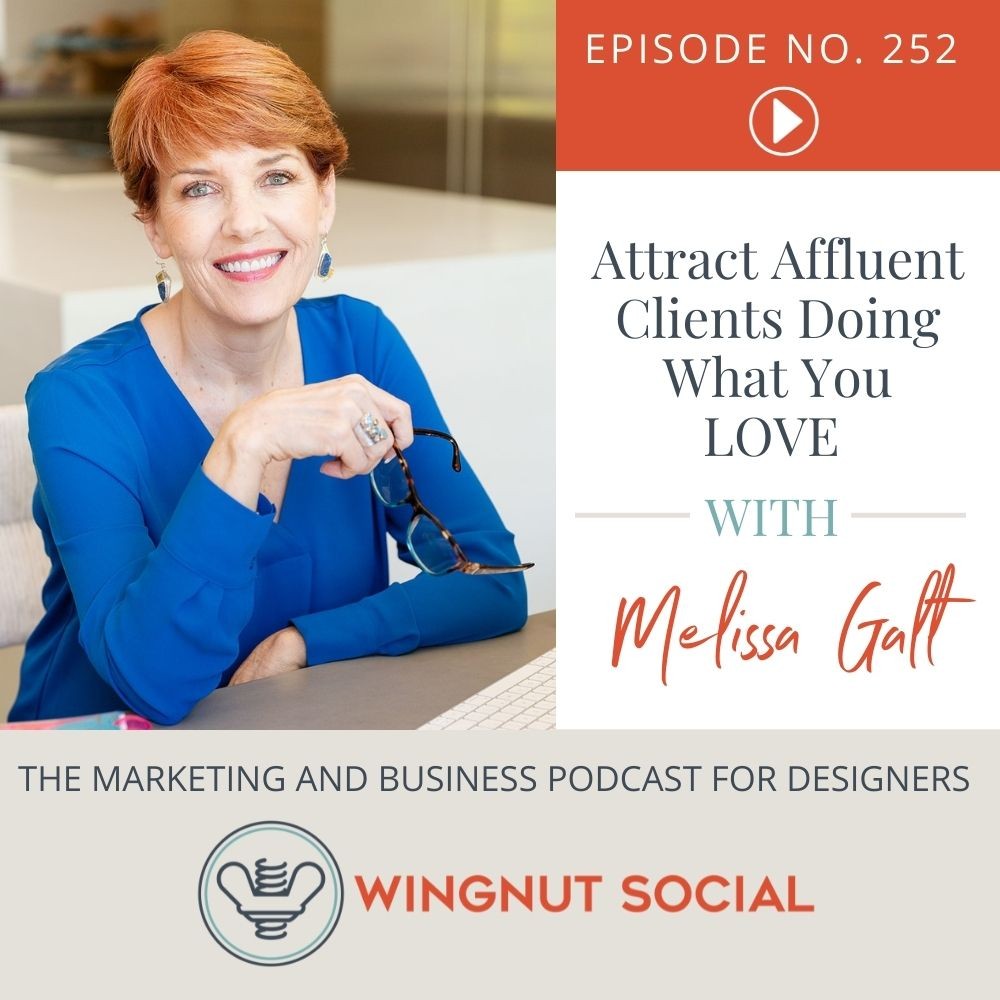
Attract Affluent Clients Doing What You LOVE with Melissa Galt - Episode 252
Are you an interior designer just clamoring to work with the rich and famous? Do you want to be the designer to the stars? If you’re ready to work with affluent clients, Melissa Galt is the business coach to turn to. She loves the business of design more than design itself, which is why coaching is 95% of her business. She helps designers learn how to earn more in less time—and love their businesses a whole lot more in the process. In this episode of Wingnut Social, she shares the unique strategy she uses to attract her ideal clients (HINT: It’s all about doing what you love).
What You’ll Hear On This Episode of Wingnut Social: Interior Design Podcast
[1:23] Check out our FREE photography webinar
[3:27] Mini News Sesh: Pinterest’s augmented reality feature
[6:15] Learn more about Melissa Galt
[9:02] The top three personas of affluent clients
[17:32] The key to attracting affluent clients
[20:18] How to determine a persona’s value system
[23:55] What these clients look for when hiring a designer
[25:52] How to work smarter, not harder
[29:19] Hooking affluent clients on social media
[35:25] The What Up Wingnut! Round
[36:40] How to connect with Melissa Galt
[40:32] Blooper Reel!
Connect with Melissa Galt
Melissa’s website
Connect on LinkedIn
Follow on Instagram
Get Melissa’s book
Resources & People Mentioned
FREE Webinar with Linda Holt on 2/24: How to Take Magazine-Worthy Smartphone Photos
It's Not How Good You Are, It's How Good You Want to Be by Paul Arden
The top three personas of affluent clients
Most affluent clients aren’t obvious. In many cases, they’re the ones that are earning and saving. They are selective in where they invest their money. Melissa has nailed down five groups of avatars and nine overall personas of affluent clients based on personal experience. What are the three most common she’s come across?
The “millionaires next door.” These are the clients that are easy to educate on why next-level services are warranted. They are always learning and growing their knowledge base. They are grounded, down to earth, and make the best choices for themselves. They are the perfect clients to have because they’re loyal.
The “got rich quick.” These are the fast spenders. They’re often star athletes, musicians, startup entrepreneurs, etc. They tend to select things that are flashy and lower-quality. Melissa’s tip? Make sure they pay you upfront. Melissa has had multiple clients who were swindled out of their money.
The “Sinks and Dinks.” They are either single-income or dual-income families with no kids. Kids are a large investment, right? When you don’t have them, it makes a huge difference. Melissa’s best clients were sinks and dinks.
You select your clients as much as they select you. Melissa emphasizes that “It doesn’t matter how much money I make if I’m not proud of it.” Rich or not—choose wisely.
How to work smarter—not harder—to attract your ideal client
You need to be clear on your ICP and only work to attract those clients. The millionaires next door are low-key, private, and confidential. Marketing to them is going to be far different than the fast-spenders who are flashy in everything they do. You have to choose one persona to chase to position yourself correctly in the market.
Then you need to get clarity on where to meet and connect with your avatar. Who is already serving them that isn’t competing with you? Then you work to build your own circle of influence (or what Melissa likes to call your “Profit Posse”) and connect with these people. Co-market, co-promote, and create opportunities for introductions.
Another simple strategy? Look at your lifestyle. What do you like to do? What if you took that to the next level? If you love wine-tasting, skip the free tasting and shell out for the $250 dinner with wine pairings. You’re far more likely to rub elbows with affluent clients there. Melissa considers this “net-living” not networking. She states that “Doing what you love at a higher level will deliver the affluent clients that you most want in a very aligned and authentic way.”
How do you determine a persona’s value systems? What do affluent clients look for when hiring a designer? How do you hook them on social media? Check out the whole episode to learn more!
Connect With Darla & Wingnut Social
www.WingnutSocial.com
On Facebook
On Twitter: @WingnutSocial
On Instagram: @WingnutSocial
Darla’s Interior Design Website
Check out the Wingnut Social Media Lab Facebook Group!
1-786-206-4331 (connect with us for your social media marketing needs)
Subscribe to The Wingnut Social Podcast on iTunes, Google Podcasts, or TuneIn
41:1316/02/2022
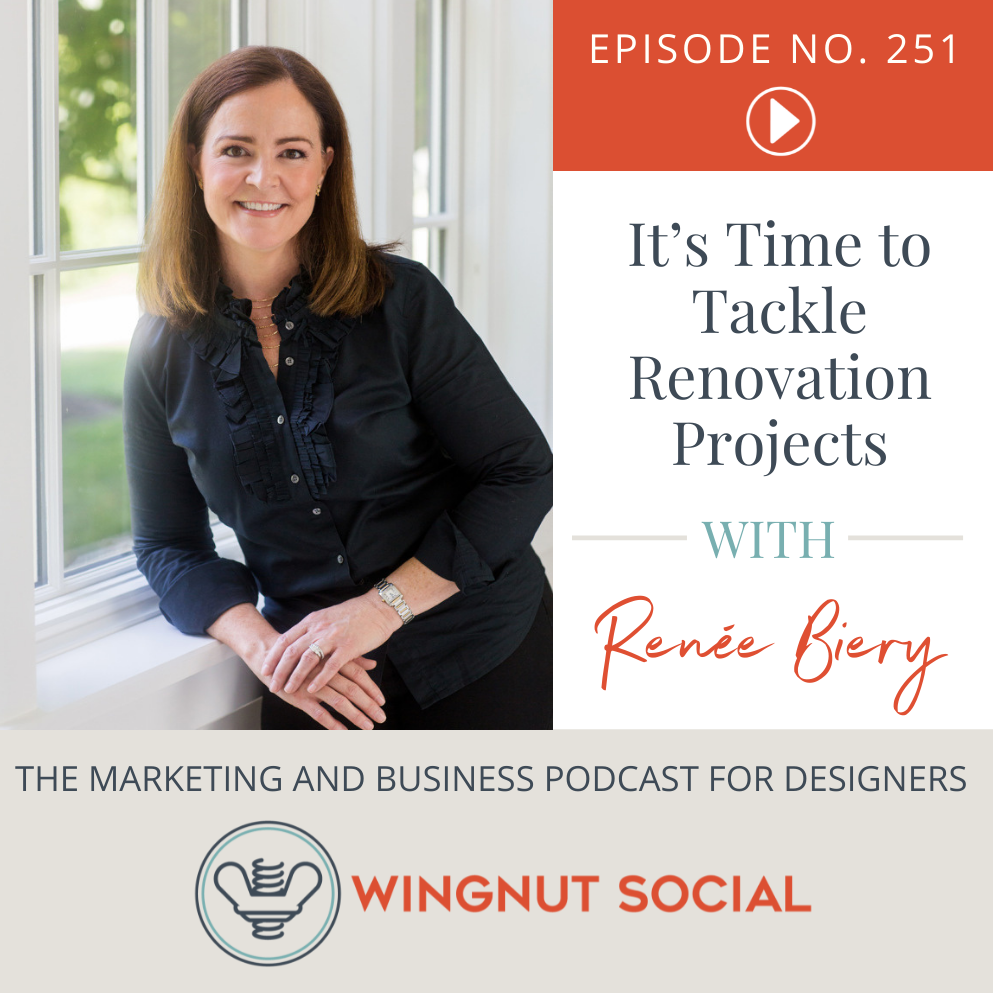
It’s Time to Tackle Renovation Projects with Renée Biery - Episode 251
When Renée Biery entered the interior design industry, she thought everyone did renovations. It wasn’t until she moved back home to Delaware that she realized she—especially as a woman—was the anomaly. She had to work hard to show how much value she could add to a renovation project for both the client and the contractors. She believes that Interior designers CAN and should do more. In this episode of Wingnut Social, she shares how you can learn to master those tricky renovation projects (and the clients that come with them).
What You’ll Hear On This Episode of Wingnut Social
[1:25] Check out our FREE photography webinar
[3:30] Mini News Sesh: Scheduled live displays on Instagram
[5:10] Learn more about Renée Biery
[7:29] Why you should be an expert in project management
[15:33] Why don’t more designers take on renovation projects
[23:46] How this business model can fill your pipeline
[26:26] How Renée charges for her projects
[30:10] Market your services with social media + networking
[36:55] The What Up Wingnut round!
[38:22] How to learn more from Renée Biery
[44:35] Blooper Reel!
Connect with Renée Biery
Only Girl on the Jobsite podcast
Only Girl on the Jobsite course
Follow Renée on Instagram
Friend on Facebook
Resources & People Mentioned
FREE Webinar with Linda Holt on 2/24: How to Take Magazine-Worthy Smartphone Photos
Atomic Habits by James Clear
The Book of Boba Fett
Why you should become proficient in project management
As the owner of deVignier design, Renée has almost 30 years of experience in the industry. She’s formally trained in practical interior architecture with advanced technical and rendering proficiency. She sought to be a one-stop-shop that offers everything from project management and design to decorating. She loves being part of the design and build. It also sets her apart from other women in the industry.
Despite her formal education, Renée believes that it isn’t necessary nor should it be a barrier to entry. She learned more from the women she’s worked with over the years. You simply learn as you go. You can find contractors, architects, etc. who will work with you to get a permit or draw a design.
Renée believes that offering renovation projects will sustain the industry. Why? Because procurement is becoming a problem. Many firms are giving up that revenue stream. But what does that leave them? There are only so many billable hours in design. If you’re trying to salvage your billable hours, managing renovation projects is a great way to get started.
Why don’t more designers take on renovations?
Renée believes that many designers lack confidence in their skills. Plus, it can be intimidating. Everyone watches HGTV and every episode of any show features some great challenge to overcome. Those challenges get expensive. That’s why Renée encourages people to gain experience in numerous ways. She started “The Only Girl on the Jobsite” because as the only woman among 20 guys on a worksite, you feel like the odd man out. So you have to build skills to level the playing field.
Where do you get your feet wet? Do you intern under someone with the experience necessary? Some people have renovated their own spaces and feel comfortable learning as they go. Plus, if you have some experience, you can build on it. Price yourself at an obtainable level until you’ve built a portfolio. There will be clients that are excited about getting a great price and don’t mind that you’re learning. But above all, do not fake it til you make it or you’ll end up making expensive mistakes.
Taking on renovation projects sets you apart and gives you a leg up. What else can you do to break the mold? If you decide to add renovations and project management to your portfolio, how do you market yourself? Renée shares a plethora of advice in episode #251—don’t miss it!
Connect With Darla & Wingnut Social
www.WingnutSocial.com
On Facebook
On Twitter: @WingnutSocial
On Instagram: @WingnutSocial
Darla’s Interior Design Website
Check out the Wingnut Social Media Lab Facebook Group!
1-786-206-4331 connect with us for your social media marketing needs)
Subscribe to The Wingnut Social Podcast on iTunes, Google Podcasts, or TuneIn
Audio Production and Show notes by
PODCAST FAST TRACK
https://www.podcastfasttrack.com
45:1209/02/2022

Stacey Martin’s Formula for Rockstar Interior Design Presentations - Episode 250
Interior design presentations are not easy to knock out of the park. If you’ve spent hours on a presentation only to receive a lackluster response from a client, you’re not alone. Stacey Martin has a mind-boggling 95% approval rating—without revisions—on her presentations. What’s the secret to her success? She shares the mind-blowing systems and processes she uses in this episode of the Wingnut Social podcast!
What You’ll Hear On This Episode of Wingnut Social
[2:07] Check out our FREE photography webinar
[3:15] Mini News Sesh: Subscriptions on Instagram
[7:22] Learn more about Stacey Martin
[12:02] Stacey’s interior design presentation
[20:44] Brand storytelling is the key
[26:06] Feeling out a client’s budget
[30:42] 3 pitfalls to avoid in your presentations
[34:53] The What Up Wingnut Round!
[40:38] Blooper Reel!
Connect with Stacey Martin
Follow Stacey on Instagram
Stacey’s design business: The Freshmaker
Resources & People Mentioned
FREE Webinar with Linda Holt on 2/24: How to Take Magazine-Worthy Smartphone Photos
BOOK: The Legacy of Luna
BOOK: How to Win Friends and Influence People
Nikki Amodio
Take your potential clients on a journey
Before Stacey became an interior designer, she was in trend forecasting and design for sports brands. The higher-ups were notorious for being naysayers—many designers didn’t get their designs approved. But Stacey soon realized that the blame wasn’t always on the management. The designers didn’t know how to present their ideas in a manner that would get them a “yes.”
So Stacey took note. When it was her turn to present, she started with the “why.” She started her presentation focusing on the brand’s pain points before she shifted to the goals of the line. By the time she got to her ideas and solutions, the VP had already been agreeing with everything she said. She took him on a journey.
She sold him on why her idea was the solution to their problems. He knew how it would lead them to make them more money. When Stacey transitioned to interior design, she used this same process with her clients.
It’s about the design AND the client
In addition to hearing someone’s design woes, Stacey asks questions that are NOT related to design. She wants to learn who they are.
What music do they like? Favorite song? Favorite band?
Where do they like to travel? What are their favorite trips? Where do they want to visit?
What do they do for fun? Do they like to cook? Is yoga their jam?
Do they have kids or pets?
These things help Stacey build a visual story and build an aesthetic direction. She distills what she’s learned down to three images that define the direction they’ll take. So when they get to the design presentation, she knows who they are and what problems they want to solve.
How to nail your interior design presentation
She labels their project with three keywords that hone in on the goal for the design. It might be modern, timeless, and family-friendly. This sets the tone for the presentation. She iterates the problem they’re looking to solve (i.e. lack of storage space) and shares her solution.
Stacey may include a “tortoise-shell side table” as a nod to this person’s trip to Aruba where they swam with sea turtles. As she explains the choices she made, she talks specifically about how each element reflects and solves their problem(s). The details tie back to their memories and things that make them happy. It’s creating a story about who they are and how the room reflects their personality.
The more you can show your client the “why” of your selections and how you’re making choices based on who they are, the more they feel understood. That leads to trust. Every piece is a thoughtful choice based on who they are. As a designer, Stacey emphasizes that “You’re using your talents and your skillset to curate those choices to create an immersive environment that really feels like who they are.”
What are three pitfalls you should avoid in your presentations? Listen to the whole episode for more of Stacey’s strategy.
Connect With Darla & Wingnut Social
www.WingnutSocial.com
On Facebook
On Twitter: @WingnutSocial
On Instagram: @WingnutSocial
Darla’s Interior Design Website
Check out the Wingnut Social Media Lab Facebook Group!
1-786-206-4331 (connect with us for your social media marketing needs)
Subscribe to The Wingnut Social Podcast on iTunes, Google Podcasts, or TuneIn
Audio Production and Show notes by
PODCAST FAST TRACK
https://www.podcastfasttrack.com
41:2202/02/2022
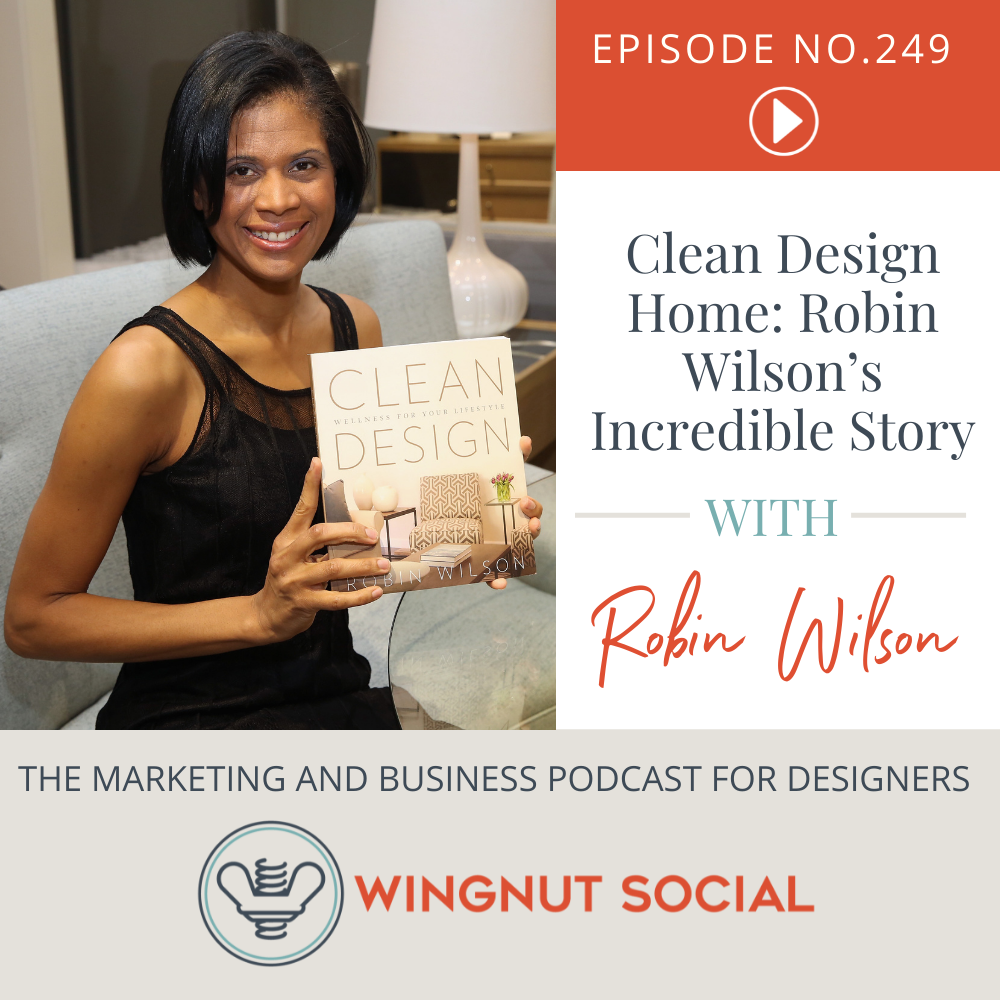
Clean Design Home: Robin Wilson’s Incredible Story - Episode 249
Robin Wilson grew up in Austin, TX with awful asthma and allergies. Her parents found a holistic pediatrician that said, “You can raise a strong child or you can raise a child on strong medicine.” So she started swimming, biking, walking, track, etc. to strengthen her lungs instead of taking strong medication. Because of her background, she became an advocate for clean construction. Any number of things on a site can lead to an asthmatic episode. So she dove deep into hypoallergenic design.
Now, Robin Wilson is a U.S. lifestyle brand, author, designer and real estate developer. Named to the Inc. magazine Female Founders 100 List in 2020, she is a world-class thought leader on hypoallergenic, sustainable and eco-conscious options for the B2B and B2C marketplace. She is a two time #1 Amazon bestselling author and has been featured on multiple news segments as an expert on eco-friendly design and allergy-focused segments.
What You’ll Hear On This Episode of Wingnut Social
[4:29] Mini News Sesh: Vertical Stories on Instagram
[6:40] Designer Robin Wilson’s origin story
[14:21] Robin’s thoughts on design school
[22:20] From project management to Clean Design Home
[33:42] Robin’s marketing process
[36:47] Clean Design Home x Martex
[47:57] How Robin’s marketing focus has shifted
[54:38] The What Up Wingnut! Round
[56:50] How to connect with Robin Wilson
[58:45] Blooper Reel!
Connect with Robin Wilson
See an overview of Robin’s company at https://ablueegg.com/
Robin’s Book: Clean Design: Wellness for your Lifestyle
Clean Design Home x Martex
Follow Robin Wilson Home on Instagram
Resources & People Mentioned
Photography webinar coming up Feb. 24th!
Wingnut Social Episode #12 with Linda Holt
The Dream Giver by Bruce Wilkinson
Resource Furniture
Robin’s story: following her passion
Robin had a wonderful mentor/sponsor that helped her navigate her future. He asked her, “What would you do if you knew you could not fail?” followed by, “What is your passion?” Her answer was real estate. So he taught her how real estate worked and how to build wealth. She went on to get her Master’s in Real Estate Finance. She was one of three women in the graduate program.
One of her professors told her that she wasn’t going to have an easy road because she was a black woman in a man’s world. Instead of being offended, she decided to listen to him. He advised her to figure out something she could do immediately to make her degree worth something. He recommended she become a project manager—the busy homeowners’ best friend. She made $1.2 million in her first year in project management.
From project management to Clean Design Home
Part of Robin’s design signature started because she worked on tiny New York apartments that had doors everywhere. So she started implementing pocket doors in her design. On one particular project, she bought a Murphy bed that looked like a desk. She found a table that expanded to fit six people. She treated this client like royalty, not realizing she had connections in the industry.
After this project, Robin got a phone call from Adam Glassman, the creative director for Oprah. She didn’t return his phone calls because she thought she was being pranked. He called three times before she realized it was the real deal, so she called him back. One project changed the trajectory of her future career.
Robin firmly believes, “If you do great work, people will tell four people. If you do poor work and you’re nasty, mean, and rude—they will tell 20 people at a dinner party…If you do great work they will tell someone that’s a likely customer in the future.”
Clean Design Home
Clean Design Home came about when Robin wrote her book, “Clean Design: Wellness for your Lifestyle.” It became a #1 best-seller on Amazon. Clean design is everything she does. She puts clean products in people’s homes. She supports hypoallergenic lifestyles.
Robin had a legacy brand, Robin Wilson Home. But she saw a shift in consumer spending from paying for quality to paying for cheaper products on Amazon. She felt her brand was gone and she was close to quitting. But Robin ended up being featured in articles about the top 10 black businesses to support.
She changed to a generic name (Clean Design Home) to speak to her niche. She dug deep into the hypoallergenic space and created luxury products. She found a licensing partner and saw a 3,000% sales increase after the New York Magazine article. She made $80,000 in 30 days. Then she was signed by West Point Home (Martex) and they created “Clean Design X Martex.” In 2020, she was ready to quit. Now she has a global brand in Macy’s.
What does Robin believe was the secret to her success? How has Robin’s marketing focus shifted since she launched her businesses? What tips does she share to help your business grow? Listen to the whole episode to hear more of her awe-inspiring journey.
Connect With Darla & Wingnut Social
www.WingnutSocial.com
On Facebook
On Twitter: @WingnutSocial
On Instagram: @WingnutSocial
Darla’s Interior Design Website
Check out the Wingnut Social Media Lab Facebook Group!
1-786-206-4331 (connect with us for your social media marketing needs)
Subscribe to The Wingnut Social Podcast on iTunes, Google Podcasts, or TuneIn
Audio Production and Show notes by
PODCAST FAST TRACK
https://www.podcastfasttrack.com
59:0726/01/2022
![Change Your Mindset—Raise Your Rates [Danielle Hayden] - Episode 248 Change Your Mindset—Raise Your Rates [Danielle Hayden] - Episode 248](https://pbcdn1.podbean.com/imglogo/ep-logo/pbblog3132020/WSPodcast_LI_PodbeanGraphic_episode248_Danielle_Hayden_4gz9v6.png)
Change Your Mindset—Raise Your Rates [Danielle Hayden] - Episode 248
Does the thought of raising your rates leave you saying “Uh-uh, no way?” Are you worried that the covid-induced interior design “bubble” may pop? What if you raise your prices and the bubble does burst? These questions contribute to the mindset struggles designers face when considering raising their rates. So how do you determine if you should make a change? In this episode of Wingnut Social, Danielle Hayden shares some exercises that can help you make the decision.
Danielle is a reformed CFO on a mission to help rule-breaking female entrepreneurs understand their numbers to gain confidence to create sustainable profits. She’s the co-owner of Kickstart Accounting, where she helps her clients with bookkeeping, financial analysis, and provides education to help them make informed decisions.
What You’ll Hear On This Episode of Wingnut Social
[3:22] Mini News Sesh: An algorithm-free Instagram feed?
[8:20] Learn more about Danielle Hayden
[15:28] Thinking about raising your rates? Do these exercises.
[22:50] Determining your take-home pay depends on your goals
[30:12] It’s time to change your mindset about raising your rates
[36:47] The What Up Wingnut! Round
[41:38] Blooper Reel!
Connect with Danielle Hayden
Kickstart Accounting Inc.
Connect with Danielle on Instagram
The Entrepreneur Money Stories Podcast
Resources & People Mentioned
Built to Sell by John warrilow
Wingnut Social Episode #26
Thinking about raising your rates? Do these exercises.
Exercise #1: How much of your time and energy goes into a single project? What are your average operating expenses per month? Multiply the time you spend in your business by your hourly rate. Add your operating expenses to that number. This is your break-even number. Divide that by your number of clients each month. This gives you an idea of whether or not you’re profitable.
Secondly, what are your goals? Is it your goal to outsource parts of your business, such as social media or bookkeeping? Do you want to be hands-on with every project? Or do you want to oversee a team of designers? What will that cost you?
Grab a piece of paper now and add up how many clients you need to take on to hit the numbers you need to reach your goals. You may see that if you don’t raise your rates, you’ll never meet those goals. It’s a clear way to see whether or not you need to raise your prices.
Exercise #2: Danielle recommends that you go into your accounting system and run a P&L report for the last 24 months. Looking at your history helps you determine your average spend per account and what you need to spend to keep your business moving forward. Your history helps determine the steps you take today.
Change your mindset about raising your rates
If you don't want to raise your rates, that’s okay. But think about your goals. What if you can serve fewer clients at a higher price tag and be happier doing it? You may lose a client in the short term but the long-term impact will be worth it. Your mindset will change. The client paying more for your service will value you and your brand.
Darla doubled her rates after she gained some experience which helped her land more clients. Their perception of her value increased with her rates. You don’t have to make a bold move like Darla’s. Figure out what works and what doesn’t, track the numbers, and make an adjustment. There’s no such thing as failure—there is learning and growing. Changing your mindset and changing your rates can be transformative.
Connect With Darla & Wingnut Social
www.WingnutSocial.com
On Facebook
On Twitter: @WingnutSocial
On Instagram: @WingnutSocial
Darla’s Interior Design Website
Check out the Wingnut Social Media Lab Facebook Group!
1-786-206-4331 (connect with us for your social media marketing needs)
Subscribe to The Wingnut Social Podcast on iTunes, Google Podcasts, or TuneIn
Audio Production and Show notes by
PODCAST FAST TRACK
https://www.podcastfasttrack.com
41:5919/01/2022
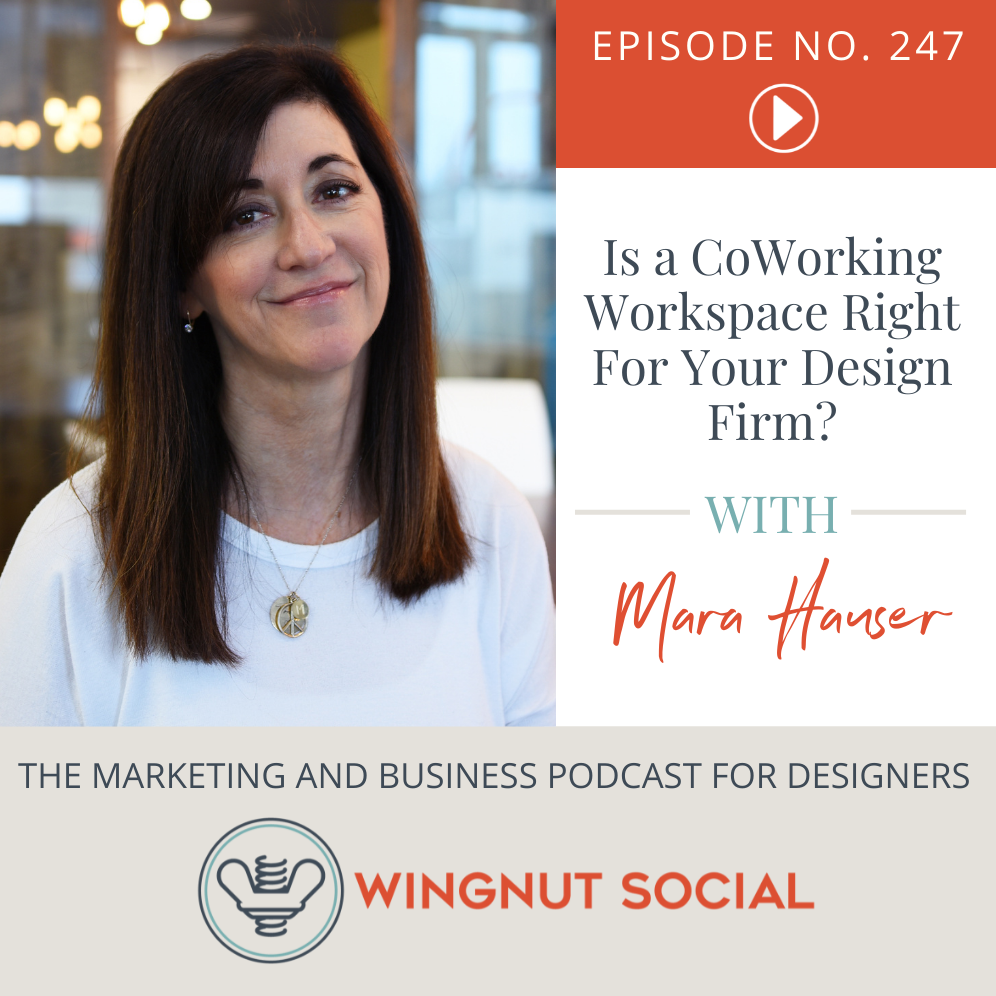
Is a CoWorking Workspace Right For Your Design Firm? with Mara Hauser - Episode 247
The pandemic shutdown sent so many of us home to work but designers were a bit ahead of that curve, generally speaking, since many worked from home already. But regardless how we got there, home can become a bit lonely and distracting when it comes to productivity and accomplishment. How do you deal with it? Mara Hauser says a CoWorking space may be your solution. Mara is a designer herself. She guides her client’s big ideas into executable designs that focus heavily on brand-building and high-level analysis, including programming, product and amenities mix, adjacency diagrams, and determining “who you serve.” But she’s also CEO of 25 North CoWorking Spaces and understands the powerful benefits a coworking space can be to anyone, including designers and their teams. On this episode we discuss the possibilities, how to make the transition, how to benefit the most from involvement at a CoWorking space, and more. Listen up, Wingnuts!
What You’ll Hear On This Episode of Wingnut Social
[1:02] This episode’s topic: Gettin’ out of the house!
[2:48] The Mini-News Sesh!: Facebook profiles can become professional profiles
[6:51] Who is Mara Hauser?
[11:09] Is the trend toward home-working going to continue?
[13:12] A hybrid work approach interior designers may be able to use
[20:08] How large of a design firm could use this model?
[22:20] How important is the design aspect of a coworking or office space?
[25:22] Mitigating the sense of anxiety that can occur making this transition
[30:15] Reasons you will benefit from utilizing a coworking space
[33:20] The WHAT UP WINGNUT? round
Connect with Mara Hauser
25 North Coworking Spaces - Mara’s company
Workplace Studio Interior Design - Mara’s design studio
Follow Mara on Twitter
Resources & People Mentioned
BOOK: Shoe Dog by Phil Knight
Wingnut episode with Rex Rogasch - Hospitality Design
The Advantages and Disadvantages of Working From Home
If you’ve worked at home, you know the pain. Fido is barking outside your door. The cat walks across your keyboard when you’re out of the room. Netflix is right out there in the living room, beckoning you to continue your latest binge. These are some of the irritations but there are also limitations. It’s hard to host professional meetings at home, especially with clients. It’s also problematic to have your team work out of your home without turning your street into a used car lot every day. Mara says these are exactly the things a CoWorking space is designed to solve. Listen to learn if a CoWorking option is a good fit for you. You might be surprised how adaptable and collaborative it could be for you and your team.
Multipurpose spaces are massively important in your working space and the CoWorking space you choose
Most designers understand the principles behind good design (of course), so they get the realities around spaces designed to serve specific purposes. That reason alone may have you on the skeptical side of the fence when it comes to using a CoWorking space. But it doesn’t have to, especially when it comes to Mara’s locations. Being a designer, she’s done everything in her team’s power to create flexible spaces that can be transformed into what each client needs. They utilize casters to move things around and remake the space. The lighting, HVAC, and amenities are provided with comfort and productivity in mind. They also include outdoor work and meeting spaces to enable teams to make the most of fresh air and natural surroundings. If you were to visit one of her locations you would be impressed with the flexibility and effectiveness of the spaces she’s created. Listen to this episode to learn if a CoWorking space is right for you and your team!
Connect With Darla & Wingnut Social
www.WingnutSocial.com
On Facebook
On Twitter: @WingnutSocial
On Instagram: @WingnutSocial
Darla’s Interior Design Website
Check out the Wingnut Social Media Lab Facebook Group!
1-786-206-4331 (connect with us for your social media marketing needs)
Subscribe to The Wingnut Social Podcast on iTunes, Google Podcasts, or TuneIn
Audio Production and Show notes by
PODCAST FAST TRACK
https://www.podcastfasttrack.com
40:1212/01/2022
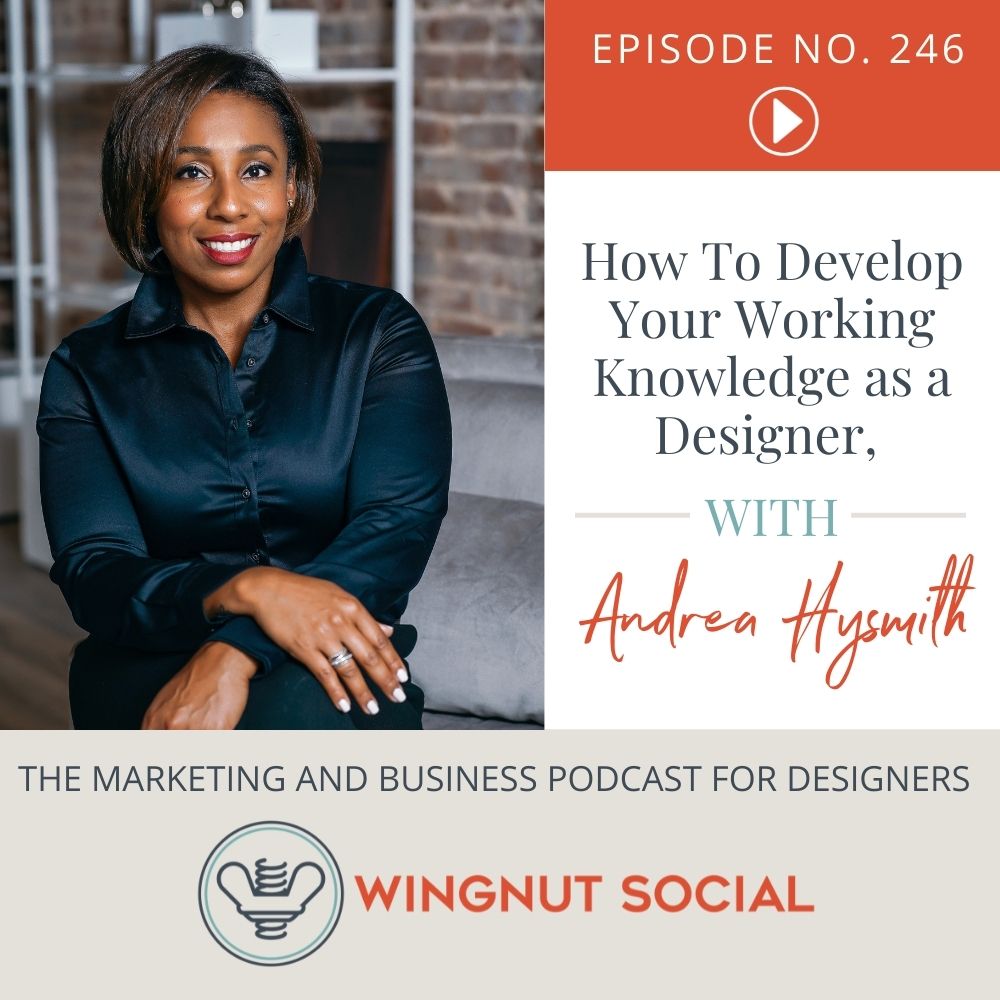
How To Develop Your Working Knowledge As A Designer, with Andrea Hysmith - Episode 246
One of the many challenges for up-and-coming designers (and those of us who have been in the industry for a while, too) is in the area of “working knowledge.” There’s a LOT to know and it seems like nothing but time is going to help you know it. But the guest on this episode proves that even though she’s been in the industry for over 20 years, there are clear things you can do to accelerate your learning curve.
Andrea Hysmith of A.S.H. Designs (in Ellicott City, MD) is an Interior Specialist, Kitchen and Bath Designer, Manufacturer Representative, Speaker, and Presenter, and has been sharing her knowledge of luxury design for over 20 years. She focuses on residential and light commercial spaces and recently opened her own design space in Ellicott City as the first woman of color to do so. She’s a hard-working, hustling woman who has done the work necessary to educate herself about her craft, all for the sake of serving her clients with excellence. You’ll learn a lot about developing your own working knowledge, faster, from her intentional approach, so be sure you listen.
What You’ll Hear On This Episode of Wingnut Social
[0:42] Where I’ve been… answering the common question, “Why the break???”
[2:09] The Mini-News session: Instagram Reels (reply with another reel)
[5:16] Andrea Hysmith: Designer extraordinaire
[13:04] The movement to curate antiques and how Andrea got into it
[21:25] What is “Certified Aging in Place?”
[28:27] How did Andrea become an independent manufacturer rep?
[36:58] Why it’s important to be true to yourself as you being your design career
Connect with Andrea Hysmith
Andrea’s company: ASH Design in Ellicott City, MD
Andrea on Instagram
Resources & People Mentioned
Andrew Joseph
Toma Clark Haines
Certified Aging In Place Specialization
T.D. Jakes
Highpoint Market
What They Don’t Teach You In Design School Facebook Group
BOOK: Wild by Cheryl Strayed (affiliate link)
Taking a proactive approach to design by getting into the trenches
It’s easy to feel that you are handicapped when you need to know more about a specialized area of design but simply don’t. Andrea never let that stop her. She’s a “go get it” kind of woman. She takes the initiative to find the resources and open the doors that will provide her with the knowledge she needs — and you can do the same.
For example, at one point in Andrea’s career, she needed to know more about custom cabinetry so she reached out to establish a relationship with a custom cabinet builder and worked shifts in his facility to learn what she needed to learn. She’s done the same with painters, a plumbers, and other specialized tradesmen, all for the sake of educating herself at the source. Though it may seem that’s a lot of irons in the fire, Andrea says it’s all cohesive if you keep things integrated within a common goal or mission.
Special certifications can help you stand out in a crowded area
Andrea holds a special certification that Darla had never heard of. The National Association of Home Builders offers a “Certified Aging in Place Specialist” certificate and Andrea is one of those who have completed the course they offer. It’s a specialty in the design and refurbishment of homes to enable those who are aging or otherwise disabled to continue to live in their homes rather than having to move.
Andrea says this is especially important to her because she has clients who have been with her for many years. Her certification enables her to serve them in new, fitting ways as they age and the relationship continues. She’s also had people reach out to her specifically because she holds the certification, and at one community event a realtor who works primarily in retirement communities asked if Andrea would serve as a recommended service provider for those the realty group serves. Are there certifications that would serve the community where you work or the clientele you specialize in serving? If so, go get them!
Connect With Darla & Wingnut Social
www.WingnutSocial.com
On Facebook
On Twitter: @WingnutSocial
On Instagram: @WingnutSocial
Darla’s Interior Design Website
Check out the Wingnut Social Media Lab Facebook Group!
1-877-WINGNUT (connect with us for your social media marketing needs)
Subscribe to The Wingnut Social Podcast on iTunes, Google Podcasts, or TuneIn
Audio Production and Show notes by
PODCAST FAST TRACK
https://www.podcastfasttrack.com
47:0305/01/2022
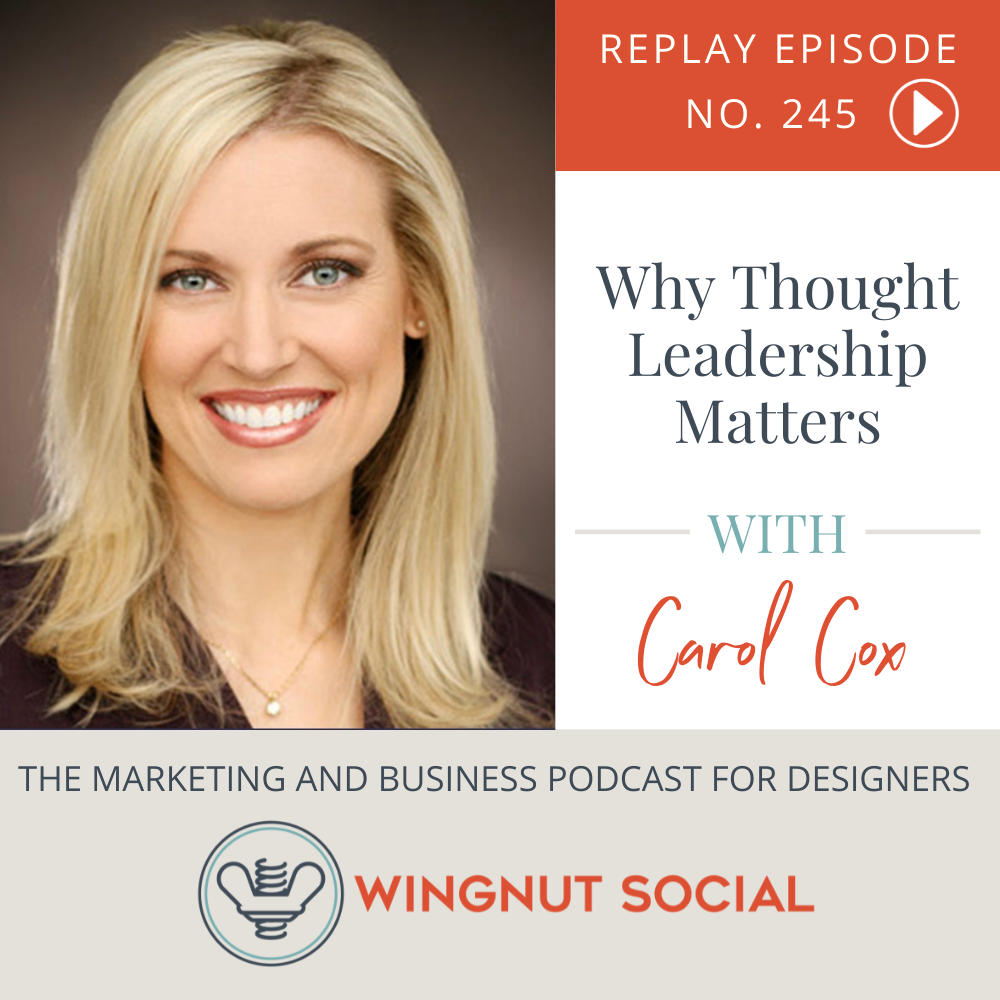
Carol Cox Shares Why Thought Leadership Still Matters - Episode 245
Carol Cox is the founder of Speaking Your Brand®. Her mission is to help women create thought leadership platforms to have the impact they desire in their field. But how do you get to that point? Is becoming a thought leader worth the time and effort? In this episode of Wingnut Social, Carol speaks about the power of sharing your personal experiences, what container you should use for your thought leadership, and the basics of her VOICE method. Don’t miss this awesome replay.
1v7P9R7TkavQBnV12gvh
43:5601/12/2021
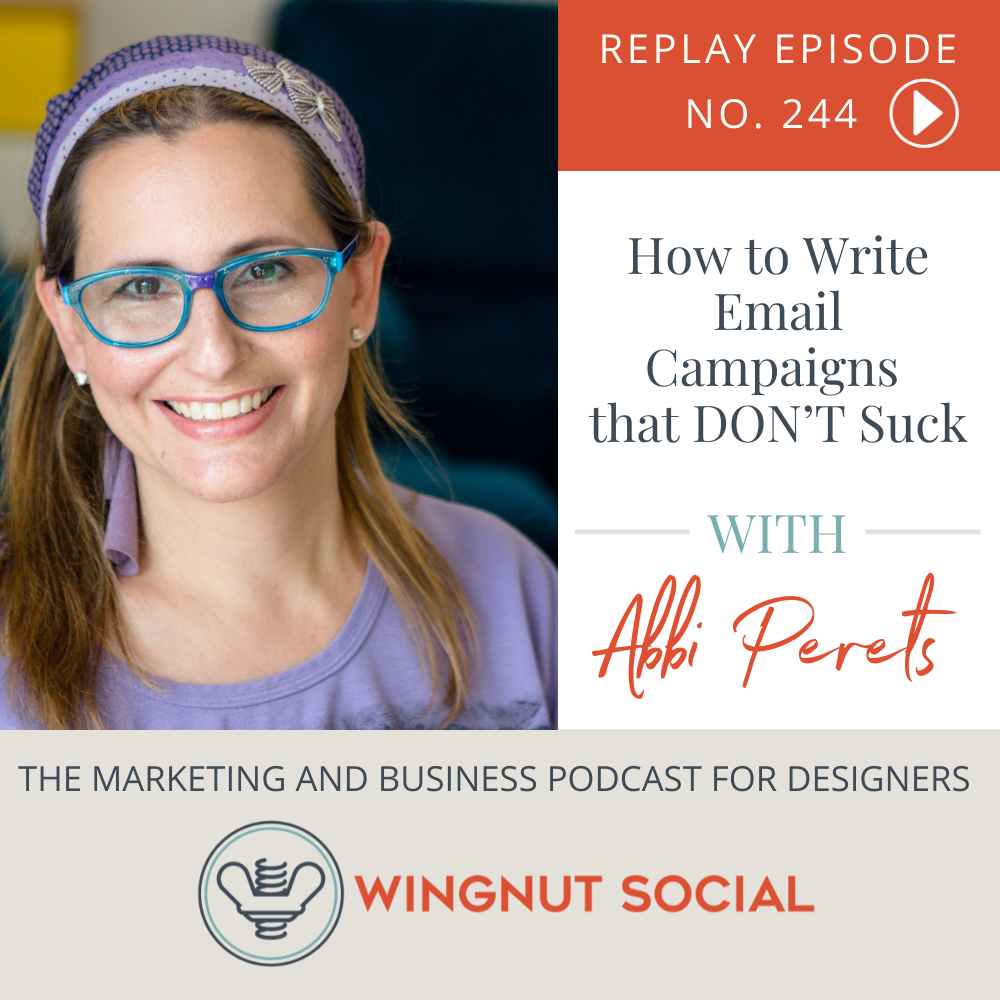
Abbi Perets: How to Write Email Marketing Campaigns that Get Read - Episode 244
What does a successful email marketing campaign look like? How do you get people to read your emails and not just immediately trash them? Abbi Perets—The founder of Successful Freelance Mom—shares the secret to her successful email campaigns in this special replay of the Wingnut Social podcast! She’ll cover her TWO big rules, what makes people open emails, and why it’s important for there to be a purpose behind your content. Don’t miss it!
42:3224/11/2021
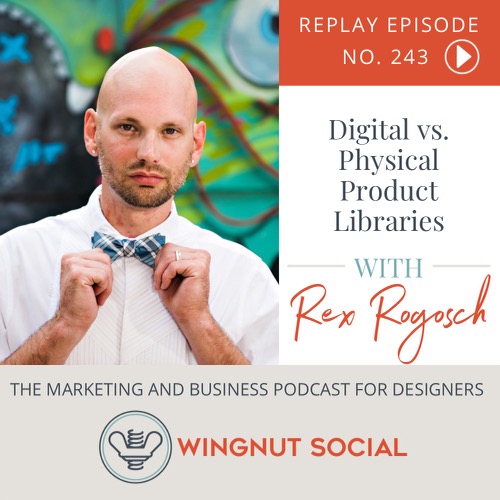
Digital vs. Physical Product Libraries: Rex Rogosch Weighs In - Episode 243
With over 20 years of experience in the design industry, Rex Rogosch knows a thing or two. In his expert opinion, digital product libraries are the way of the future. Sourcing online is a breeze and many clients already have Pinterest boards plastered with the furniture and pieces they love. But is there still a place for physical product libraries? Are you ready to transition to a digital library? Learn more from Rex in this Wingnut Social Replay!
36:2517/11/2021
![REPLAY: Up-Level Your Social Media Marketing with Pinterest [Kate Ahl] - Episode 242 REPLAY: Up-Level Your Social Media Marketing with Pinterest [Kate Ahl] - Episode 242](https://pbcdn1.podbean.com/imglogo/ep-logo/pbblog3132020/999A5FB9-B429-49C7-90B3-039F1939E7CB.jpeg)
REPLAY: Up-Level Your Social Media Marketing with Pinterest [Kate Ahl] - Episode 242
When it comes to social media, Instagram gets a lot of the focus these days. But you can’t forget how successful Pinterest can be for interior designers. So in this Wingnut Replay, you’ll get to revisit episode #218 with none other than Kate Ahl—Ahl about boosting your social media marketing with Pinterest. Check it out!
37:5010/11/2021
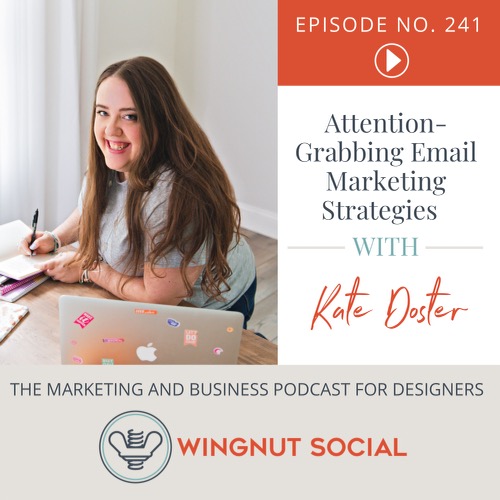
Kate Doster’s Attention-Grabbing Email Marketing Strategies - Episode 241
Is email marketing still relevant? How do you grow and nurture your email list? How important are lead magnets? These are just a few of the many topics Kate Doster covers in this episode of the Wingnut Social podcast. If you’re struggling to build email campaigns that convert, Kate is the go-to expert. Don’t miss her take!
What You’ll Hear On This Episode of Wingnut Social
[1:24] Mini News Sesh: Facebook Update
[3:40] Learn all about Kate Doster
[4:44] Is email marketing still relevant?
[7:18] How to compose a “Yeah, but…” email
[12:54] The lowdown on email lists
[17:33] How to attract the right subscribers
[20:27] Why you should work with Wingnut Social
[21:31] The importance of lead magnets
[26:13] How to grow and nurture your email list
[29:24] How often to use a call-to-action
[31:51] How the Apple iOS update impacts email
[33:41] The What Up Wingnut Round
[36:16] How to connect with Kate Doster
[40:12] Blooper Reel!
Connect with Kate Doster
The Inbox Besties Podcast
Kate Doster’s Courses
Connect with Kate on Instagram
Follow Kate on Twitter
Resources & People Mentioned
ActiveCampaign
MailChimp
ConvertKit
MailerLite
Year of Yes by Shonda Rhimes
Your emails need to grab someone’s attention
Why is someone going to their inbox? They’re bored, procrastinating, stuck watching their kids boring tv shows—who knows. But Kate knows that people go to their inbox for a hit of dopamine. Because you’re shooting for a dopamine hit, you want to give them a quick tip or anecdote. When people go to their inbox, they want a quick escape.
People think emails need to be a large elaborate story. It doesn’t need to be that. But you do want to make sure your emails are relevant. If someone signs up for Kate’s email list, they get emails about email marketing and sales psychology. If she started talking about her fitness journey to her subscribers, people wouldn't care. They’d unsubscribe.
That being said, you can give them a random piece of information that’s tied back to your topic. You must be entertaining and stay true to your brand. You have to treat your subscribers like they’re one in a million, send relevant emails, and include the hit of dopamine. How can I make this person feel good today? How can I make them interested? How can I get them thinking? Start with an attention grabber.
Kate’s secret sauce: The “Yeah, but…” email
You want to give your subscribers something that answers the, “Yeah, but…” question. Yeah, I want this, but this is in the way. People always have “yeah, buts…” You have to identify what’s holding people back from making a decision. You can then share simple guides that give them the answer to their questions and leave them saying, “She gets me. She understands.”
If someone is truly interested in getting their living room redesigned but can never agree on something with their spouse, you can share a guide that touches on how to mesh two different styles. Think of something that’s holding people back. Listen to hear what Kate’s specific tips for interior designers are!
The importance of lead magnets
If you have an interior design blog and want to share some dupes for a crazy expensive couch, that could be a lead magnet. You want to share an exclusive thing that people can only get if they join your email list. It can be hard to brainstorm ideas, so Kate shares some genius hacks.
If you have a popular and relevant piece of content, upcycle it. If something on social media got a lot of engagement, can you turn it into a PDF? You can use that in an email. It doesn’t have to be reinventing the wheel. Create permanent versions of things that are excelling and offer that as your freebie.
Another pro tip? List out all of the excuses and concerns that people have around what you’re ultimately going to sell. Is it working with an interior designer? Is it sourcing? Is it doing something on a budget? Is it finding high-end dupes? If you aren’t sure, look at 2 and 3-star reviews on Amazon or snoop around in Facebook groups. What are people complaining about? When you address the “Yeah, but...” that someone has, it works. It all comes from knowing your ideal client. You want someone to say, “How did you know that’s what I needed?”
Connect With Darla & Wingnut Social
www.WingnutSocial.com
On Facebook
On Twitter: @WingnutSocial
On Instagram: @WingnutSocial
Darla’s Interior Design Website
Check out the Wingnut Social Media Lab Facebook Group!
1-877-WINGNUT (connect with us for your social media marketing needs)
Subscribe to The Wingnut Social Podcast on iTunes, Google Podcasts, or TuneIn
Audio Production and Show notes by
PODCAST FAST TRACK
https://www.podcastfasttrack.com
40:3303/11/2021
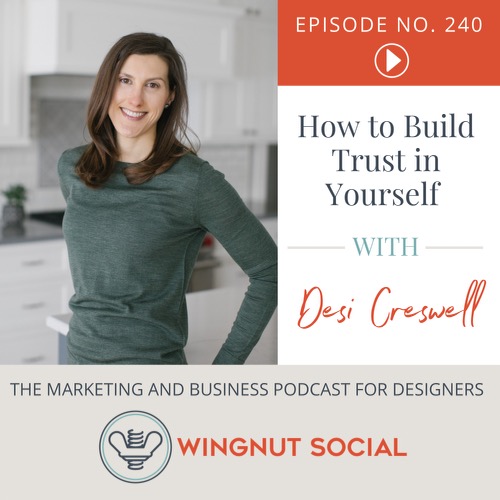
Business Coach Desi Creswell Shares How to Build Trust in Yourself - Episode 240
Desi Creswell is a business coach who specializes in working with interior designers. As a coach, Desi doesn’t tell you what to do. She asks high-quality questions to help you uncover what you know to be true for yourself that aligns with what you want to create for your business. As she draws that out of you, you will learn to do it for yourself.
In a coaching relationship, you tend to view your coach as a parental figure—someone who has all the answers and knows what’s best. But Desi doesn’t want her clients to solely rely on her for decision-making. She wants to equip her clients with the tools to make empowered decisions about their own businesses. That starts by learning to trust yourself. She shares why this is so important in this episode of Wingnut Social!
What You’ll Hear On This Episode of Wingnut Social
[0:49] Brought to you by Wingnut Social!
[2:05] Mini News Sesh: IGTV is no more
[5:13] Learn to ask yourself quality questions
[9:24] How to determine when you need help
[12:18] Why you need to trust your gut
[18:39] How Wingnut Social can help YOU
[20:24] How to navigate mastermind groups
[23:01] How many opinions should you seek out?
[32:00] Desi’s What Up Wingnut answers!
[34:47] How to connect with Desi Creswell
[38:20] Blooper Reel!
Connect with Desi Creswell
Desi’s Coaching Website
Get on Desi Creswell’s Coaching waitlist
Take back control of your day with Desi’s Daily Planner
Have a conversation with Desi on Instagram
Connect with Desi on LinkedIn
Resources & People Mentioned
Episode #172: Desi Creswell Shares How to Cultivate a Healthy Mindset
Effortless by Greg McKeown
Why you need to trust your gut
If you’re researching between project management tools, you talk to people who use the systems to see how the product works for them, right? Does it do what it needs to for their business? What are the best parts of the software? Ultimately, you have to make the decision. But you may continue to find yourself asking questions, hoping someone else makes the decision for you. The problem becomes that you’re seeking something externally that you need to provide for yourself internally.
The struggle is that as soon as you make a decision, there’s something at stake. It can be scary. You may question your decision or get an outcome you didn’t like. The #1 reason people don’t want to make a decision is that they’re afraid of the backlash they’ll get from themselves if they make the “wrong decision.” Will you beat yourself up? The truth is that you will make bad decisions—in life and business. So how will you handle it?
Build trust in yourself by taking baby steps
Desi suggests practicing decision-making with little things. Trust yourself in the little decisions, even something as simple as what you’re eating for lunch. It allows you to build the muscle and apply it to bigger decisions. Then, once the decision is made, trust that you made the right decision no matter what unfolds afterward.
You can decide that there are no bad decisions. There are just decisions that you make, you get results from them, you learn from them, and you move on. When you allocate the responsibility to someone else, you’re blaming them for the outcome. You have to take responsibility for the results of your decisions.
But it all starts with getting out there and doing it. You’ll have some things that won’t work out how you think they should. For example, when Darla launched Wingnut Premium, it didn’t take off how Darla expected it to. So she pulled the plug. It was an experiment that she chose to do that didn’t work out as planned and that’s okay. Darla is moving on to bigger and better things. Darla actively chose not to see it as a failure but a learning lesson.
Connect With Darla & Wingnut Social
www.WingnutSocial.com
On Facebook
On Twitter: @WingnutSocial
On Instagram: @WingnutSocial
Darla’s Interior Design Website
Check out the Wingnut Social Media Lab Facebook Group!
1-877-WINGNUT (connect with us for your social media marketing needs)
Subscribe to The Wingnut Social Podcast on iTunes, Google Podcasts, or TuneIn
Audio Production and Show notes by
PODCAST FAST TRACK
https://www.podcastfasttrack.com
38:4327/10/2021

How Brett + Giselle Sugerman Found Phenomenal Success on Instagram - Episode 239
Brett + Giselle Sugerman are the super-couple behind B&G Design Inc., an award-winning Miami-based interior design firm. They’ve been featured on NBC, CBS, and HGTV—true movers and shakers in the industry. They share their design expertise across multiple social media platforms and have 57,000 followers on Instagram alone. In this episode of Wingnut Social, they share how they’ve found success with their marketing endeavors.
What You’ll Hear On This Episode of Wingnut Social
[2:09] Mini News Sesh: Instagram Favorites
[4:14] Learn more about Brett and Giselle Sugerman
[8:52] How they learned from their mistakes work-life balance
[12:06] Advice for couples going into business together
[16:11] Their phenomenal success with Instagram
[23:30] Learn more about B&G Unfiltered
[26:16] Curated authenticity on social media
[33:10] The What Up Wingnut! Round
[34:30] How to connect with Brett and Giselle
[38:25] Wingnut Social has some openings!
[39:31] Blooper Reel!
Connect with Brett Sugerman + Giselle Loor-Sugerman
B+G Design
B+G Design on Instagram
B+G Design on Facebook
Brett’s Music on Spotify
Resources & People Mentioned
How to Balance your Marriage + Business + Self [with LMFT Amber Hawley]
The Celestine Prophecy by James Redfield
One Hundred Years of Solitude by Gabriel Garcia Marquez
How they found phenomenal success with Instagram
Originally, when Brett and Giselle started marketing on social media, it was trial and error to see what worked. Right now, their brand is a lot of people working together to make things happen. They continuously change and evolve depending on what’s happening in the world. What’s helped them a lot? Promoting their posts. They are always tweaking their audience and age groups and analyzing the results. What photos did well? Did before and after slides do well? Did supporting stories or reels help with engagement?
Giselle emphasizes that it’s important to stay true to who you are and who you are as a brand. People want to know the person and the personality behind the brand. What inspired you? What is your life about? So they build their life into their social media to show their interests. Showing your personality means that more of your ideal clients will connect with and seek you out. Their tactics are obviously working, right? 57,000 people follow them on Instagram alone and that’s no easy feat.
Curated authenticity on social media
Whatever you’re sharing on your social media, make sure it’s descriptive of your life and your business. They post standard before and after photos to show design transformations. Giselle loves styling their home for the holidays and building tablescapes. They also share their high-end luxury designs. Through it all, they intermix content that shows who they are.
They emphasize that if you’re trying to build a following, you must also tag and give credit to everyone involved in a project. It will open up your audience. There is plenty of business to go around and you can’t be afraid to share your expertise with others. They embrace the mantra “Share the love.”
Another tip? Be consistent with posting and sharing. Be true to your aesthetic. Don’t be afraid to show who you are as a designer and an individual. Be true to who you are because there truly is an audience for everyone. Try to stand out and be unique because people are looking for different things. People can taste authenticity.
Giselle and Brett also take a deep-dive into how they’ve found success building a successful business while balancing life as a married couple with a family. Don’t miss this episode!
Connect With Darla & Wingnut Social
www.WingnutSocial.com
On Facebook
On Twitter: @WingnutSocial
On Instagram: @WingnutSocial
Darla’s Interior Design Website
Check out the Wingnut Social Media Lab Facebook Group!
1-877-WINGNUT (connect with us for your social media marketing needs)
Subscribe to The Wingnut Social Podcast on iTunes, Google Podcasts, or TuneIn
Audio Production and Show notes by
PODCAST FAST TRACK
https://www.podcastfasttrack.com
39:5620/10/2021
![Pivot Your Business with a Strategic Business Coach [Like Michele Williams] - Episode 238 Pivot Your Business with a Strategic Business Coach [Like Michele Williams] - Episode 238](https://pbcdn1.podbean.com/imglogo/ep-logo/pbblog3132020/C7AED0B4-15BB-4AE5-964B-BB8235AFEB22.jpeg)
Pivot Your Business with a Strategic Business Coach [Like Michele Williams] - Episode 238
Michele Williams is a strategic business coach who works with designers to help them create a strategic focus for their business, finances, and all decision-making. She firmly believes when you have a clear idea of where you want to go, you can get clear steps forward in place. She empowers business owners to take back the reins.
When Darla came to Michele, she was struggling through a messy divorce while managing a full-time design business, Wingnut Social, and a podcast. Darla was ready to break and felt out of control. How was Michele able to guide her through her next steps? What did Michele do that helped Darla reclaim control of her businesses? How can she help you, too? Listen to this episode to learn more!
What You’ll Hear On This Episode of Wingnut Social
[4:37] Mini News Sesh: Content Facebook likes
[8:40] Learn more about Michele Williams
[13:37] What makes your heart beat?
[26:32] Check out Build Lane for custom furniture!
[28:00] Get on Wingnut Social’s waitlist—you won’t regret it
[29:42] How to find the right coach for you
[32:00] How to pivot if you can’t afford a coach
[43:43] The What Up Wingnut! Round
[47:26] Blooper Reel!
Connect with Michele Williams
Scarlet Thread Consulting
Profit Is a Choice Podcast
Scarlet Thread on Facebook
Scarlet Thread on Instagram
Michele on LinkedIn
Resources & People Mentioned
Capasso Interiors (Get a 15% discount on your first retainer with the Code DARLA15 until October 21st)
Creating a Sustainable Design Business through Profit First with Michele Williams
The Vision Driven Leader by Michael Hyatt
How to decide what you love—and what you can live without
Darla was running three businesses—the design business, the podcast, and Wingnut Social. Far too much for one person to handle. None of the businesses could function without her in them. What was her first step? Michele told her to take a step back, pull her head out of the day-to-day, and decide what she loved doing.
Michele emphasizes “Stop building businesses that you don’t like. Stop building businesses that drain you. Stop building businesses that ask more than you’re willing to give. Start building businesses that you love with an intention and with a strategy.” That’s what Michele helped Darla work through.
Which business did she want to put her time and attention into? What made her heart beat faster, that she felt passionate about? What wouldn’t she regret losing? Michele notes you must “Clear everyone else’s voice and hear yours.” You can’t make a business profitable if your heart isn’t in it.
Michele isn’t there to make you a better designer, social media expert, or podcaster. She is there to help her clients run their businesses and make them better business owners. You develop a great business by having a strategy that leads to goals that lead to a plan. It becomes a framework for decision-making. The strategy allows you to say “yes” or “no” and not feel guilty about the decisions you’re making.
How to pivot your business if you can’t afford a coach
Michele says the first step is easy: find someone you trust and consume all of the free information you can from them. Michele—and most coaches out there—offer some sort of free resources. Michele has a weekly podcast (Profit is a Choice) that shares 100% free content. She produces newsletters with actionable tips. You can write down takeaways and start using the free advice that coaches share.
Michele has met numerous people who’ve listened to her for years, implemented everything she’s recommended, and got to a place where they could hire her. What else can you do? Invest in courses. Courses can help get you where you want to go so you can make enough money to do the next thing.
Are you pivoting in your business because you want to—or someone told you that you have to? You need some understanding of why you need to pivot. Then you need to decide to pivot in a direction that will make you happy and joyful. You create a strategic plan and vision of what could be. Then you put one foot in front of the other and gain clarity.
When you’re creating a vision, Michele emphasizes that you have to believe that the best is yet to come. If you’d like someone to guide you along the way, reach out to Michele today!
Connect With Darla & Wingnut Social
www.WingnutSocial.com
On Facebook
On Twitter: @WingnutSocial
On Instagram: @WingnutSocial
Darla’s Interior Design Website
Check out the Wingnut Social Media Lab Facebook Group!
1-877-WINGNUT (connect with us for your social media marketing needs)
Wingnut Social Podcast Sponsor: Build Lane
Looking for a great custom furniture option? Check out Build https://buildlane.com/
Subscribe to The Wingnut Social Podcast on iTunes, Google Podcasts, or TuneIn
Audio Production and Show notes by
PODCAST FAST TRACK
https://www.podcastfasttrack.com
47:4213/10/2021





